version 0.66 💀

This is still a work in progress! While absolutely playable, there's some content missing. Check the roadmap for more information. If you have questions or any kind of feedback, feel free to join the Discord channel or the Reddit group.
Welcome
Dead Weight takes place in a low-fantasy world - it's very grim and dark but doesn't take itself too seriously. But be advised that Dead Weight has some horror elements, and may not be suitable for everyone.
The player characters are no heroes; they are dead weights - outcasts and treasure hunters with little to lose. They delve deep into long forsaken places, struggling not only with the horrors that lurk there, but also their fatigue, stress, and the gradual decay of the few resources they bring. All in hopes to save enough silver to leave Blacksalt Island for better days elsewhere.
This system has a strong structure to it - focusing on light roleplay and on dungeon crawling. Light roleplay doesn't mean there's no support for it - quite the contrary - it's just that the game system should be fun even if your group doesn't like to roleplay a lot.
Blacksalt Island
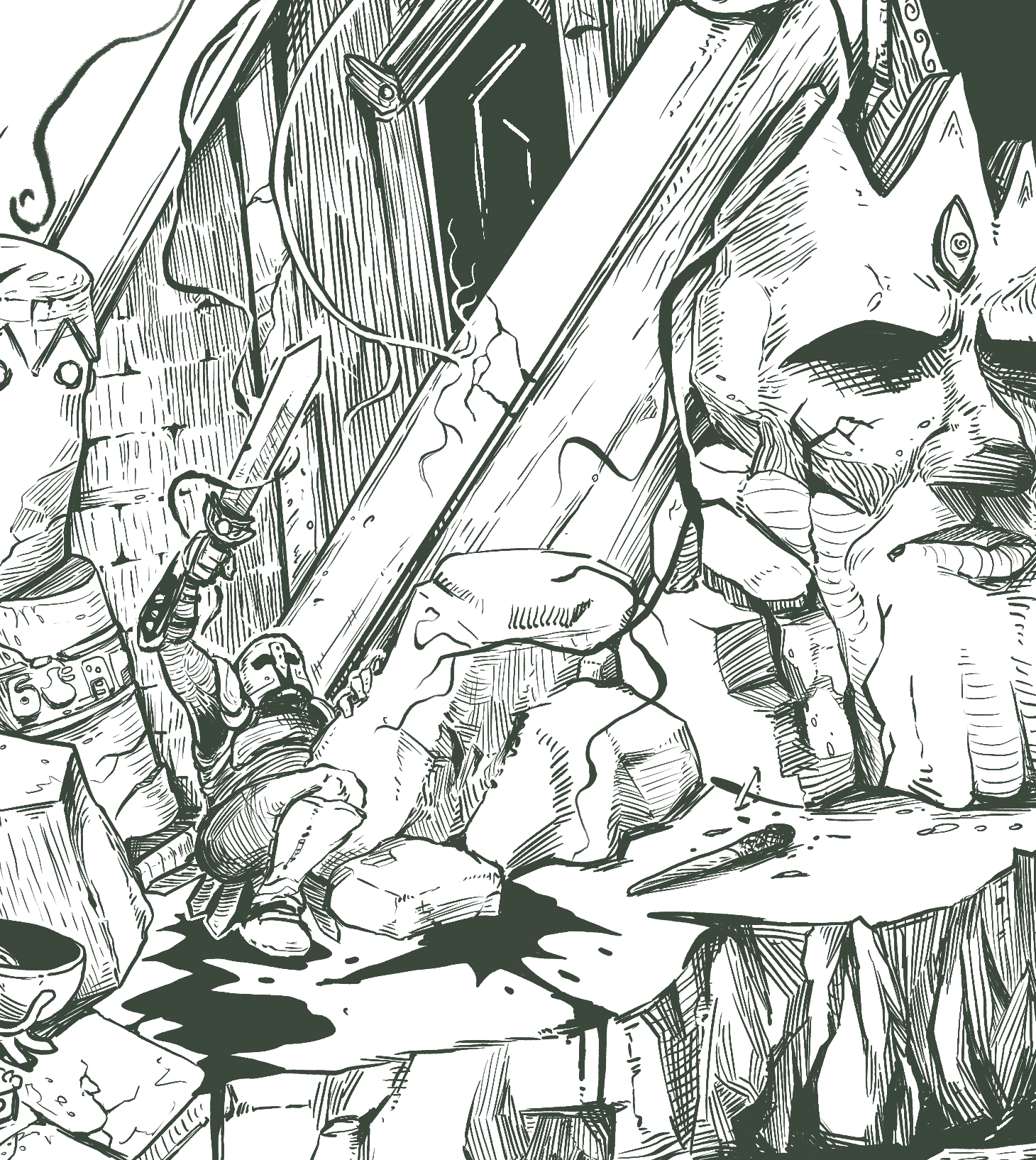
This game takes place in Blacksalt Island, and it's a dreadful place. A once-great kingdom, Blacksalt Island has been ruined by famine, war and plague long, long ago. When things were already dire, the dead vigil started. No one knows exactly why, but every single human that dies in the island rises up as a hungry undead. The island was mostly abandoned for many years, but was recently rediscovered. Treasures and arcane relics found in the tombs sparked a "gold rush" of sorts, with people far and wide venturing there to earn some silver.
Now, the island is divided into dungeoneering guilds, each claiming rights to raid certain ruins. They allow adventurers to explore them and even assist them with supplies, as long as they receive a cut of any treasure found.
Blacksalt Island is a big place, with multiple cities on the shore, hastily built for this exploration venture and a few villages in its core. Of the original inhabitants, very few are left, but some fiefs and hamlets still date back to the time of the old kings.
The ruins are filled with the undead, and the newcomers seem to only add to their numbers. Humanoid creatures also live there, mostly hidden in the shadows and in the forests, like the child stealing goblins and the grotesque gnolls.
Unlike many fantasy worlds, your character is no hero. Quite the contrary, you are someone at the end of the line. Maybe your days of glory are long gone and mostly likely they never came. In one way or another, you don't have much to lose - and that's what brings most people to Blacksalt Island.
You arrived at the island hoping to find something - maybe treasure, maybe some lost artifact, maybe a glorious death.
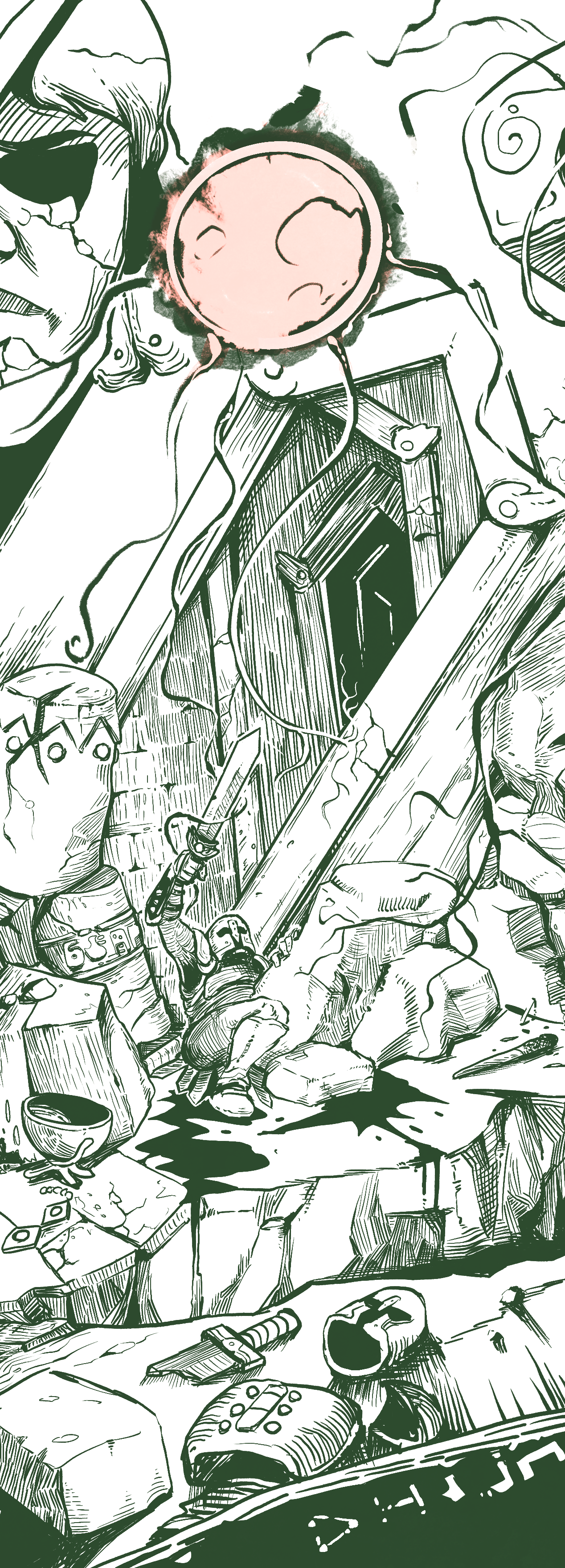
What you will need
Dead Weight is designed with both online and offline play in mind. This rule book has links and a structure optimized for reading online and on mobile, so it's easily accessible to all players. This game is best played with 4 players but you can play with more or fewer depending on your play style. The system is also designed to be roleplay light, meaning it will be fun even without heavy roleplaying, but, if your group likes to roleplay, it also supports that, adding a whole new layer to the game.
For simplicity, the rules are broken up in different books:
- Core Rules: This book covers all the important rules and basic information on how to play and create characters.
- Bestiary: A list of monsters and enemies for the adventurers and their respective stats and lore.
- Blacksalt: A lore guide about the island and the world of Blacksalt, gods, settlements and locations.
- Quick Reference: A compilation of the most used tables. It's useful to have this open on your phone or on a different tab while playing.
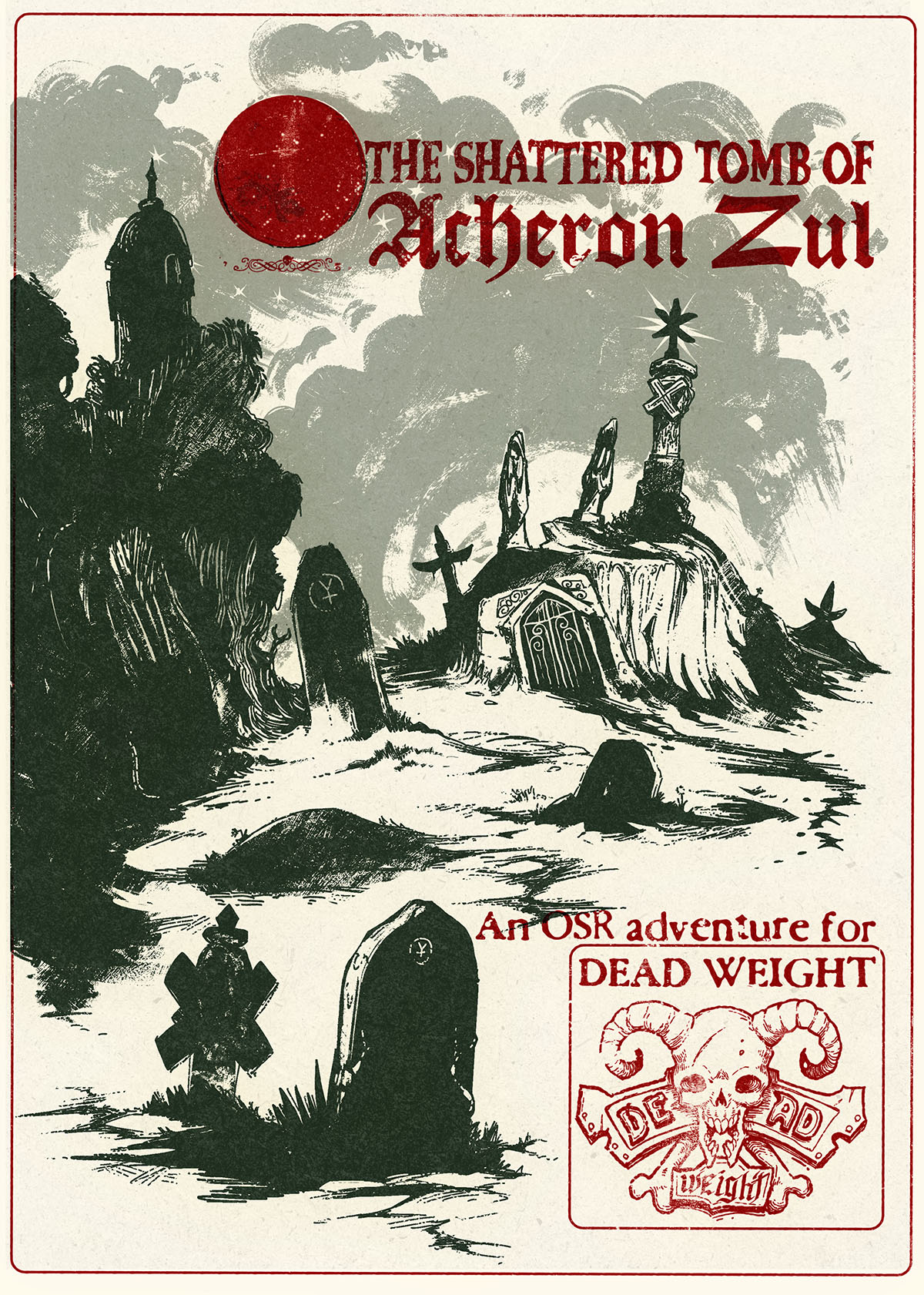
- Sample Dungeon: Players should NOT read this, only the GM. A sample dungeon for a first adventure.
If you've never played a tabletop RPG before, check this video for a basic explanation.
For online play you will need:
- Some voice and text chatting software like Discord or similar.
- A robust online dice rolling software that allows rerolling, like Dead Dice, a dice rolling app I made just for this system. Dead Dice also automates the player's character sheet.
- A virtual tabletop, the simpler the better. I highly recommend Owlbear Rodeo.
- A copy of the character sheet for each player, digital or printed, as the player wishes.
For playing offline you will need:
- You can get a print-optimized version of this page too. We provide in two formats A4 and Letter. (work in progress)
- Pen and paper for everyone.
- A copy of the character sheet for each player, digital or printed, as the player wishes. For digital, the players may use Dead Dice on their phones.
- As many 6-sided die as you can find - ideally 3 per player. Can be played with fewer dice, but it slows the game down. Alternatively, the players may use Dead Dice on their phones.
- A set of RPG dice with a d4, d6, d8, d10, d12 and d20. These are not used very often, so a mobile app can do the job if you don't have these.
- Coins, beans, or anything that can be used as tokens. There are 3 types of tokens: stun, shield and dodge.
- Miniatures or some kind of pawns. Each player will require one and the GM will require some for the enemies. They should be easily identifiable.
About
The goal of Dead Weight is to capture the classic feeling of dungeon crawling tabletop RPGs and board games. It is inspired by many others, borrowing a lot from Blades in the Dark, HeroQuest (the board game), Forbidden Lands, Knave, The Black Hack and Torchbearer.
This system is open source(https://github.com/saint11/DeadWeight) and is released under the Creative Commons Attribution license: you are free to hack, copy, change and even sell works derivative from this system, as long you give proper attribution. The Dead Weight logo cannot be used without express permission, though.
This game was designed and illustrated by me, Pedro Medeiros.
With contributions from:
- Kyle Szklenski(@KyleTheCoder)
The Basics
Let's go over the basics of the system. After that, I recommend that you try to create your first character.
Game Master
One of the players is the game master, which in this book will be abbreviated as GM. The GM is like a narrator and plays all the non-player characters, guides the outcomes of the player actions and creates the details of the world.
The game master has the game master sheet, just like the players.
Players
Everyone else is considered a player. Players each have a character that they roleplay; they will choose the actions of that character and try to keep them alive and move towards that character's objectives.
Adventurers
Characters in Dead Weight are people who either lost everything or didn't ever had anything to begin with - misfit adventurers willing to risk going into the deep vaults of Blacksalt Island to find precious treasures and artifacts while risking their lives and their sanity. There are no heroes in Blacksalt Island.
Characters will level up between expeditions and eventually retire, if everything goes well. Characters can also find an untimely end by something horrible in the depths of the island.
In this book, we will often say adventurers when referring specifically to player characters.
Game Session
This game played in sessions, which can last at least one hour and up to four hours - it depends on the play style of your group. Each game session is structured in 2 distinct states: the expedition and the interlude - delving into a terrible place or recovering and making plans for the next expedition. The players may choose from a list of actions depending on the current game phase. Depending on how much roleplay your group likes, the interlude phase may be simplified or not.
Ok, how do I start?
First, decide who will be the game master and who are going to be the players. The game master should ideally read this whole rule book, including the sample dungeon in the end. It is recommended that the players read at least the Core Mechanics after creating the characters, but it's not required. Players should not read the sample dungeon, or they will spoil the adventure.
Then, each player should create a character; follow the Character Creation chapter for more information.
The GM should also fill the game master sheet to set the tone of the world.
At the end of this book, there's a sample dungeon to help the GM get started. The players should not read that section.
After that, the adventure starts! It is recommended to start on the expedition, with the adventurers right outside the dungeon entrance, choosing how they will enter. If you want, you can also start in a village, or city - it's entirely up to you.
Character Creation

Let's start by creating your character - don't worry too much about the rule system for now, just follow the steps from this chapter and choose what you think sounds most exciting. If you really want to know the rules before doing this, you can skip ahead and come back after you've learned the rules.
Every character starts their life with 1 insight point, which they can use to re-roll one or both dice of a life path roll. Some life paths will give you more insight, and later in the game, insight will be used to level up your character. When playing with a group, if your character has the same life path as another character in your party, each player may, only once, roll again without spending insight.
When you complete the last step of your character, you can immediately spend any insight you have left, without even placing it on the character sheet. That is recommended, since you can only earn a limited amount of insight during the whole lifetime of your character. You can see how to spend insight in the playing the game book.
Each step will add and remove attribute points, equipment, and other things to your character. Place them in the appropriate place in your character sheet.
If you get the same skill twice, upgrade it instead. Feel free to jump ahead to the skills, traits and equipment section to understand what they do.
Print a character sheet or use Dead Dice if you want a digital sheet and let's start! Alternatively, you can also try the character generator for an automatic character.
Adventurers have 4 main attributes. They are noted in the character sheet:
- Strength(STR) is physical strength and constitution of a character.
- Dexterity(DEX) is how fast and precise a character is.
- Intelligence(INT) is how intelligent, wise and keen a character is
- Presence(PRE) is how persuasive and strong-willed a character is.
Each attribute has 2 values, score and proficiency. The former is the natural ability and endurance with the attribute, the latter is how well-trained the adventurer is in that particular field. In the character sheet, the square area is for the score and the circle is for the proficiency.
All attributes scores start at 1, while all attribute proficiencies start at zero.
Attributes scores can not go lower than 0 or higher than 3 at any point in character creation - ignore any excess points.
Attribute proficiencies can not go lower than 0 or higher than 2 at any point in character creation - ignore any excess points.
By default, characters start with a belt, canteen and a bag. You also have a few starting items:
- 1d6 torches
- 1 ration
- On 3d! (Risk dice), 1 camping supply
- On 2d!, 1 bandage
- Your class's start items. See Choose your class below.
If no one got a camping supply, someone in the group may receive one.
1. Roll your infancy
Your infancy will provide a base for your attributes and for your formation.
| 3d6 | Infancy | Effect |
|---|---|---|
| 3 | Tossed in the Pit: Rejected by everyone, even by death. | rejected by death (trait), +1 insight |
| 4 | Blacksalt native: Blacksalt is a terrible place, but you know how it can be good, too. | +1 DEX, loremaster (skill) |
| 5 | Occultist’s Apprentice: Raised by an occultist and trained in the arcane arts since childhood. | +2 INT, +1d6 silver, occult studies (skill) |
| 6 | Born in Exile: Raised far away from civilization. | +1 STR +1 INT, survivalist (skill) |
| 7 | Battleborn: Born in an army during a raging war, forged in violence. | +2 STR, fearless (skill) |
| 8 | Street Urchin: Orphan, raised by other kids. | +1 STR, +1 DEX, street wise (skill) |
| 9 | Caravan Child: Born in a trading caravan; learned to haggle before walking. | +2 PRE, +1d6 silver |
| 10 | Clergy Bastard: Born from a sinful union; learned guilt and prayer before walking. | +1 STR +1 PRE, holy rites (skill) |
| 11 | City Kid: Grew up amidst the chaos of a big city. | +1 DEX, +1 PRE, +1d4 silver, +1 insight |
| 12 | Farmer's kid: Life on a farm isn't easy, but gave you enough to keep going. | +1 STR, cooking (skill), animal affinity (skill) |
| 13 | Lost family: You had to grow up much faster than everyone - your siblings depended on you. | +1 INT, +1 DEX, cooking (skill) |
| 14 | Tomb Dweller: Grew up underground in an underground tomb-city. Quickly learned to stay hidden to survive. | +2 DEX, 2d4 silver |
| 15 | Seaborn: Born on a ship of travelling merchants. | +1 INT, survivalist (skill), +2d6 silver |
| 16 | Feral Kid: Raised by animals in the forest. | +1 STR, +1 DEX, animal affinity (skill) |
| 17 | Blue Blood: Born to a rich family that eventually lost everything. | +1 INT, +1 PRE, +4d6 silver |
| 18 | Born of a dark prophecy: No one knows where you came from, only that it's bad. | +1 of a chosen attribute prof, bad omens (trait) |
2. Roll your previous career
What you did before coming to the Blacksalt Isle.
| 3d6 | Career | Effect |
|---|---|---|
| 3 | Deserter Knight: Die for honor? Not a chance. | +1 STR, +1 STR prof, duelist (skill) |
| 4 | Squire: They said one day you would become a knight; you believed them. | +1 STR, +1 PRE, shield master (skill) |
| 5 | Physician: Not many people know how to actually heal someone; you do. | +1 INT, +1 DEX, surgeon(skill), |
| 6 | Traveling Salesperson: Convincing people that they need something they didn't was your full time job. | +1 INT, +1 PRE prof, haggle (skill) |
| 7 | Temple worker: You worked hard in the temples, body and mind. | +1 INT, +1 STR, holy rites (skill) |
| 8 | Boatman: Your boat was your home and your work. You lost count of how many people and wares you transported. | +1 PRE, +1 STR prof |
| 9 | Watchman: Keeping the streets safe was your job, and it was impossible. | +1 STR, +1 DEX |
| 10 | Charlatan: Outsmarting people and taking advantage of them was your specialty. | +1 INT, +1 PRE, 3d6 silver |
| 11 | Brigand: Joined a gang that robs people in the mountains and forests. | +1 DEX, +1 STR, intimidate (skill) |
| 12 | Common Thief: Stealing, lying and hiding. | +1 PRE, +1 DEX, pilfer (skill) |
| 13 | Pugilist: You gave your audience blood and entertainment. | +1 STR, +1 PRE |
| 14 | Beggar: Living on the streets isn't impossible, if you know your way. | +1 DEX, +1 PRE prof, streetwise (skill) |
| 15 | Builder: Building is all about meticulous planning and heavy lifting. You had to do both. | +1 STR, +1 INT prof |
| 16 | Cook: While there are hungry people, you will always have a job. | +1 DEX, +1 INT prof, cooking (skill) |
| 17 | Occultist: One that dares to touch the unknown, a magic user. | +1 INT, +1 INT prof, occult studies (skill) |
| 18 | False Prophet: It's hard not to believe in yourself when so many believe in what you say. | +1 PRE, +1 PRE prof, holy rites (skill) |
3. Roll your tragedy
No one chooses to raid tombs and the unholy places you delve by choice. Tragedy is what forced you into the horrible path of a tomb raider.
| 3d6 | Tragedy | Effect |
|---|---|---|
| 3 | Forced to work in a circus: The things you've seen behind the curtains changed you forever. | +1 DEX prof, -1 INT |
| 4 | Afflicted by the plague: You had to resort to treatment many would consider... unnatural. | +1 INT prof, -1 STR |
| 5 | A murderous impulse: Something was wrong with you, but you are better now. Unlike your victims. | +1 DEX prof, -1 PRE |
| 6 | Pointless meditation: Instead of finding enlightenment, you lost time and all your money. | -1 of any attribute score |
| 7 | In debt with a loan shark: You got the money that you needed, but it cost more than you expected. | +1 PRE prof, -1 STR |
| 8 | Nothing else to lose: | +1 STR prof, +1 PRE, -2 INT |
| 9 | Haunted by visions: No silence. No rest. They are always there. | +1 prof of lowest attribute score, -1 PRE |
| 10 | Lost to the night pleasures: One party blended into the next, until one day your youth was gone. | +1 PRE prof, -1 INT |
| 11 | Enlisted in a war: Fought on the losing side of a glorious war. | +1 STR prof, -1 INT |
| 12 | Went to jail: For reasons just or unjust, you ended up locked away. | +1 DEX prof, -1 STR |
| 13 | Enslaved: Taken by force and worked endlessly until the day you escaped. | +1 STR prof, -1 DEX |
| 14 | Betrayed by the ones you loved: Never again. | +1 prof of any attribute, -2 PRE |
| 15 | Lost everything in a disaster: Whatever your family had now lies in ashes. | +1 STR prof, -1 PRE |
| 16 | A mid-life crisis: There's still time to change, right? There must be. | +1 prof of any attribute, -1 of highest attribute score |
| 17 | Lover's revenge: You had too many lovers and no honesty. One way or another, they made you regret it. | +1 PRE prof, -1 DEX |
| 18 | Caged by a powerful wizard: You witnessed both enlightenment and madness. | +1 INT prof, -1 PRE |
4. Roll your burden
No one comes to the Blacksalt Isle unburdened. Your burden guides your character actions, usually causing problems and complications.
Once per session, you may use your burden to make your character's life harder. Taking a decision that will impact you negatively or when making a test at a crucial point, you can choose to make that test with disadvantage and no proficiency, explaining why your burden made it harder for you. If you do any of these, you earn an insight point. Read more about insight in the character progression chapter in the playing the game book.
| 2d6 | Burden |
|---|---|
| 2 | Naive dreams of glory: The world needs a hero. Since no-one ever volunteers, you often do. |
| 3 | Fear of loss: You already lost enough and will do what you need to keep the few things you have. |
| 4 | Reckless: Blacksalt can be a fresh start or a quick end. |
| 5 | Martyr: Always volunteer for taking risks for others. |
| 6 | Fame and riches: You want out of this life - you want a better life. You need it. |
| 7 | Restless: Never wants to stop, always wants to press on. |
| 8 | Redemption: You can no longer live with the things you've done; maybe you can redeem yourself in Blacksalt. |
| 9 | Zealous Fury: Blacksalt must be cleansed of any diabolical presence, no matter the cost. |
| 10 | Amnesia: You don't know how you got here, you just woke up here one day; you are often confused. |
| 11 | An Heir: Your family is waiting for you: you will come back for them - they are counting on you. |
| 12 | A Soul Sold: You are going to hell, and you know it. Do your actions even matter now? |
5. Roll your features
This is a strong aspect that your character has. Besides the advantages and disadvantages that these characteristics will give you, this will help you to roleplay and imagine how your character acts and looks. These are not the only features of you character - you are encouraged to create more. If you and the GM agree, you can choose this instead of rolling.
You may write this down in the notes section of your character sheet.
| 4d6 | Quirk |
|---|---|
| 3 | You wear unusual glasses (valuable). Can't see properly without them. |
| 4 | Loud snore. Add 1 extra ambush dice when sleeping in camp phase or do not recover sleepy. |
| 5 | Irritable, when prompted you always must choose the angry affliction. |
| 6 | Coffee addict. You only recover sleepy if you had coffee at least once this expedition. |
| 7 | You are much taller than most people. |
| 8 | You are always picking your teeth. |
| 9 | Very entitled. |
| 10 | You have absolutely no sense of humor. |
| 11 | Your eye color is somewhat unnatural. |
| 12 | You are very clean and tidy. Something most people in Blacksalt aren't. |
| 13 | You always have an annoying smirk on your face. |
| 14 | You are constantly scratching yourself. |
| 15 | You have a really long hair. |
| 16 | Bad leg. Limps a bit when distracted, but with no real downside. |
| 17 | Conspiracy theorist. |
| 18 | You look like you didn't sleep properly. Messy hair and dark circles around your eyes. |
| 19 | Only whispers. |
| 19 | Very short, smaller than most people. |
| 21 | You have a huge scar on their face. Get advantage when intimidating. |
| 22 | Horrible sense of direction; if left alone, will get lost. |
| 23 | Extremely patient. When you would get angry, roll 2d!; if triggered, do not get angry. |
| 24 | Deep and murky past. Once during a camp phase, may unveil your true past. Reroll your infancy and apply the new result instead of the current one. |
6. Choose your class
Classes will give special skills to your character. Choose one and follow the instructions for each class. After that, your character is done!
There are 4 main classes. Each class has a specific background that you must also choose. They are all in the Blacksalt book.
Check the skills and traits section to understand what each of your traits and skills do. Make sure to also check how your equipment works on the equipment and items section. You may also spend your gold on equipment and items before the mission starts, but you may not sell items before the first mission.
Warrior
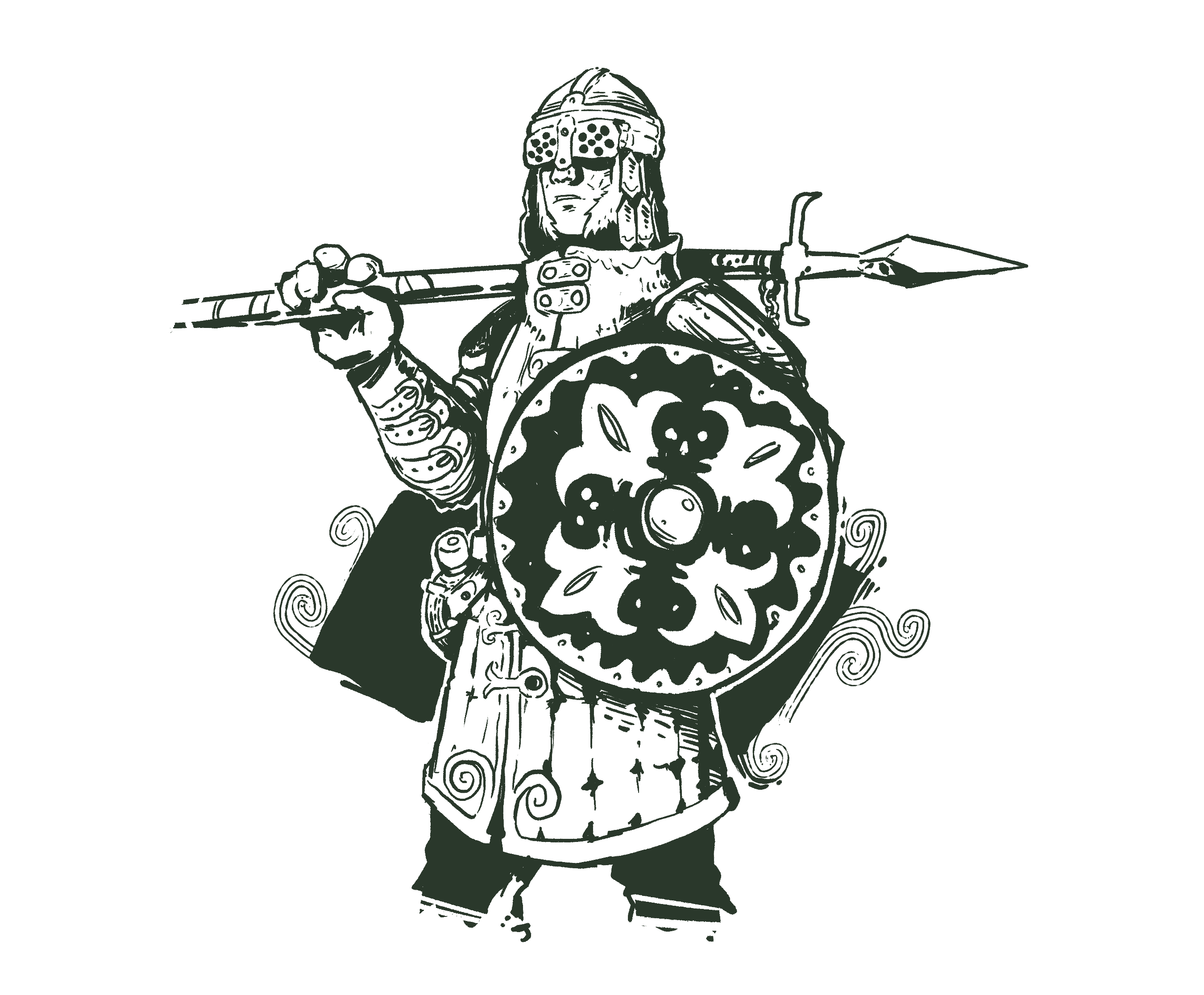
Trained in dealing with violence, warriors are the first one in a combat and the last ones out. Warriors can use any armor or weapon.
- Add 1 proficiency point to Strength.
- Warriors can use any weapon or armor.
Warrior background
Warriors can come from different backgrounds, dramatically changing their fighting and living style. For your special trait and equipment, you must choose a warrior background:
Combat maneuvers
Warriors must choose their combat maneuvers. They can choose 1 from the maneuver list in their warrior background. During combat, they may use those maneuvers freely, as many times as they want, as long they have the required actions for them.
Maneuvers require 1 action and hit close targets, unless specified in its description.
Thief
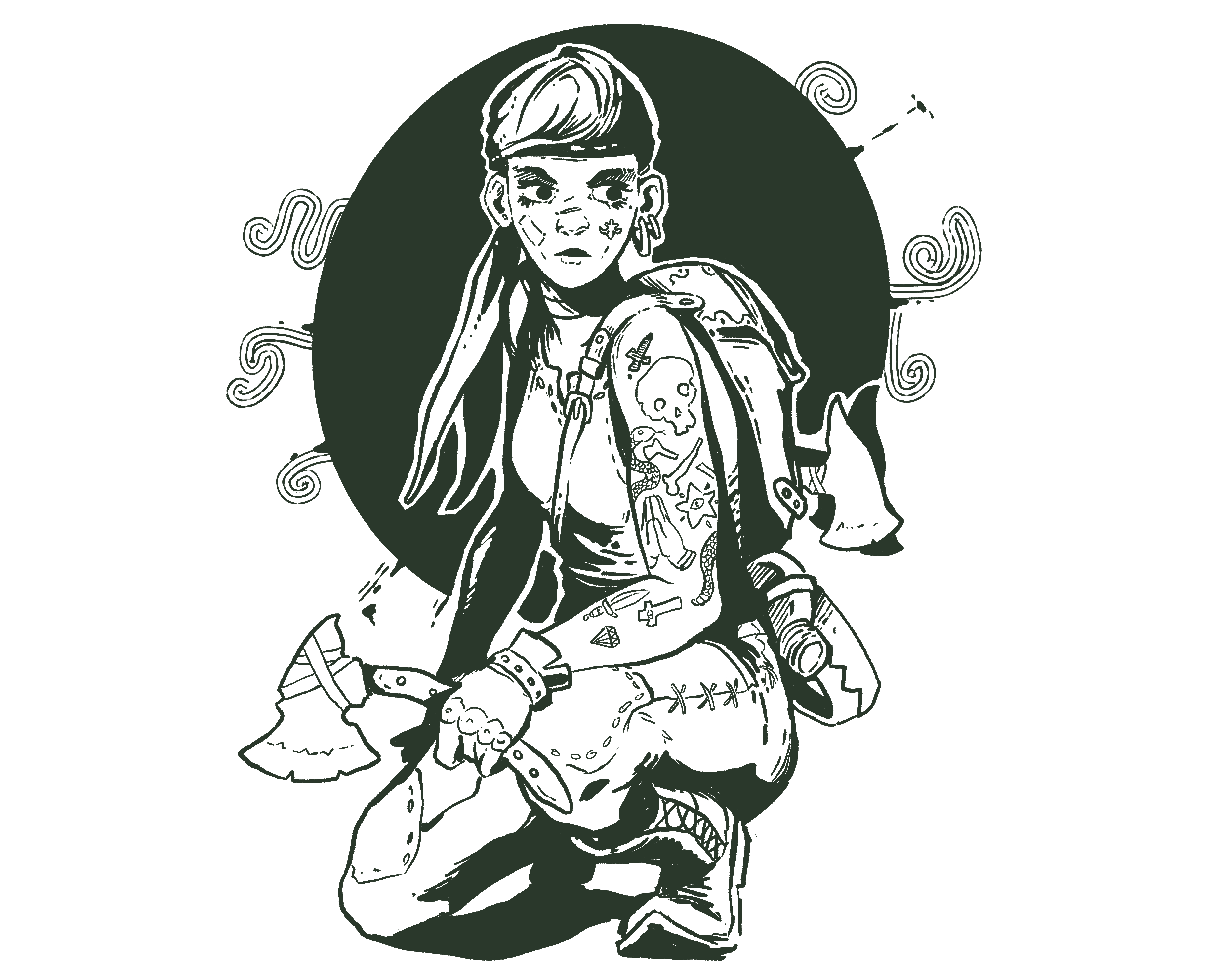
- Add 1 proficiency point to Dexterity.
- Thieves can use one-handed melee weapons, staves, any ranged weapons and medium armor
Thief background
Thieves can come from different backgrounds, dramatically changing their fighting and living style. For your special trait and equipment, you must choose a thief background:
Combat maneuvers
Thieves must choose their combat maneuvers. They can choose 1 from the maneuver list in their thief background. During combat, they may use those maneuvers freely, as many times as they want, as long they have the required actions for them.
Maneuvers require 1 action and hit close targets, unless specified in its description.
Wizard
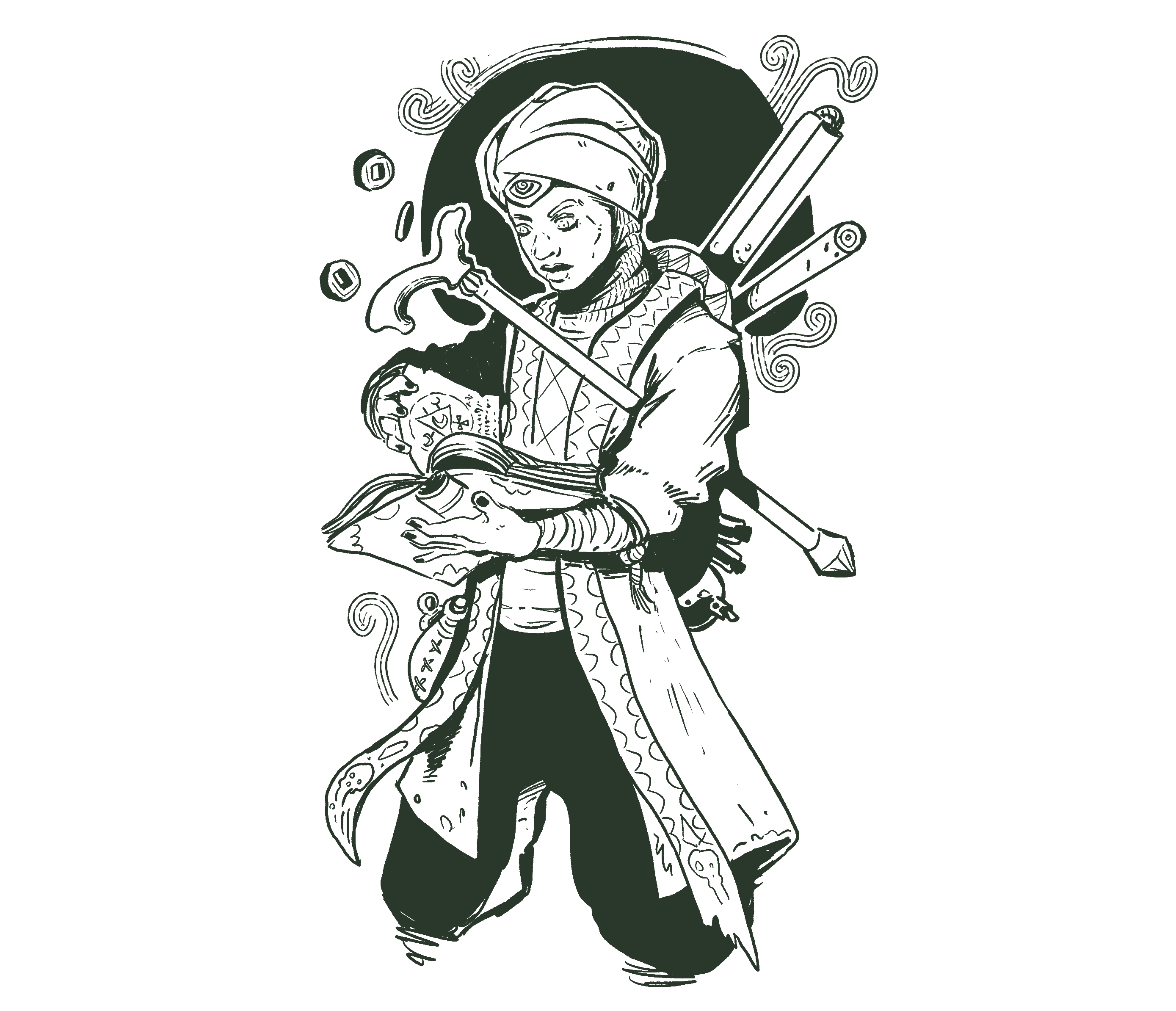
- Add 1 proficiency point to Intelligence.
- Add the trait magic user.
- Add skill lore master.
- Wizards can use only small, one-handed weapons, staves and light armor.
School of magic
Choose one of the following as your school of magic:
- Necromancers of Yadar
- Alchemists of the Golden Ridge
- Thaumaturgists of Ravenhome
- Wandering Mystics
- The Awakened
You can choose a different conductor or grimoire, if the GM allows it.
Spells
Wizards must choose a number of spells equal to their intelligence score from the spell list from their school of magic. Check the Blacksalt book for that list. Write them down on your character sheet under the "spells and prayers" section.
Wizards require a conductor to perform their spells, usually a wand, staff or crystal ball. Conductors help them to channel the magic from the void plane to the real world. While casting a spell without a conductor is possible, it's extremely dangerous. When casting without a conductor, any failure counts as a critical failure.
Wizards also need a grimoire to store their spells; without a grimoire, they can't study during the interlude or camp phase to remember forgotten spells. In some cases, the grimoire and the conductor are the same.
When the expedition starts, the player must choose which spells the adventurer will have memorized. One spell can be memorized for each intelligence point.
Casting a spell is always guaranteed to work: after the spell effects are resolved, the player must do an intelligence test:
- On a success, nothing else happens. The spell was cast as intended.
- On a failure, the caster forgets the spell.
- On a critical failure, roll from the spell mishap table. Keep track of how many mishaps have occurred during this expedition. Add that number to the dice total.
- On a great success, you tap into an arcane well. Your next spell will be an automatic success.
| 3d6 + Previous mishaps | Effect |
|---|---|
| 3 | Take 1 fatigue point on intelligence and receive the Nauseated affliction. |
| 4 | A loud noise! Advance the doom tracker. |
| 5 | Temporary blindness for 6 exploration turns. |
| 6 | You see a world without you, and it's better. You now have the Shaken affliction. |
| 7 | Summon a lesser demon Close to you. |
| 8 | Everyone Nearby receives the Angry affliction; you receive the Terrified affliction. |
| 9 | Everyone Nearby starts crying and receives the Hopeless affliction. |
| 10 | You and everyone Close have terrible visions and receive the Terrified affliction. |
| 11 | Summon a void demon Close to you. |
| 12 | You start bleeding from your eyes; take 1 wound to each attribute and the Bleeding affliction. |
| 13 | Your conductor is now destroyed. |
| 14 | You see a giant eye looking at you. Receive the Doomed affliction. |
| 15 | Summon a tormentor demon Close to you. |
| 16 | A third eye opens in your forehead; you are Cursed. This does not count as the Third Eye special trait. |
| 17 | You quickly teleport to the void realm and back, but all your equipment and items stay there. |
| 18 | Summon an endless horror Nearby. |
Cleric
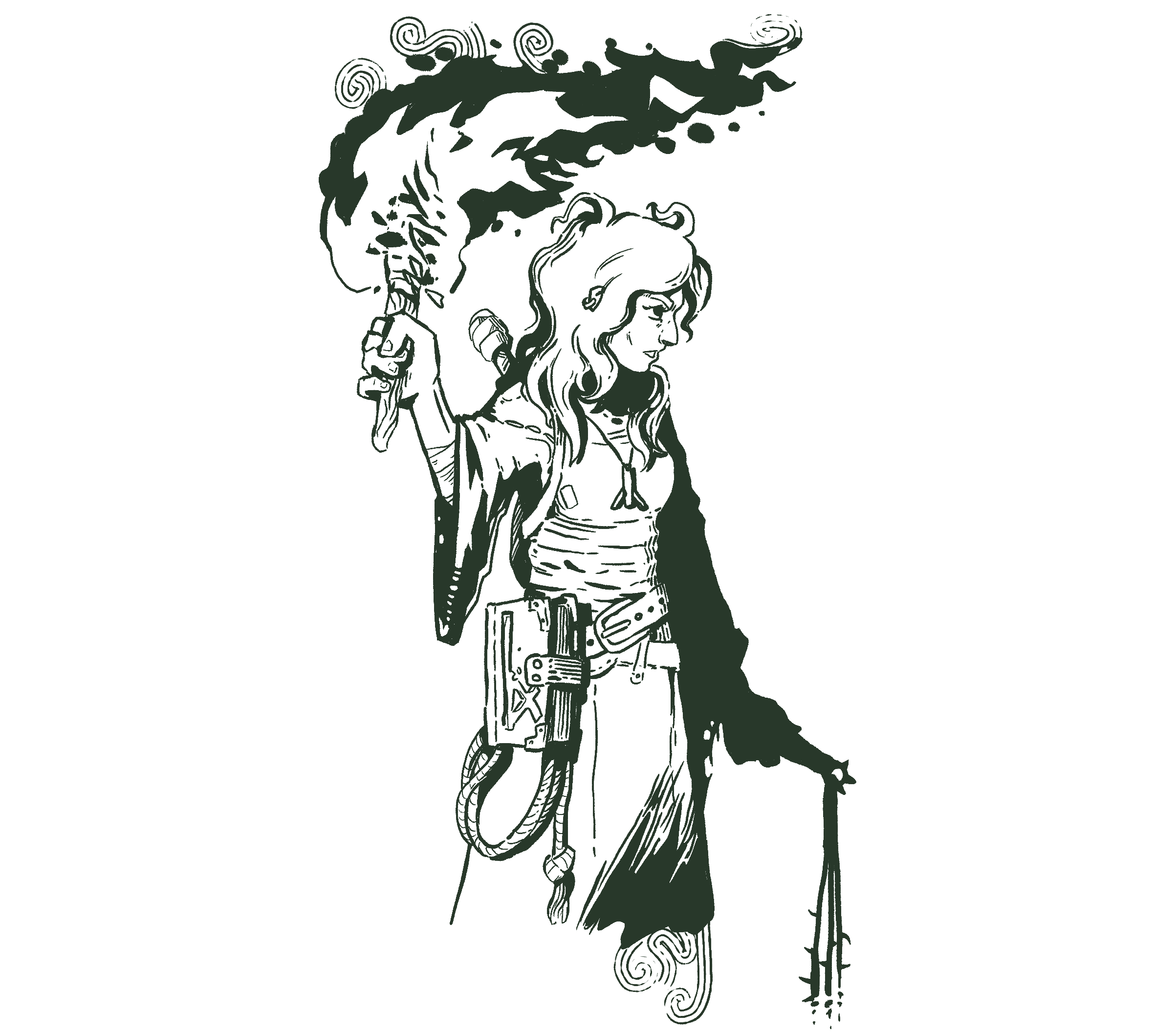
- Add 1 proficiency point to Presence.
- Add the trait divine mandate.
- Clerics can only use one-handed weapons, staves, bows, crossbows and medium armor
Gods
Choose one of the following gods for you to follow. That will determine your starting equipment and spells:
Clerics must choose a god to follow; you can see the list of gods in the Blacksalt book. Clerics must also choose a number of prayers equal to their presence score from the basic prayers list or from their god's prayers. Write them down in your character sheet under the "spells and prayers" section.
Prayers
Clerics require a holy symbol to cast a prayer; that symbol depends on the god that the cleric follows. Casting a prayer without a holy symbol doesn't work, but they are usually easy to improvise.
When the expedition starts, a player must choose which prayers the adventurer will have memorized. One prayer can be memorized for each presence point. Each prayer may only be used once until the adventurer rests at camp: once a prayer is used, it is considered to be exhausted. Once per expedition, the cleric may do a desperate plea and use an exhausted prayer once.
Casting a prayer is not guaranteed to work, since the gods can be cruel sometimes. Make a presence test when your adventurer tries to cast a prayer:
- On a success, the prayer is answered; resolve the effects as usual.
- On a failure, the prayer is ignored; don't do anything. Ignored prayers do not exhaust them.
- On a critical failure, you have angered your god; it won't answer any prayers until you make a sacrifice.
- On a great success, you also receive a miracle; roll from the miracle table.
| 1d6 | Effect |
|---|---|
| 1 | You heal 1d6 wounds of you or someone Nearby. |
| 2 | You heal all wounds or fatigue on one attribute of you or someone Nearby. |
| 3 | Unexhaust all prayers. |
| 4 | Cure one of the following afflictions from you or someone Nearby: Hungry, Parched, Bleeding, Nauseated or Cursed. |
| 5 | If you are in combat, all monsters try to flee in fear; if not, decrease the doom tracker. |
| 6 | If you are in combat, all enemies take 1 wound; if not, your group will start the next combat with one shield token on each adventurer. |
Every cleric can choose prayers from the basic prayers and from the prayer list from their god. Check the gods list for the prayers of each specific god.
Basic prayers
- Cure Light Wounds: Heal 2 wounds from a Nearby target. Also removes bleeding.
- Light: Illuminates the current room.
- Create food and water: Creates 1 unit of ration and water.
Core mechanics
Game Structure
A game of Dead Weight runs a bit differently than most tabletop RPGs. It follows a strong structure, with two main states.
The game usually starts in the Expedition phase, with the adventurers raiding a dungeon or some other terrible place in the Blacksalt Isle.
Dice Notation
Like many tabletop RPGs, Dead Weight uses dice notation to specify when and how you should roll your dice. Most die rolls are common six-sided dice, unless specified otherwise.
When you see d4, d6, d8, d10, d12 and d20, this is referring to a die of that size; d4 is a four-sided die and d20 is a twenty-sided die. Let's review all styles of dice notations we will use in this book:
Adding dice (2d6)
When you see 3d6, that means roll three six-sided dice and add the result.
Usage dice (Ud8)
Usage dice track consumable use. For instance, Throwing Daggers (Ud8) have a d8 usage die. Every time the consumable is used, the usage dice are rolled: if the result is a 1 or 2, that die is downgraded to the next smallest value in the following chain:
d20 > d12 > d10 > d8 > d6 > d4
If you roll a 1 or 2 on a d4, that item is gone: you just used the last one.
Risk dice (1d!)
Risk die are usually for checking if something unpredictable will happen. Roll the indicated number of d6; if any show a 1, that thing happens.
Attribute Tests and Checks
Rolling dice in Dead Weight is a dangerous and strategic activity. In general, players want to get away with actions that do not involve testing. Testing is usually exhausting for the characters, and in the dungeons, fatigue is deadlier than most blades. The GM may ask you to perform a test when your character tries to do something difficult, uncertain and has consequences.
Rolling dice also involves decision making: carefully choosing which dice to reroll is an important part of the game and helps your character to take difficult actions with different approaches.
Testing is always done in relation to a character's attribute. For example, trying to break down a door would require a test of strength. To do so, players must roll the same amount of dice as the score of the tested attribute. A character with a strength of 3 would have 3 available dice for a strength test. Players may always choose to roll fewer dice, or to not roll at all, failing the test.
The player needs to roll a 4, 5 or 6 on at least one die to complete the task successfully. If the player rolls more than one 6 on the dice, that's an great success and things go exceptionally well for that character. On the other side, if the player fails and rolls one or more 1 on the dice, that's a critical failure and things go exceptionally poorly for that character. 6s override 1s.


A successful roll example.

A failed roll example.
Beware that if any of the rolled dice is 4 or 1, the player will receive one fatigue point to that attribute, and only one, even if the test succeeded.

A success, but with a fatigue cost.

Another success, also with a fatigue cost.

A fail roll that also has a fatigue cost.
Rerolling dice is a common thing in Dead Weight. Many things, like character skills and dangerous situations will allow the players and the GM to reroll certain dice. The order of rerolls is always dynamic: players may choose to use their rerolls one by one, react to the GM rerolls and vice-versa. The test is only evaluated when both sides can't, or agree not to, reroll any more dice.
Here is an example of an attribute test:
Amber wants to climb down a rope, so the GM says that she will require a dexterity test. She has a dexterity score of 4, and she decides to roll all 4 dice.
She rolls
Since she rolled a 6, the test is a success. She manages to climb down the rope safely. Unfortunately for Amber, she also rolled a 1 and a 4; since that happened, she should receive one fatigue point to her dexterity.
If you are really into statistics, you can check the chance of critical failure, failure, success and great success here and the chance of fatigue here.
Wounds and fatigue
Every time a character receives fatigue points, apply them to an attribute.
Each fatigue or wound point that the character has on that attribute reduces the available dice of that attribute by one.
If a character needs to receive a fatigue point and that would make the available dice of that attribute lower than zero, convert one fatigue into a wound to that attribute; that wound can not be reduced by armor and other resistances. Read Receiving Wounds for more information.
Proficiency
Players may reroll a number of dice if they have proficiency on that attribute. For example a character with 2 points in intelligence proficiency can reroll 2 dice when testing for intelligence. Players may choose to use their proficiency dice one at the time.
If you choose to reroll a dice, you must use the new result, even if it's worse in any way.
Having a high attribute score is always good, but having proficiency is where things get interesting in Dead Weight. The rerolls usually make for interesting and difficult decisions.
Keeping it Safe
If the player doesn't want to risk fatigue, they can reduce their roll by 2 dice. If they do, rolling 1 or 4 will no longer exhaust the attribute, unless the test fails. This must be announced before the dice are rolled. You cannot use extra effort when you are keeping it safe.
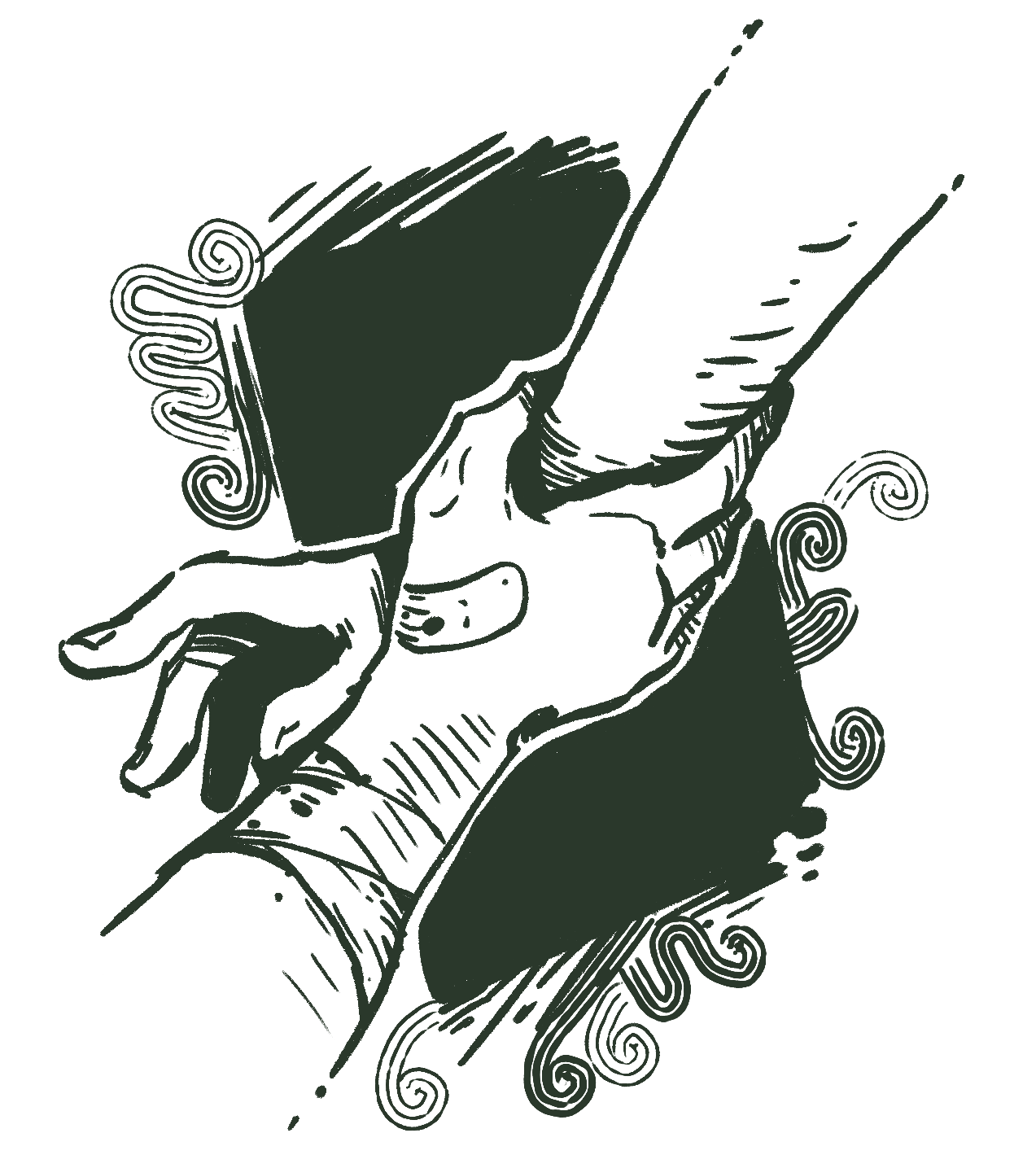
Receiving Help
Characters can help each other with a task, if they choose to do so. The player must explain how their character is helping the other in a way that makes sense for the action. The GM and the rest of the table must agree that the situation is plausible. This must be announced before the dice are rolled.
A character can only receive the help from one other character, unless the GM specifies otherwise. The helping character should roll one die; that dice will contribute to the main roll. If the helping character has a proficiency on that attribute, they can use it to reroll that dice. The character performing the main roll may not change that dice in any way.
Note that any fatigue generated by that dice should be received by the helping character only.
Negative consequences of a failed task are also suffered by the helping character, where applicable, but not the fatigue rolled by the main character.
Extra Effort
If the player really wants to succeed, it is possible to add one more dice to the available dice pool by causing the character one fatigue in the appropriate attribute. The player must announce that extra effort is being used before rolling the dice. A character cannot spend fatigue if it would cause the character to receive a wound as consequence of doing so.
Players may (not?) use extra effort after rolling the dice.
If the player is already going for the extra effort, rolling a 1 or a 4 will not cause fatigue, since they are already receiving that point.
Zero Dice?
If, for any reason, you need to roll zero dice, you should roll 2 die instead and take the lowest number instead. Rolling less than zero dice is also possible: roll 2 die and add one extra dice for each value below zero. For instance, when rolling -3 die, roll 5 die (2+3) and choose the worst. I'm pretty sure that test will fail, though, sorry.
For simplicity, the GM may declare a -2 or lower roll to be an automatic failure.
Checks or Tests
Sometimes a rule will call for a check, such as an initiative check. Checks work exactly like tests, except that rolling 1s and 4s on this test do not cause fatigue.
Proficiency can be used normally in checks.
Advantage and Disadvantage
When a test describes an especially easy or difficult action, the GM may give players an advantage or disadvantage. Many combat actions and enemy abilities will also add an advantage or disadvantage to tests.
- Advantage allows the player to choose one die from the test or check to reroll. The new value must be used.
- Disadvantage allows the GM to choose one die from the test or check to reroll. The new value must be used.
The players or GM may always choose not to reroll a dice for advantage or disadvantage, respectively.
Advantage and disadvantage will nullify each other if for any reason a test would have both; they can also stack: having advantage or disadvantage multiple times allows the players or GM to reroll multiple dice.
The GM must announce that the test has advantage and/or disadvantage before the dice have been rolled.
Receiving Wounds
Characters will often receive wounds from various sources. Most wounds can be reduced, usually by armor or some character traits. Wounds received by fatigue cannot be reduced.
Armor
Making an armor roll is a bit different than making a test.
If your character has armor, it will have a number of armor points, abbreviated as AP.
To use armor, roll one dice per armor point: for each 4, 5, or 6 reduce the damage by one. For each 1 or 4 rolled, that armor takes damage and will lose 1 armor point until it's repaired. Players may always choose to roll fewer or zero armor dice.
If the adventurer is wearing multiple pieces of armor, like a helmet and a vest, only one piece of armor can be used to defend each attack. The player chooses which piece to use.
Some armors are notated like this 2, 2 AP with 2 or more numbers. This means that each "part" of the armor should be used individually. In the example armor, the player may not roll 4 dice at the same time, only 2. Those parts break individually, too.
Zael just received 2 wounds from an arrow and decides to use his reinforced leather armor (2 armor points) to 2 dice. The new results are 1 and 6, which reduces the damage to only 1 wound, but the armor is damaged and now has only 1 armor point until it's repaired.
Placing wounds
When receiving wounds, you must choose one or more attributes on which to place them. If an attribute already has fatigue points, you may convert those to wounds instead of adding wounds when placing each point.
Zael now just received 3 wounds from an sword attack and managed to reduce it to 2 wounds using armor. After some consideration, he decides to place that damage on the presence attribute, which already had 2 fatigue; that fatigue is now converted to wounds.
Attributes can't hold more wounds than their score.
Sometimes a rule will force the player to place the wounds on a specific attribute. If the specified attribute can't hold that many wounds, ignore the excess and the character will immediately collapse and faint. A common example for this is when receiving fatigue on an attribute that's already filled with wounds; this would make the character break down from exhaustion.
If no attribute can hold any more wounds, meaning that all available dice have been reduced to zero, and another wound must be placed, that character gets mortally wounded. Most wounds are considered lethal, but sometimes a character will receive a non-lethal wound. When that happens, a character will not be mortally wounded when receiving that damage; all excess points should be discarded and the character just faints.
Mortally wounded characters don’t die immediately, but they cannot take any actions and must be stabilized by someone after the combat. If a mortally wounded character receives any more damage, that character will die.
Enemies don't have attributes, so there's no need to choose where to place the wounds when receiving them. Enemies die when receive more wounds than noted in their enemy sheet.
If the received wounds are reduced to zero or less by armor or other resistances, that character doesn't take any wounds.
Fainting
When a character would receive a fatigue or would point but it is impossible to place it, they immediately faint. Then, the character cannot move or take any actions. Wounds continue to be placed as normal.
Keep track of how many wounds were discarded when you fainted. You stay fainted for at least that amount of turns (combat or exploration turns). Discard all stun tokens while in this state. After waiting you may roll 1D! to try waking up by yourself.
Outside of combat other characters can stabilize you with a first aid kit, medical supply or healing spell and wake you up.
Mortal Wounds
When a player character is mortally wounded, that player must roll from the mortally wounded table.
- Add 1 to the dice result for each time the character was mortally wounded during this Expedition.
- Other game effects can also add or subtract from that value.
A mortally wounded character is unable to move or perform any actions. That character must be stabilized with a first aid kit, medical supply or healing spell to wake up. If your character already has the trauma you would receive, ignore it.
| 1d6 | Effect |
|---|---|
| 0 | Nothing but a scratch! You stand your ground and do not fall mortally wounded. |
| 1 | Knocked out, but no lasting consequence. See fainting. |
| 2 | This injury won't heal how it should. Receive the chronic pain trauma. |
| 3 | Choose and receive a trauma you don't currently have. |
| 4 | You bleed internally. Receive the brain damage trauma. |
| 5 | You see the other side. Receive the visions trauma. |
| 6 | On the verge of death! If not stabilized in 1 combat turn, you are dead. No lasting consequences. |
| 7+ | You are dead. |
Special Tests
There are some particular cases where attribute tests won't work. Let's see some solutions to those problems.
Player opposing tests
What happens if there's a player versus player situation? In that situation, both players must perform the appropriate attribute test. The attribute is chosen by the GM, depending on the situation (an arm wrestling match would require strength, a race would use dexterity).
If one player succeeds and the other fails, the one that succeeded won. If there's a tie, roll again until only one is victorious.
Player attacking players
In the rare situation where a player character attacks another, either my mistake or by evil intent, the attacking player must roll a test using the attribute currently notated on the weapon or attack. Alternatively, if the GM and players agree, a different attribute that fits the situation better can be rolled, but it's always the attacker that rolls the dice.
Non-player characters opposing tests and attacks
When a monster, or any character not directly controlled by the player attacks another, you can also run into problems, since they don't have attributes. To solve this, use their level as the attribute score instead.
Core Concepts
Attributes
Character attributes in Dead Weight specify how good your character is at something.
Attributes have two numbers, the score, which measures your character endurance and natural talent with that attribute, and the proficiency, measuring how well trained your character is at that attribute. Every character has 4 attributes.
- Strength (STR) is physical strength and constitution of a character. It also influences how many items a character can carry.
- Dexterity (DEX) is how fast and precise a character is. It is used mostly in ranged attacks, initiative, dodging and in a variety of tests.
- Intelligence (INT) is how intelligent and wise a character is. It also influences how many spells a character can memorize.
- Presence (PRE) is how persuasive and strong-willed a character is. It also influences how many prayers a character can memorize.
Attributes can also have fatigue and wounds. A good way to write those down in your sheet is to make a single line for fatigue and an "X" for a wound. During combats your character will probably receive and recover fatigue often, so using small markers like coins, beans or a dice might be easier; you can write down your fatigue after the conflict is resolved.
Skills
Skills mainly give your character extra abilities to use during the expedition and interlude. But they can also be extremely valuable for gathering information and interacting with the world. With the loremaster skill, for example, the GM may give you extra information on the dungeon history, or, with the ritualist skill, the GM might tell you how to remove a curse you received. Skills are a good opportunity for the GM and players to exercise their creativity while coming up with stories.
Some skills can be upgraded: remove the previous skill before learning the advanced one so it only occupies one slot. They are the indented ones below, for clarity. You must always learn the basic skill before the advanced one.
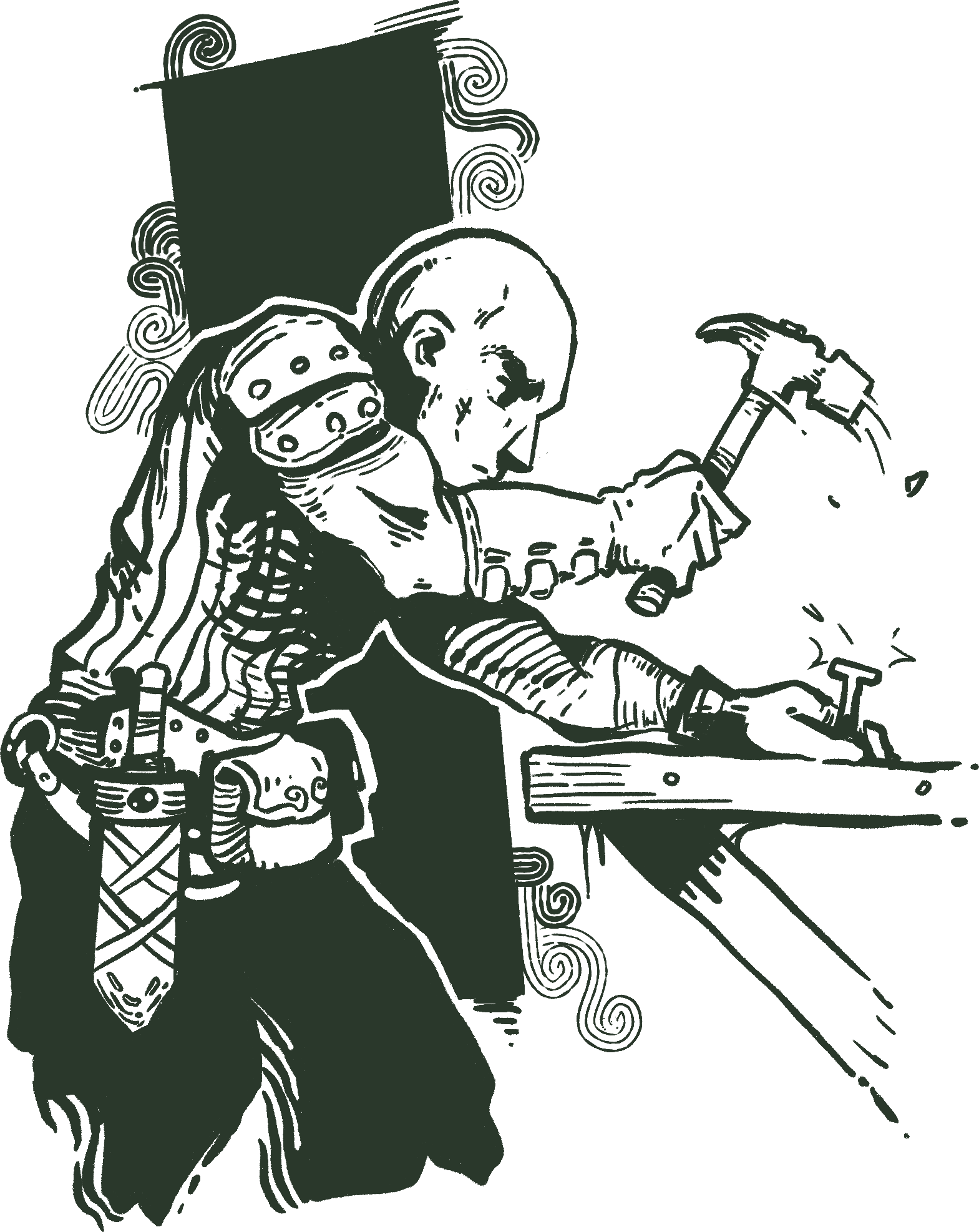
- Animal Affinity: You have advantage when testing for anything that involves taming, understanding or tracking wild animals.
- Beastmaster:(advanced) You have advantage for anything that involves fighting, taming, understanding or tracking animals. You have a pet that follows you around (medium ally).

- Ward the dead: May perform a ritual using 1 exploration turn to ward the dead vigil within a circle of radius 1 meter. Does not affect anything that the dead vigil has already set, only prevents it from happening the first time.
- Cooking: Each ration can feed an extra adventurer in the camp phase. You get 1 free ration at the start of the interlude.
- Master Chef:(advanced) Each ration can feed two extra adventurers in the camp phase. You get 3 free ration at the start of the interlude.
- Crafting: You have advantage when testing for crafting things. During the camp phase, you can repair 2 points of armor automatically.
- Duelist: You may perform a feint action in combat (1 action). Discard all shield and dodge tokens from your enemy.
- Swashbuckler:(advanced) If your feint removes a shield token, your opponent may not attack next turn.
- Fearless: Once per combat, you may heal one presence wound.
- Haggle: During the interlude you can reroll the price of an item once. You must use the new result.
- Trade network: During the interlude, you can reroll the price of an item once. You may choose to use the new or the old result. You may also reroll the item availability once.
- Holy Rites: You have an extensive knowledge about the new gods, prayers and the saints. You may make holy water using clean water and 1 exploration turn.
- Infiltration: Allows the search for traps action without proper tools during expeditions and an advantage when sneaking.
- Intimidate: You may perform an intimidate action in combat (2 actions), attacking with PRE 1N against all nearby enemies. Only one intimidate action can be used per combat.
- Loremaster: You have an extensive knowledge about the world history, languages and different cultures.
- Pilfer: You earn 1d6 silver coins at the start of the interlude.
- Occult Studies: You have an extensive knowledge about old gods, magic and the occult.
- Ritualist: During camp phase, you can spend 1 action to remove one point from the omens tracker or doom tracker.
- Shield Expert: Add 1 extra shield token when defending.
- Shield Master: (advanced) Add 1 extra shield token when defending. Moving does not remove shield tokens.
- Stalker: Before combat, if undetected by an enemy, you have a free critical hit.
- Street Wise: You cannot get robbed in the interlude, and you have one extra daily action. You may reduce the price of common items by 1 silver (to a minimum of 1).
- Surgeon: During the camp phase, you may perform an Intelligence test to heal one wound from each character in your group.
- Survivalist: Gain 1 extra proficiency point for anything that involves surviving in the wilderness. Adds 1 extra camp action.
- Slippery: You may spend dodge tokens during the enemy turn to move one tile.
- Veteran: (1 explorer action) Test presence: on a success, you will know how much doom this location currently has, and how much doom is required to trigger the next step.

Special Traits
Special traits are similar to skills, but usually add or break a rule for your character.
- Berserker: During combat, ignore strength fatigue and wounds when rolling tests. You still take wounds and fatigue normally, and so your character will collapse in exhaustion if your available dice go lower than zero.
- Bad omens: Every time you have a critical fail on a test, advance the omens tracker.
- Battle trance: Every time you kill an enemy, you get an extra action.

- Cold blood: You may back-stab enemies that are engaged in combat with another character or distracted, for which you may use Dexterity to hit with weapons that would require Strength. Enemies can't use resistance to reduce your damage, and you cause one extra wound.
- Divine mandate: You may cast prayers. You require a holy symbol, and must have previously memorized them. Check the prayers section for more information.
- Hardened: When receiving wounds from an attack, you may test strength: on a success, resist 1 wound. On a great success resist 2 wounds.
- Magic user: You may invoke spells. You require a magic conductor, and must have previously memorized them. Check the spells section for more information.
- Rejected by death: If your character would get mortally wounded, roll 2d!: if triggered, ignore the mortal wound.
- Dauntless: When you get a success on a test, you may roll 2 extra dice and add them to this test. This increases your great success and fatigue chance.
- Third eye: You can see the omens tracker.
Traumas
Traumas work similarly to special traits, except that they are always very bad for the adventurers. Traumas are usually received when the character gets mortally wounded. Most traumas can be recovered or at least downgraded to a more manageable one.
Receiving the same trauma again has no effect.
- Broken arm: Can't use one arm for attacking or carrying items.
- Broken leg: Movement reduced to 1 tile and costs 2 actions in combat. Moving during expedition must be done with help or some sort of cane.
- Chronic pain: You just can't seem to focus. Reduce one point on one attribute score that is not already zero.
- Brain damage: Reduce one proficiency point on one attribute that is not already zero.
- Paranoid: Can't receive help from allies, and can't share items other than rations in the camp phase. -1 ambush dice in the camp phase.
- Fearful: During combat, if you are attacked, you move one tile back. If you are attacked more than once, you get 1 (and only 1) stun token.
- Visions: When someone casts a spell nearby, you receive a stun token.
Afflictions
Each affliction has their own set of rules on how they affect the character and how they are removed.
If an adventurer would receive an affliction he or she already has, ignore it.
| Afflictions | Effect | Getting rid of * |
|---|---|---|
| Hungry | Wounds do not heal. | Eat food. |
| Parched | Cannot recover fatigue. | Drink water. |
| Bleeding | Receive one fatigue point every turn. | Use bandages or some other form of first aid. |
| Sleepy | Can't use extra effort or help friends on tests. | Camp or drink coffee, or receive a wound in combat. |
| Angry | Can't reroll your dice with proficiency. | Drink a cup of tea or hot chocolate. |
| Shaken | Can't use the Catch Breath action in combat or during exploration. | Rest in the camp phase. |
| Nauseated | During combat, you have one less action. | Some potions and tonics. Healed in the interlude phase. |
| Terrified | Rolling a 4 on attribute tests doesn't count as a success. | Drink wine or other alcoholic drink, or defeat a challenging foe. |
| Hopeless | Rolling a 5 also causes fatigue. | Escaping alive from the dungeon or survive a challenging fight. |
| Cursed | Wounds do not heal by resting. Can see ghosts. | Only removed by magic or miracles. |
| Plagued | Coughs constantly. When receiving fatigue, receive a wound instead. | Only removed by magic or miracles. |
| Doomed | When the doom tracker moves, it moves one extra point. | Only removed by magic or miracles. |
* Not exhaustive: always check item and spell descriptions for more ways to remove afflictions.
Inventory
Characters can carry 7 items + 3 items for each strength score. Items should be placed on your character sheet in the appropriate slots in the Trappings section. While carrying more items is possible, the character will become encumbered, and all movement is reduced by half. You must perform a strength test every turn, and failing means some item was dropped, chosen randomly.
At the trappings table, on top of each list, there's a label, something like "Belt/Small pouch". Circle any items your character has; if your character doesn't have any of the listed items, cross out the whole list.
Here's a breakdown of how the adventurers can carry their items:
- A bag carried on the back can carry 4 items; a backpack can carry 7 items.
- A belt can carry 1 item; a small pouch can carry 2 items.
- A canteen can carry 1 liquid item; a skin can carry 2 liquid items.
- Each small bag can carry 3 items.
Unless stated otherwise, all characters start with a belt, a canteen and a bag.
When items have a characteristic that makes them awkward or hard to carry, write it below the item, with the characteristic occupying one extra slot. Examples of characteristics are oversized, fragile and unstable.
Very small items, like chalk, keys or a dice do not occupy any slots, and should be written down in the notes section of the character sheet.
Characters may also carry items in their torso and hands slots.
- The torso has 4 slots.
- Each hand has 2 slots.
Equipped armor and helmet go on the torso slots; wielded items, including torches, go on the hands. Unless the player has a really good explanation, a character can only wield one item in each hand, even with 2 slots. For simply carrying stuff, carrying 2 items in each hand is fine.
The character's clothes that are not considered armor do not occupy a slot. You can write them down in the notes section.
Distance
Most weapons, skills, spells and items will have a maximum or minimum range to work. To simplify things, we will use some abbreviations, instead of listing the numbers every time.
There are 4 range types for measuring distance in Dead Weight:
Close, Nearby, Far and Distant.
When using a grid map, here's how you can convert distances:
| Distance | Meters | Squares |
|---|---|---|
| Close | 1.5m | 1 square, no diagonal |
| Nearby | 9m | 6 squares |
| Far | 20m | 12 squares |
| Distant | more than 20m | 12 squares |
Trackers
Also known as a progress clock in other systems, a tracker is just one or more circles divided into segments that the GM uses to track the progression of something. Every time a tracker is advanced, one segment must be filled. When the circle is completely filled, the tracker is triggered and something happens. There are 3 main trackers that are always in play:
- Decay tracker: Represents the toll that dungeon delving takes on the adventurers. Causes hunger, exhaustion and other bad things to the players. Advances every turn.
- Doom tracker: There's one for each dungeon, representing the dungeon "waking up" to the adventurers' presence and reacting.
- Bad Omens tracker: There's one for the whole campaign. Represents the adventurers' terrible luck and their inevitable doom in Blacksalt island. Every time it gets completed, something really bad happens.
The Playing the Game book explains in more detail how each of these trackers work, so don't worry about them for now.
The GM can also create more trackers at any moment, to represent long challenges, the tide rising, a strong enemy slowly waking up and so on. Trackers can be hidden from the players or fully visible.
Light
Adventurers often explore tombs, dungeons and other dark places. Having some sort of light source is essential. The most common ways to light the way in a dungeon are:
- Torches: Lights the way nearby, for Ud4 decays.
- Candles: Lights the way close, for Ud6 decays.
- Lantern: Lights the way nearby for Ud8 decays. Uses oil. Quick to turn on and off, slow to refuel.
- Light spell: Lights the way nearby, for 1 decay.
Every time a decay happens, the usage dice of the light sources should be tested. If the usage dice is exhausted, the light source will be gone next turn: a new one must be lit next turn or the adventurers will be left in the dark.
Ending a turn in the dark causes an adventurer to take a presence fatigue or the terrified affliction, player's choice.
About
The goal of Dead Weight is to capture the classic feeling of dungeon crawling tabletop RPGs and board games. It is inspired by many others, borrowing a lot from Blades in the Dark, HeroQuest (the board game), Forbidden Lands, Knave, The Black Hack and Torchbearer.
This system is open source and is released under the Creative Commons Attribution license: you are free to hack, copy, change and even sell derivative works from this system, as long you give proper attribution. The Dead Weight logo cannot be used without express permission, though.
This game was designed and illustrated by me, Pedro Medeiros and if you like what I'm doing, you may consider supporting me on Patreon.
This section of the book is still a work in progress, lots more content will come soon!
This book is about the setting of Dead Weight, Blacksalt Island. It's also possible to play Dead Weight using other settings if you want, but the rules are not generic, and will work better on dark settings with underpowered and desperate characters.
This book is also full of reference tables including equipment, class backgrounds and more. Ideally the players should have easy access to this.
Equipment
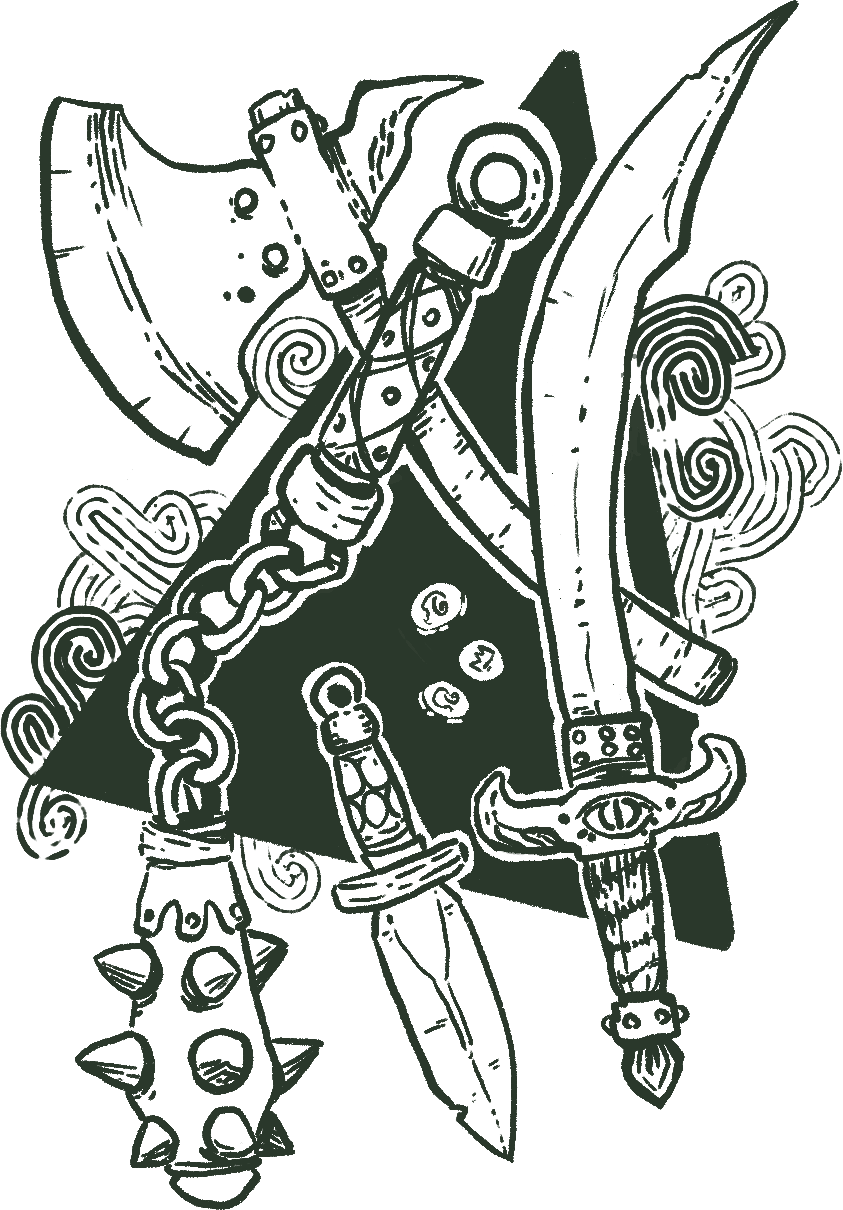
There are 5 item categories common, uncommon, valuable, rare and exotic. The categories set the item price and how hard it is to find during the interlude.
Again, if you really like statistics, this is the statistics map of the possible prices.
| name | description | tags |
|---|---|---|
Water | 2 units of water can fit one slot. | Quick |
| name | description | tags |
|---|---|---|
Cloth | A piece of cloth, can be used as improvised bandages. | Slow |
Camping supplies | Basic supplies for making a fire and cooking. | Camp |
Bandages | A pack of 3 bandages, used to stop bleeding. | Quick |
Drawing tools | Some papers and drawing tools, can be used to draw maps or write scrolls, Ud8. | |
Common clothes | Nothing fancy. | Equipment |
3 meter pole | Good for looking for traps. (Big) | Equipment |
Iron spikes | For fixing doors open and making sure things stay in place. Ud8. | Slow |
Canteen | For holding water and other liquids. | Quick, Equipment |
Ration | Removes the hungry affliction. If cooked during camp, can feed 2 (or 3) adventurers (if someone has the cooking skill) | Slow, Camp |
Torches | A pack of 2 torches. Lights the way nearby for Ud4 decays. | Slow |
Candles | A pack of 6 candles. Lights the way close for Ud6 decays. | Slow |
Oil | For refueling the lantern. | Slow |
Rope | 10 meters of rope. | Slow |
Special ration | Tea, coffee or hot chocolate. Does not remove the hungry affliction. | Camp |
Sewing tools | Repairs one armor point from any light armor. Ud8 uses. | Camp |
Small bag | For extra inventory space. | Equipment |
Holy water | Can be thrown at undead for DEX 2PR, Ud6 uses. | Equipment |
Shovel or pickaxe | Good for digging around. | Equipment |
| name | description | tags |
|---|---|---|
Climbing gear | 15m of rope with a hook, spikes and other safety utensils for Ud6 climbs. | Slow |
Waterskin | A large container for holding water and other liquids. | Slow, Equipment |
Lockpicking tools | For opening simple locks. Ud20 uses. | Slow |
Trapping kit | For making and disarming simple traps. Can build Ud6 traps. Stepping on a trap causes 4 wounds and immobilizes the target. Getting free requires 1 turn and a strength test. | Slow, Equipment |
Lantern | Lights the way nearby for Ud8 decays. Uses oil. Quick to turn on and off, slow to refuel. | Quick, Slow |
First aid kit | Heals one STR or DEX wound. Ud6 uses. | Camp |
Medical supply | Pack of 2. Used in camp for healing 1 wound. | Camp |
Healing tonic | Heals one INT or DEX wound. Ud4 uses. | Quick |
Wine | Heals one PRE wound and removes Parched. Ud4, causes Nauseated if you drink too much. | Slow |
Leatherworker's toolkit | Repairs one armor point from any medium or light armor. Ud6 uses. | Camp |
Compass | Useful for not getting lost. | Quick |
Small pouch | For extra inventory space. | Equipment |
Backpack | For extra inventory space. | Equipment |
Exorcism book | One extra die when banishing undead. |
| name | description | tags |
|---|---|---|
Mechanics toolkit | For fixing, assembling and disassembling mechanical devices. | |
Ashes of insight | Identify a single magic item (slow) or reveals something invisible (quick) | Quick, Slow |
Armourer supplies | Repairs one armor point from any armor. Ud6 uses. | Camp |
Holy symbol | Used to perform miracles. | |
Wine of Yoros | Liquid courage. Heals one PRE and one INT wound. | |
Pack mule | Useful for carrying items on long journeys. Has 10 inventory spaces, requires 2 rations per day or grass. |
| name | description | tags |
|---|---|---|
Fine jewelry | Made of precious materials, not very useful in a dungeon. | |
Living ashes | +1 damage to a weapon during expedition, Ud4 uses. | Quick |
Alchemic kit | Can be used for modifying, identifying and making potions. | |
Spell book | Simple spell book, holds 3 spells. |
| name | description | tags |
|---|---|---|
Panacea | Cures any disease or affliction. Heals one wound in each attribute. | |
Holy relic | A relic retrieved from the grave of a saint. |
Weapons
All weapons can be used with one hand, unless stated otherwise.
| Name | Stats | Special Rules | rarity |
|---|---|---|---|
Battle axe | STR 4+2B | 2 hands. | valuable |
Cane | STR 1+1 | common | |
Driftwood Club | STR 2 | free | |
Dagger | STR 1+3P | common | |
Small Knife | STR 1+1P | Easy to hide. | common |
Falchion | STR 3+1B | uncommon | |
Flail | STR 2+2 | Ignore shield tokens. If you miss, roll a d6, on a 1 you hit yourself with 1 wound. | uncommon |
Quarterstaff | STR 1+2 | On hit add one [dodge token]{.tip} to the attacker. | common |
Cane | STR 1+1 | Can be used as a conductor. | common |
Sacrificial dagger | STR 1B+1 | If all damage is reduced roll a d6, on 1 it breaks. | uncommon |
Notched whip | DEX 1R+2B | If the enemy has no armor, add a stun token to the enemy. Can hit diagonally. | uncommon |
Short Spear | STR 2+1B | 2 hands. Can be used with 1 hand, but reduces the attack roll by 1 dice. Can hit diagonally. | common |
Long Spear | STR 3+1B | 2 tiles. 2 hands. Can be used with 1 hand, but reduces the attack roll by 1 dice. Can hit diagonally. When hitting tiles close use (-STR 1+1). | uncommon |
Short sword | STR 2+1 | If dual wielded, becomes 3+1. | uncommon |
War hammer | STR 2P+3 | If you hit roll a d6, on a 6 add a stun token to the enemy. | valuable |
Throwing hatchet | DEX 2+1 | Nearby. You can use STR to hit but if you do, flip a coin, on heads it hits with the handle, causing no damage. Ignores shield tokens. You can use STR to melee with no downsides. | uncommon |
Scythe | DEX 1+2B | Ignore shield tokens. | uncommon |
Short bow | DEX 2+1R | Nearby. 2 hands Need arrows. | uncommon |
Crossbow | DEX 3P+1R | Nearby. 2 hands. Requires 2 actions to reload. | valuable |
Shields
| name | stats | rarity | special effect |
|---|---|---|---|
Buckler | 1 shield token | uncommon | Can be used on the same hand of an equipped weapon. |
Small metal shield | 1 shield token | uncommon | |
Small wooden shield | 1 shield token | common | Breaks on 2d! when using one or more shield tokens. |
Wooden shield | 2 shield tokens | common | Breaks on 2d! when using one or more shield tokens. Can't dodge when equipped. |
Leather shield | 2 shield tokens | uncommon | Breaks on 1d! when using one or more shield tokens. Can't dodge when equipped. |
Metal shield | 2 shield tokens | valuable | Can't dodge when equipped. |
Tower shield | 3 shield tokens | rare | Big, occupy 2 slots. Can't dodge when equipped. |
Spiked shield | 2 shield tokens | rare | Causes 1 wound when blocking a melee attack. |
Armor
| Name | Stats | Special Effect | rarity | type |
|---|---|---|---|---|
Heavy cape | 1 AP | Can be worn with other armor. | uncommon | Cloth |
Reinforced trenchcoat | 1 AP | uncommon | Cloth | |
Gambeson | 1 AP | Can be worn under heavy armor. | valuable | Cloth |
Leather armor | 1 AP | uncommon | Leather | |
Padded armor | Leather | valuable | 2 AP | Rolling 4 doesn't break the armor. |
Gladiator Armor | Leather | uncommon | 1 AP, 1 Ap | |
Scale Armor | Heavy | valuable | 2 AP | |
Chainmail | 3 AP | Can't be used against impact attacks. | valuable | Heavy |
Gothic plate armor | Heavy | rare | 2, 3 AP | Occupy 2 slots. Reduces dexterity die by one. |
Soldier helmet | Leather | uncommon | 2 AP | Always breaks 1 and only 1 AP on use. |
Cage helmet | Leather | valuable | 1 AP | |
Close helmet | Heavy | rare | 2 AP | |
Frog-mouth helm | Heavy | exotic | 3 AP |
The Dead Vigil
One of the most notable things about Blacksalt is the dead vigil. Any creature that dies in Blacksalt has a chance to come back to life as an undead, humans will almost always come back, animals and other smaller creatures can come back to life but that's not common. This effect is called the dead vigil.
The cause of the dead vigil is uncertain, some blame the old king for trying to achieve eternal life, others say it's because of something buried deep in the island tunnels, but no one knows for sure.
Any corpse, if left undisturbed, will come back to life after 1d6 weeks as a Freshly risen corpse or Reanimated husk, depending on the state of conservation and will start looking for other people to attack. If the corpse is too damaged or somehow unsuitable, it may come back as ghost, like a shadow; that's rare though, and ghosts are extremely dangerous, so people avoid destroying corpses.
The most "elegant" way to dispose of a body is a proper burial ritual, and a coffin with the seal of Cador, which will stop the corpse from returning. This is a relatively new technique. Over the years, people didn't know how to deal with their dead. Different groups of people tried many different rituals and techniques to stop their dead from coming back, usually with horrible consequences.
Warrior Background
Footman

Trained to fight in an army, footmen are specialized in fighting as a unit, protecting allies and countering enemy attacks.
Footmen start with the hardened special trait, allowing them to reduce any damage they receive.
Equipment
Backpack, Spear (STR 3+1B), metal shield(2 shield tokens), padded armor (2 AP), soldier helmet (2 AP), 2d6 silver coins.
Manoeuvers
- Turtle: (2 actions) Raise your shield, get on one knee and brace for impact. Perform a defend action (adding the appropriate number of shield tokens) and for this turn you can't receive fatigue for defending.
- Aegis: During the enemy turn, you may spend a shield token to swap places and receive an attack in place of an adjacent (including diagonals) ally.
- Payback: After spending a shield token for successfully blocking a melee attack you may add a stun token to the attacking enemy.
Gladiator
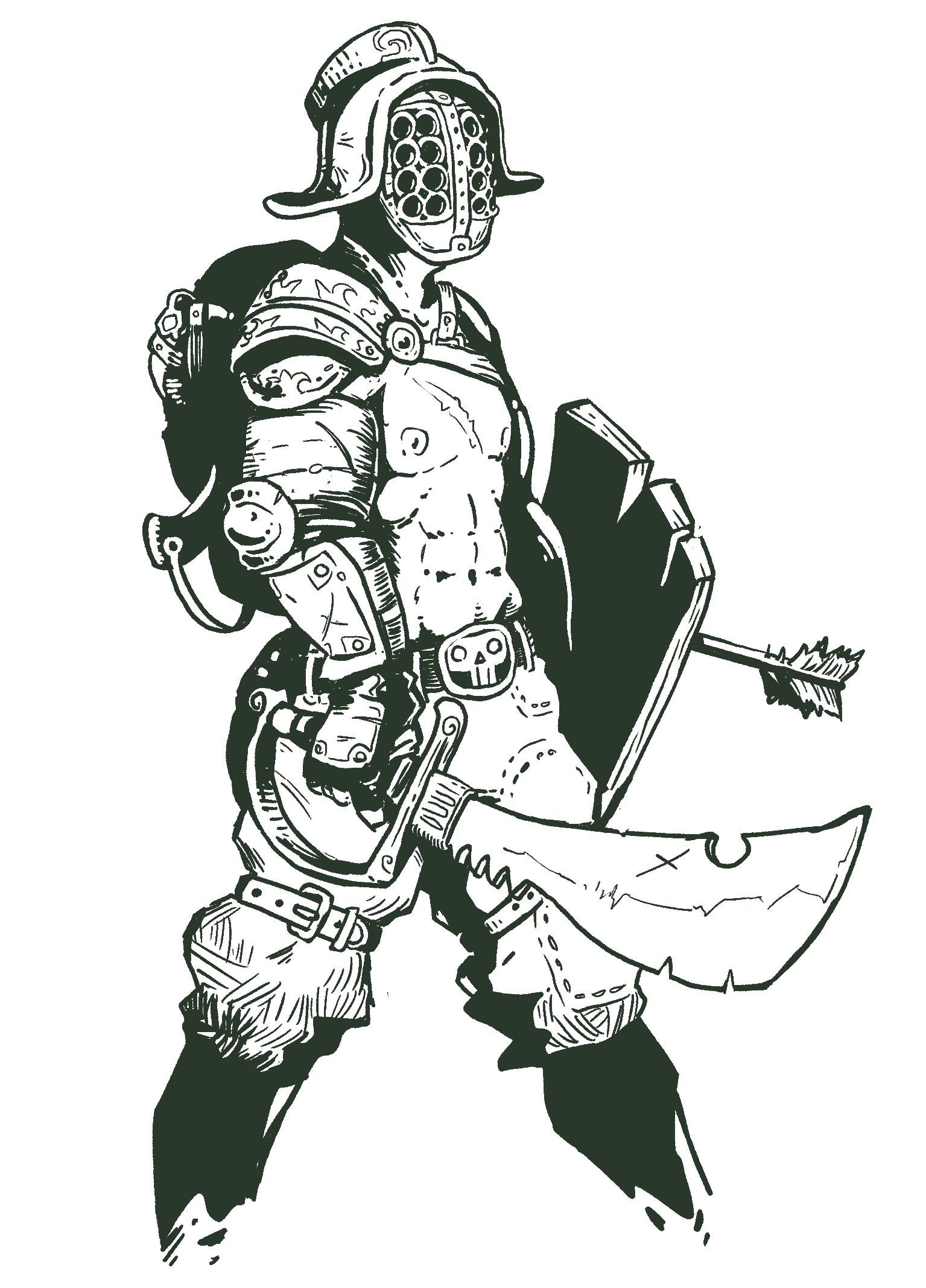
Gladiators are used to gambling their lives away for money. To them, the only difference is that Blacksalt island pays better.
They start with the battle trance special trait, allowing them to chain attacks, as long as they do the last blow to an enemy.
Equipment
Bag, Falchion (STR 3+1B), wooden shield(1 shield token), gladiator armor (1, 1 AP), cage helmet(1 AP), 2d6 silver coins.
Manoeuvers
- Bash: (STR 1, 1 action) Bash with your shield or weapon hilt, on a hit add a stun token to target.
- Disarm: (-DEX 1, 1 action) On hit the target drops the wielded weapon close.
- Glorious finish: (1 action) Perform a regular attack. If the gladiator kills the last enemy in the combat with this attack, the whole party recovers one presence fatigue or wound. On a failure the gladiator receives 1 presence fatigue. If the combat was purposely stalled, or the target is currently immobilized or harmless in any way, this has no effect; this only works when there's real danger involved.
Barbarian

What they lack in formal training, barbarians compensate with pure brutality. For them, attack is by far the best defense.
Barbarians have the berserker special trait which allows them to keep fighting while ignoring fatigue or wounds.
Equipment
Battle Axe (STR 4+2B), loincloth, war paint, medical supplies x 2, 1d6 coins.
Manoeuvers
- Roar: (PRE, 1 action) All enemies nearby. The barbarian must perform a presence test for each target. Causes a stun token. Can only be performed once per battle. Only works on enemies with the living tag.
- Charge: (1 action) The barbarian pushes the target backward, moving in a straight line, dragging the target. If charge hits a wall, place characters as close as possible at the wall, cause 1 wound and one stun token to the target. Uses regular move speed. Does not work on enemies with the ghost tag.
- Reckless attack: (1 action) Perform an attack that will cause 1 extra wound. Your next defense will have disadvantage.
Thief Background
Stalker

The stalker starts with the trait dauntless, making critical hits much more likely.
Equipment
Backpack, Ud10 throwing hatchets (DEX 1X+1), animal bones for crafting, Ud4 trapping kit, cloth tunic, 1d6 silver coins.
Manoeuvers
- Clean Kill: (1 action) Attacks with equipped weapon. Deals double damage if target is immobilized.
- Incapacitating strike: (1 action) Attacks with equipped weapon, reduce damage to 1 wound. Immobilizes target for one turn.
- Fast trapping: (1 action) Quickly arm and throw a trapping kit 3 tiles away.
Lone Rogue

Too smart or too dumb to hang out with other thieves, the lone rogue is someone who made a living by robbing people on the roads. The lone rogue is constantly on the move, chasing opportunities and fleeing from past mistakes. Often outnumbered, a lone rogue is specialized in getting in and out of combat quickly.
The lone rogue start with the trait slippery, allowing the rogue to spend a dodge token during the enemy turn to move 1 tile.
Equipment
2 short swords (STR 2+1), leather armor (1 AP), climbing tools, stolen golden icon, 1d6 silver coins.
Manoeuvers
- Wing it: (1 action) Throws a melee weapon using -DEX instead of STR with range of 3 tiles. Use the weapon's regular damage.
- Outsmart: Once per combat, you may use presence or intelligence instead of dexterity or strength.
- Quick thinking: (1 action) Test presence or intelligence on a success add 1 dodge token.
Hoodlum
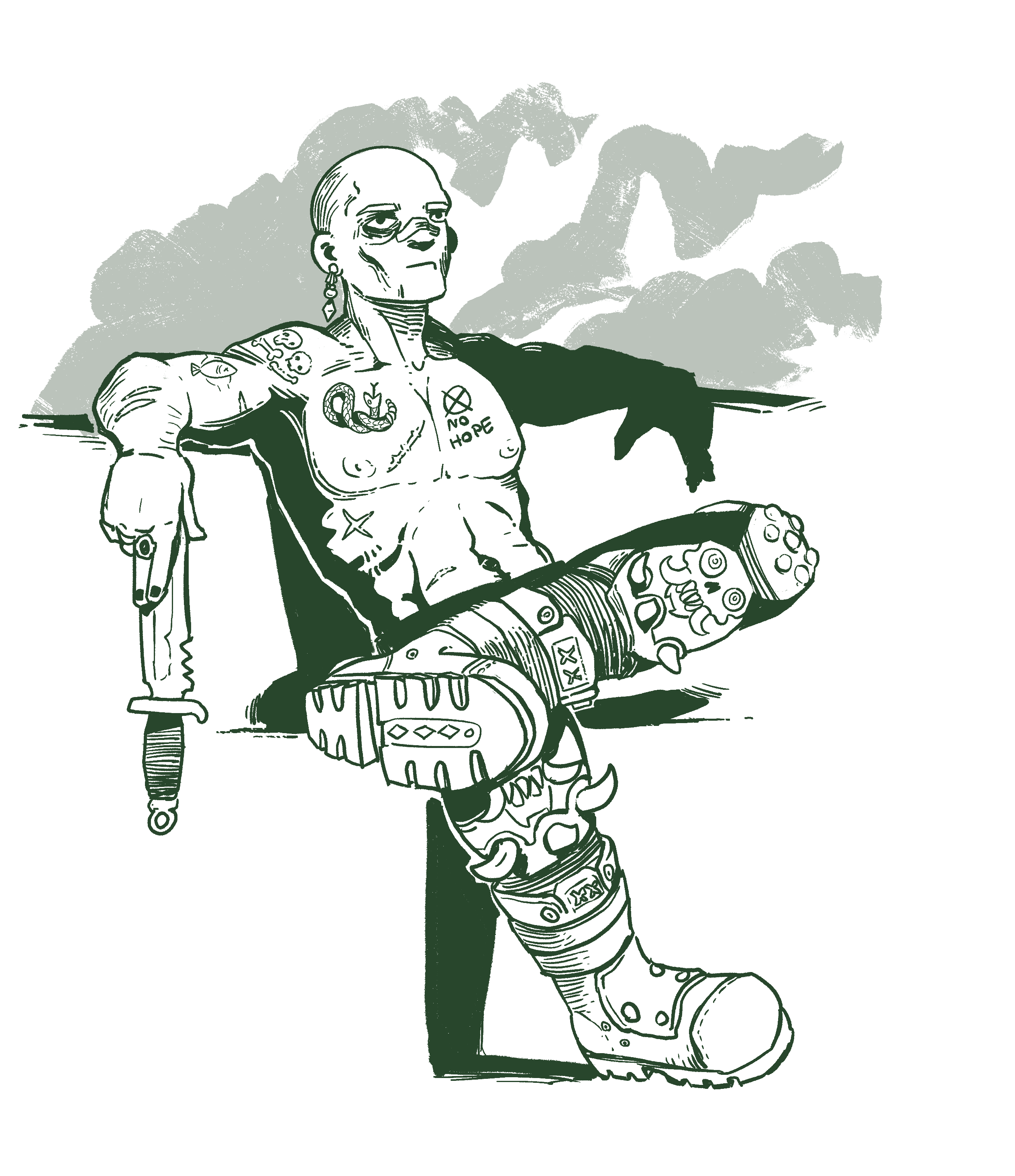
As a result of growing up in dangerous cities of the Empire, hoodlums are used to violence, and Blacksalt is full of opportunities for those who are capable of it. Hoodlums are specialized in overwhelming enemies that are outnumbered.
The hoodlum starts with the trait cold blooded, allowing them to ignore armor when attacking or defending from enemies that are flanked.
Equipment
Backpack, dagger (STR 1+3P), reinforced clothes (1 AP), lock-picking tools, 2d6 stolen coins, valuable stolen boots.
Maneuvers
- Dirty tricks: (1 action) 2 tiles. Kick sand in opponent's eyes or any other dirty trick. Any ally attacking this enemy has advantage. Only works on living enemies.
- Knife in the back: Once per turn, when attacking a flanked enemy with a dagger, you can perform a free attack. Roll an extra die for that attack.
- Going somewhere?: During the enemy actions, you may block an enemy from moving. Add a stun token to yourself. The enemy will still spend an action.
Moon-curser
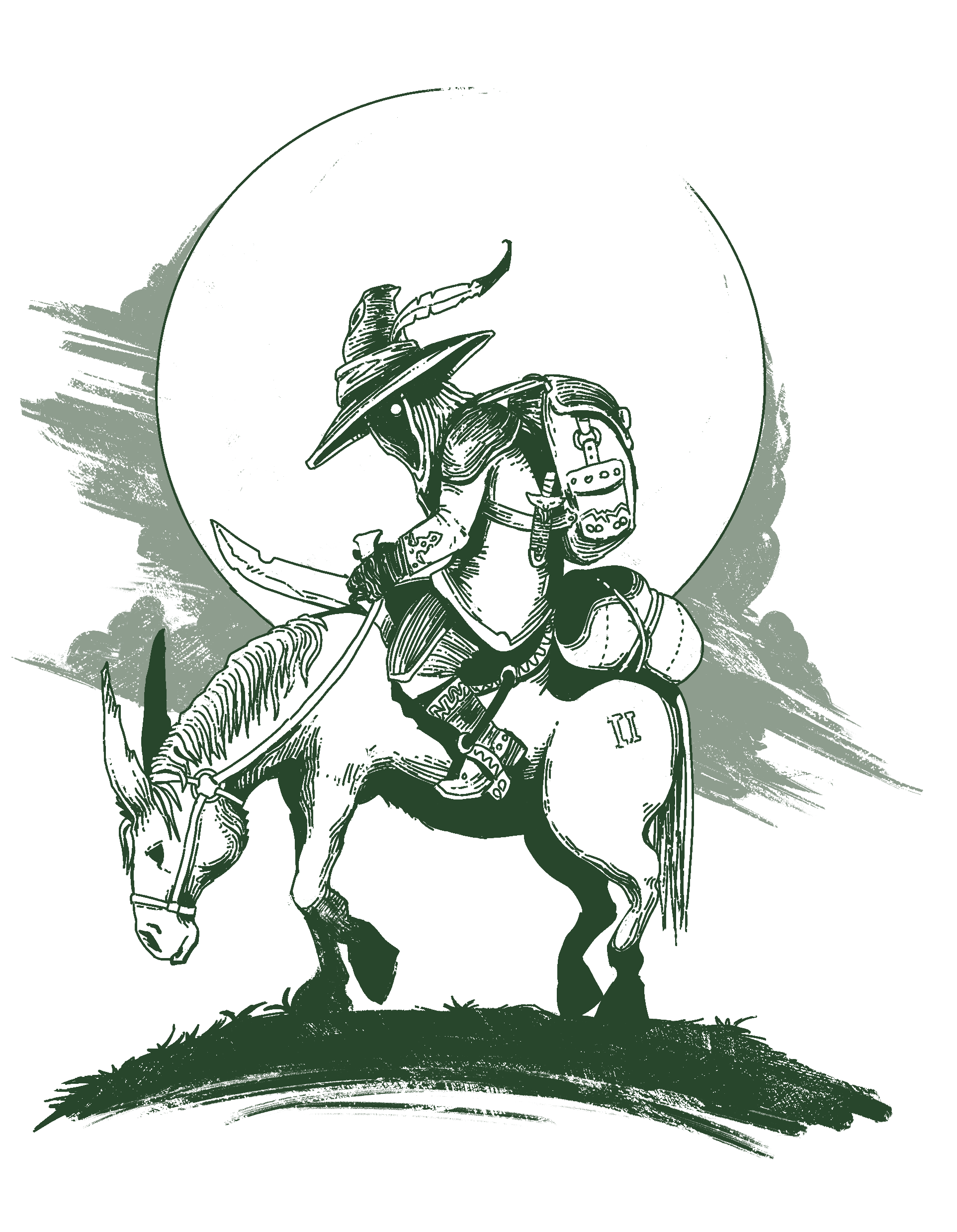
Specialized in getting in and out of places unnoticed. Moon cursers are the masters of contraband, infiltration and deception.
The moon-curser starts with the trait night-stalker, allowing them to ignore any darkness penalties.
Equipment
Backpack, pack mule, short sword(STR 2+1), black reinforced hood and vest (1 AP), Ud6 sleeping darts, 3d6 counterfeit coins.
Manoeuvers
- Fade into darkness: (1 action) Immediately hide in the nearby shadows, nearby enemies will not know where you are and will mostly likely change targets. Moving requires a dexterity test or be revealed. Cannot be carrying any light sources. Also add 1 dodge token.
- Blades in the dark: (1 action) Requires the target to be unaware of your presence and a bladed weapon. Attack normally then cause double the damage.
- Moving Shadows: Spend one dodge token to perform an extra action.
Schools of Magic
Time in spell descriptions
When a spell mentions turns without specifying if it's an exploration turn or combat turn, it means that the context should be used. If that spell is cast during combat, it will last that many combat turns; if it's cast during exploration, it will last that many exploration turns.
When a spell has a duration that explicitly mentions exploration turns, it can also be cast in combat, but remember that the whole combat lasts only one exploration turn.
When rolling for duration, unless specified otherwise, the roll is made by the player as soon as the spell has been cast.
Necromancers of Yadar
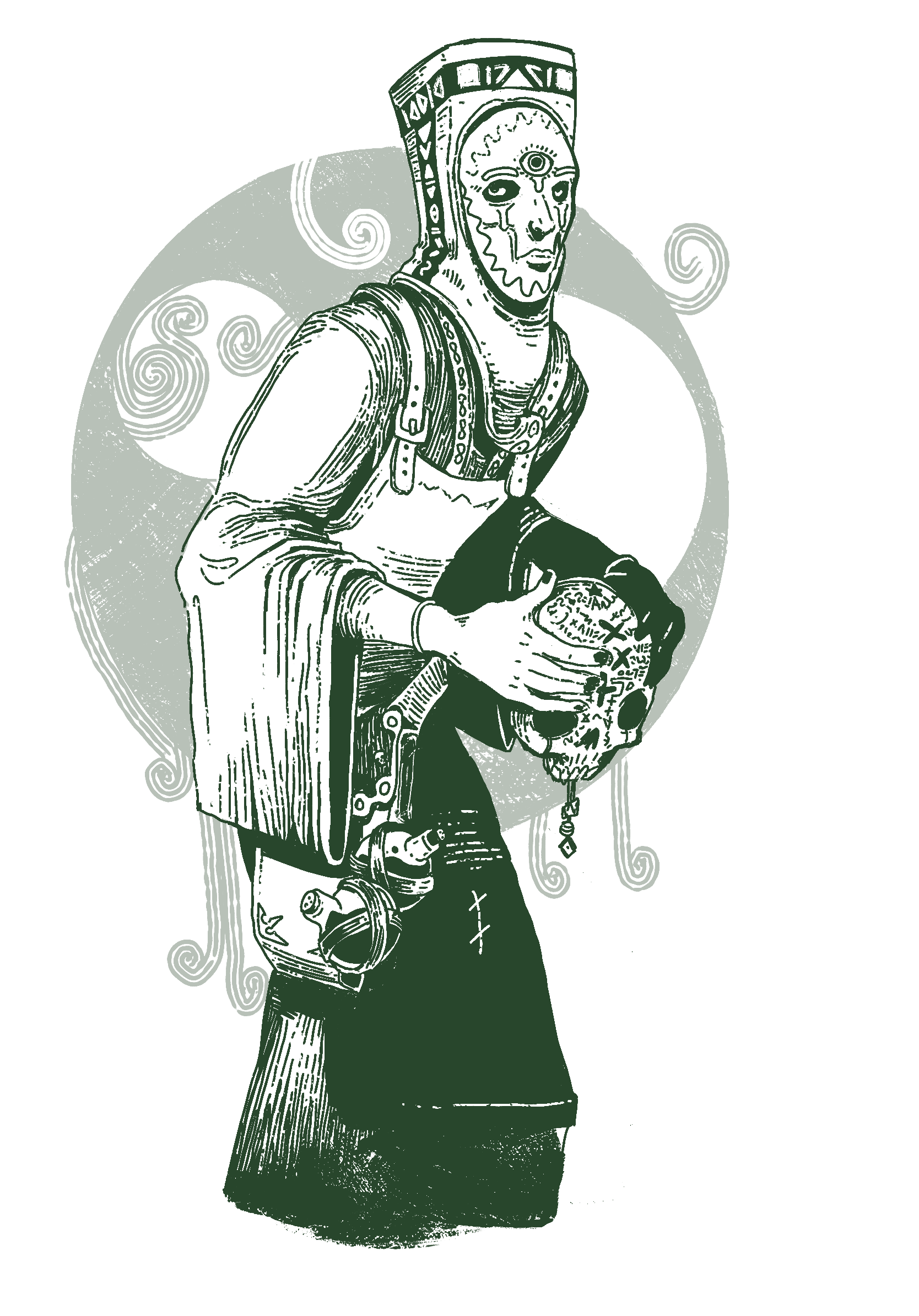
Controlling the dead and the dark forces of the void is the Necromancers of Yadar's specialty. Their techniques are strictly forbidden in most places of the world, but in Blacksalt, no one cares - they will take whatever works.
Tales tell that Yadar is a small island, hidden in the black sea, populated only by the undead, and ruled by three Necromancers. No one knows exactly where the island is, but Yadar disciples are everywhere, spreading the necromancer's teachings to the rest of the world.
While necromancers are not combat focused, their high-utility spells can be used in clever ways to help solve different problems.
Spells
- Pain: 2 actions during combat. Add 3 stun tokens to a nearby living or undead enemy. Reduce the number of tokens using the enemy resistance.
- Command undead: The wizard may issue one simple command to an undead. That undead wil try to follow that command for the next 2 exploration turns. Only works on undead up to level 3. The command may be "renewed" by casting the spell again. If cast during a combat, it will last through the whole combat and for the next exploration turn. If unable to follow the command for any reason, the undead will just stay in place without moving.
- Explode corpse: Explode any corpse that the dead vigil hasn't set upon yet. Causes 2 wound to everyone close, which can be reduced by armor and resistances. Also works on undead under the Command undead spell.
- Phobia: The target nearby creature gets terrified of a chosen person or object for 1d6 turns.
- Black night: Absolute darkness covers a nearby area; anything close to that area is engulfed in it and can't see. The wizard can see normally through the darkness.
- Nightmare: A target nearby creature immediately falls into a restless sleep, having horrible nightmares. The creature will wake up normally if disturbed. Only works on creatures that can sleep. The creature can be woken up normaly.
- Bonedance: Bends the bones of a nearby creature in an unnatural way for the duration of the combat. All tests made against that creature are made with advantage. Halves that creature move speed.
Equipment
Sacrificial dagger (STR 1B+1), chalk, poisonous vials, inscribed skull (grimoire and conductor), cloak with mask, 2d6 silver coins.
Alchemists of the Golden Ridge

The secret order of the Golden Ridge is focused on transmuting and creating magic potions and artifacts. For centuries they stayed in the Golden Ridge, extracting and transmuting the local fauna and flora, until the news of Blacksalt reached them. The number of supernatural elements in Blacksalt is endlessly valuable to them.
Spells
- Glue: Creates a strong adhesive that covers something nearby. In combat, this locks an enemy in place; they must succeed a test and spend one action to get free.
- Machine spirit: Fixes a target machine or metal armor. Doesn't work on machines that are too big.
- Smoke form: The wizard turns into smoke, and can move around for a few short seconds, or one combat turn (2 actions). The wizard cannot be harmed while in smoke form. If, after moving, the wizard has no space to turn back into human form the wizard will immediately die, while trying to occupy any available space.
- Silver cannon: The wizard can use silver coins as a ranged weapon attacking with INT 3P. The wizard must spend 1 silver for each shot.
- Transmute: 2 actions in combat, 1 exploration turn or free action during camp. The wizard may mix elemental extracts to create tonics. Requires an alchemic toolkit and a bottle.
Transmuting
Elemental extracts can be found in corpses and monster remains. To get the elemental extract from a corpse, a wizard requires an alchemic toolkit and one exploration turn. For each point in intelligence proficiency the wizard can get the extract from an extra corpse nearby in that turn. Check the bestiary for what type of extract an enemy has. If there is nothing on the enemy sheet, that enemy has no viable extract.
A single inventory slot can store two different extracts. You can stack as many extracts of the same type in the same slot as you want.
| Element | Yig | Grai |
|---|---|---|
| Flame | -1 | +1 |
| Water | +1 | -1 |
| Smoke | 0 | -1 |
| Necro | -1 | 0 |
| Rot | 0 | +1 |
| Ether | +1 | 0 |
To make a potion, the wizard can mix any number of extracts available. Add all from the Yig column first, then from the Grai column second. The numbers must match one of the recipes.
A Healing Tonic (2,0) can be made adding water (+1, -1), ether (+1, 0) and rot (0, +1). An alternative would be adding ether (+1, 0) twice.
| Potion | Yig | Grai | Effect |
|---|---|---|---|
| Healing tonic | 2 | 0 | Heals 1 intelligence or dexterity wound. Ud4 uses. |
| Potion of giants | 0 | 3 | Heals all strength wounds and fatigue. Ud4 uses. |
| Explosive potion | -2 | 2 | Can be thrown to a nearby tile, causing 2 wounds to anyone in that tile and 1 wound to anyone close; damage can be reduced. |
| Tonic of bravery | 1 | 1 | Character can't get terrified during this expedition. |
| Anti-poison tonic | 1 | -1 | Cures Nausea and simple poisons. |
| Mercurial tonic | 0 | 0 | Get 1 extra combat action for this and the next Ud4 turns (test at the end of the turn). |
| Tonic of focus | -1 | -1 | Cures 2 presence wounds. |
| Purging hot-water | +1 | +1 | Cures 2 strength wounds, causes 1 presence wound. Ud4 uses. |
Equipment
Cane (conductor, STR 1+1), alchemic tools, tattered trench coat, old tome (grimoire), 3d6 silver coins, 1 gold coin.
Thaumaturgists of Ravenhome

Castle Ravenhome is a prestigious institution that offers daily classes, teachers and a title to anyone who completes the program. Ravenhome selects children from all over the world by a mysterious process, and invite them to study there. More than half of the students die horribly during the course, though.
Spells
- Magic Missile: During this combat, the wizard can use magic missiles as a ranged weapon, attacking with INT 3.
- Arcane prison: A target person or object gets trapped in an arcane crystal, locked in time and space. They can't act or be interacted with for 1d6 turns.
- Magic Shield: During this combat, the wizard gets a shield token at the start of the wizard's turn.
- Arcane Seal: Protects a nearby person or object from spells for 1d6 exploration turns.
- Pocket reality: Creates a bag that looks very small on the outside, but has 3 slots. Anything inside does not count towards encumbrance. It lasts until the end of the expedition.
- Arcane fire: Target 2 nearby tiles: anything standing in those tiles takes 2 wounds per turn, which can be reduced. Lasts until the end of the combat.
Equipment
Small Knife (STR 1+1P), ornate garments, Wand (conductor), scattered notes (grimoire), cloak, 2d6 silver coins.
Wandering Mystics
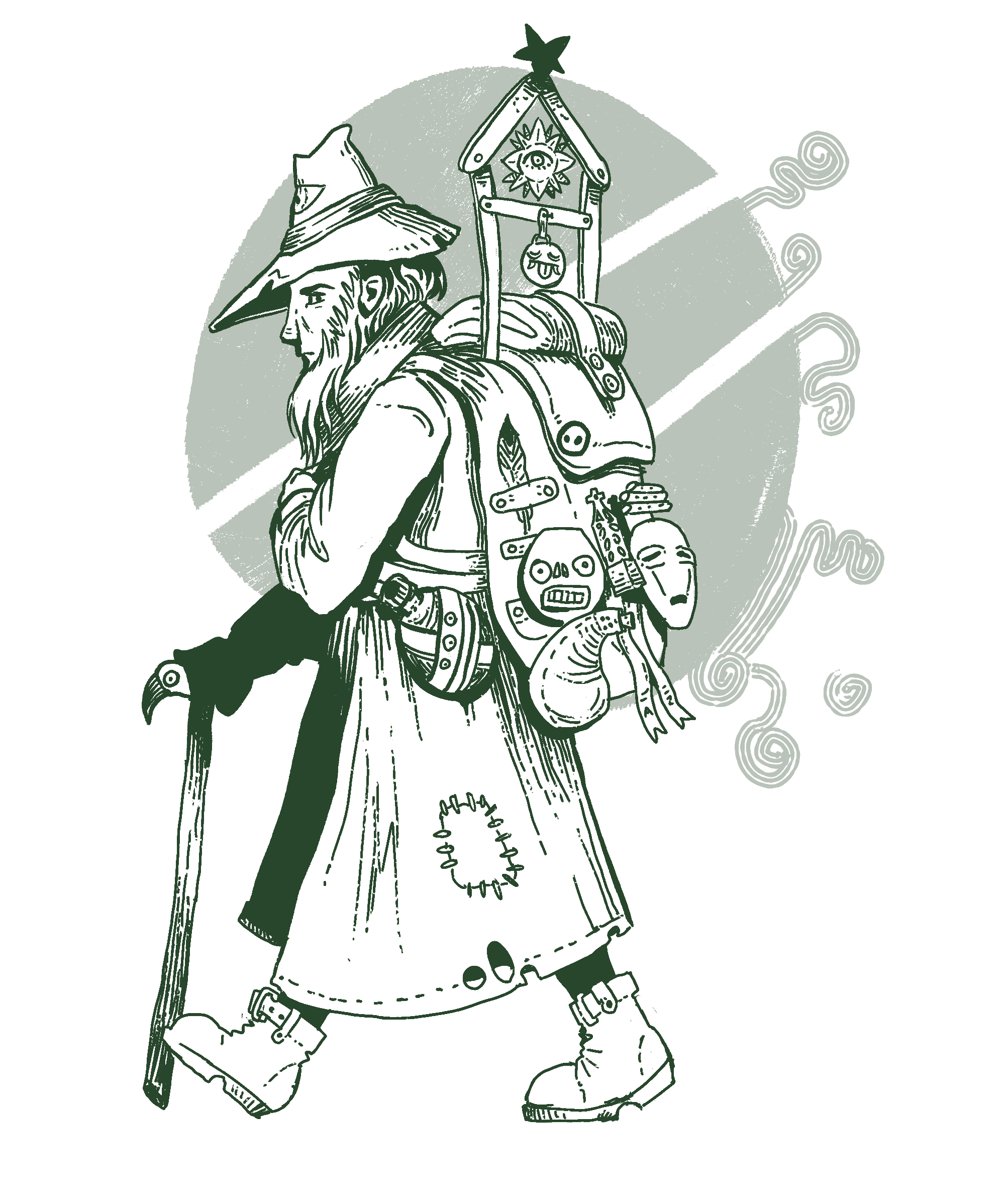
Their order is not hierarchical or ordered; rather, they adhere to a strict moral code. They typically select children who are lost as their apprentices. It is common for them not to stay in a place for too long, and they usually share their observations with fellow Wanderers through writing with invisible ink.
Most places do not welcome them and see them as tricksters and freeloaders.
Spells
- Magic mouth: Creates a magic mouth at a far location, which will repeat a phrase for the wizard, loudly or quietly at the wizard's discretion.
- Arcane eye: The wizard can see through a floating, glowing eye that can be controlled. The eye can't move further than far away from the wizard. If the eye gets damage, it disappears and the wizard receives 1 intelligence wound.
- Knock/Lock: Locks or opens a door nearby. Will unlock any simple mechanical lock.
- Mind fog: A close target cannot form memories of the next 1d4 turns. The GM should roll the dice in secret.
- Weave fate: Roll up to the wizard's available intelligence dice and keep them around. You may use them to replace any dice result you roll in the next 2d6 exploration turns. For every dice you don't use after that, receive one intelligence wound. The GM should roll the timer and keep it in secret.
- Mystic ink: Creates an glowing colorful ink that only other wizards with the mystic ink spell can see. The wizard's hands can be used to paint with this ink.
- Morbid touch: Conjures a see-through hand with a morbid aura toward a nearby target. Attacks with (INT 2P), then dissipates.
Equipment
Backpack, Cane (STR 1+1, conductor), wine, holy water, healing tonic, heavy cloak (AP 1), 2d6 silver coins.
The Awakened
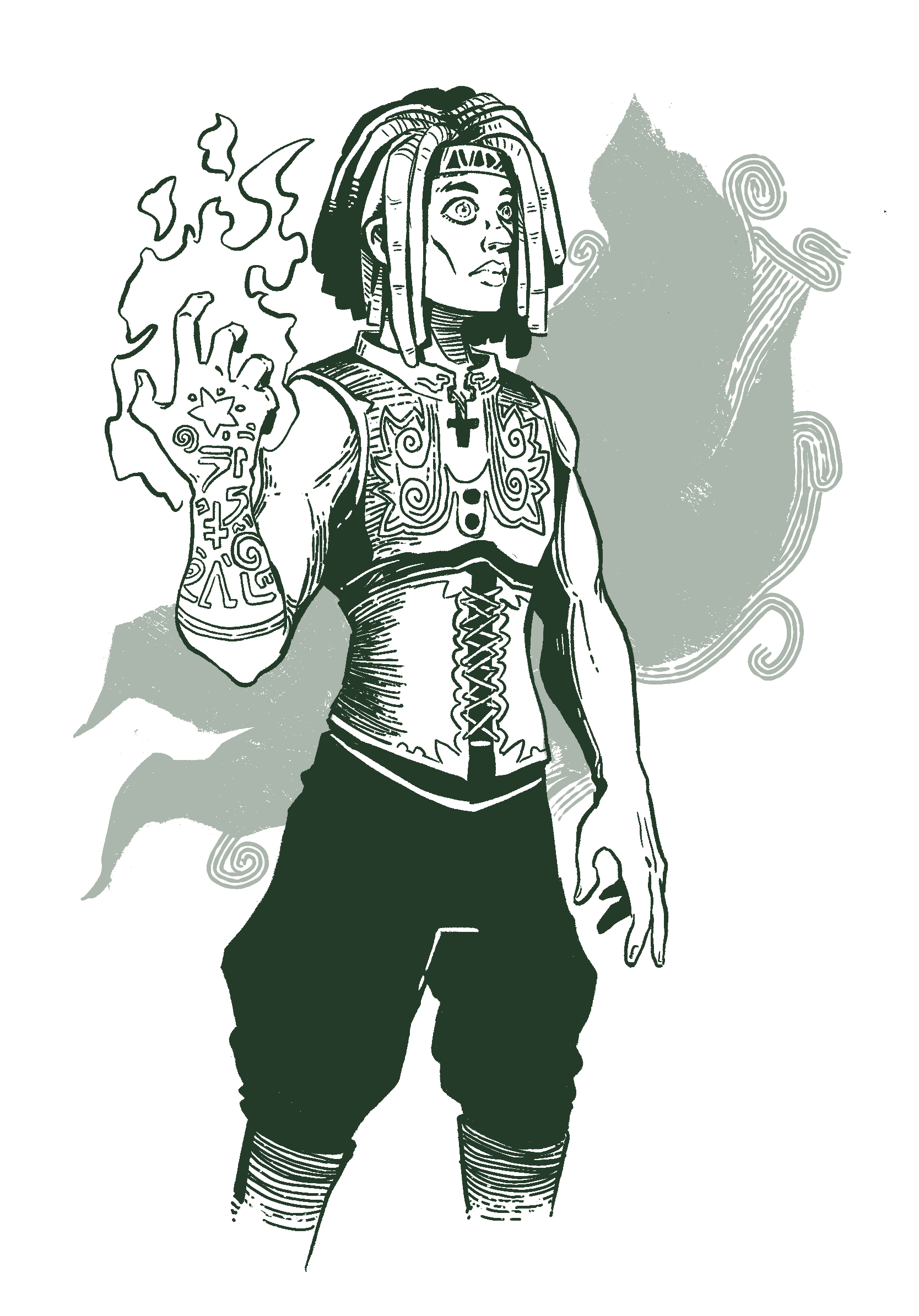
Most Awakened believe themselves to be cursed; they never studied magic, but the Void found them. Although they don't fully comprehend their powers, they've learned to use them to survive. The Awakened don't need a grimoire and can meditate to remember spells.
Spells
- Light: Illuminates nearby room for 1 decay.
- Haste: A nearby creature has their movement speed doubled until the end of the combat.
- Shackles: The wizard creates magical shackles that hold a nearby creature in place, adding 2 stun tokens per turn. It lasts as long as the wizard keeps channeling the spell. The wizard can't move or act while channeling.
- Telekinesis: The wizard may pull or push a close object using intelligence as strength. Or use any weapon with intelligence as strength for one turn.
- Hover: The wizard can hover one meter above the ground, water or similar. Lasts 1d6 turns.
- Nether swap: Immediately swaps place with a target creature.
- Soul punch: Set your cursed hand aflame and punch a close target. If attack is successful cause 3 damage instead, that damage cannot be reduced by armor or resistances.
Equipment
Cursed hand (conductor, STR 2+1P), ashes of insight, ornate clothes, 1d6 silver coins.
Gods

Clerics always follow one god and one god only. Some won't even believe in other gods. While the divine effects of the clerics can easily be felt and seen through the world their actual existence is hard to be actually proven. Some even say that there are no gods in this world, and all clerics are actually just magic users that don't know their own potential.
The main consensus is that are 2 types of gods in the world, the old gods and the new gods.
Old gods are the ones that lived before the creation of the current world. Before this world, there was another one, and some event caused it to be destroyed, while creating the current one. These beings are so powerful that they didn't fade when their world was destroyed. Not much is known of them and their worship is strictly forbidden in most cultures, but secret cults can be found all over Blacksalt island nonetheless.
The new gods are the gods that appeared after the origin of the world. They are the ones worshipped by most humans and other intelligent creatures.
Goshkalon
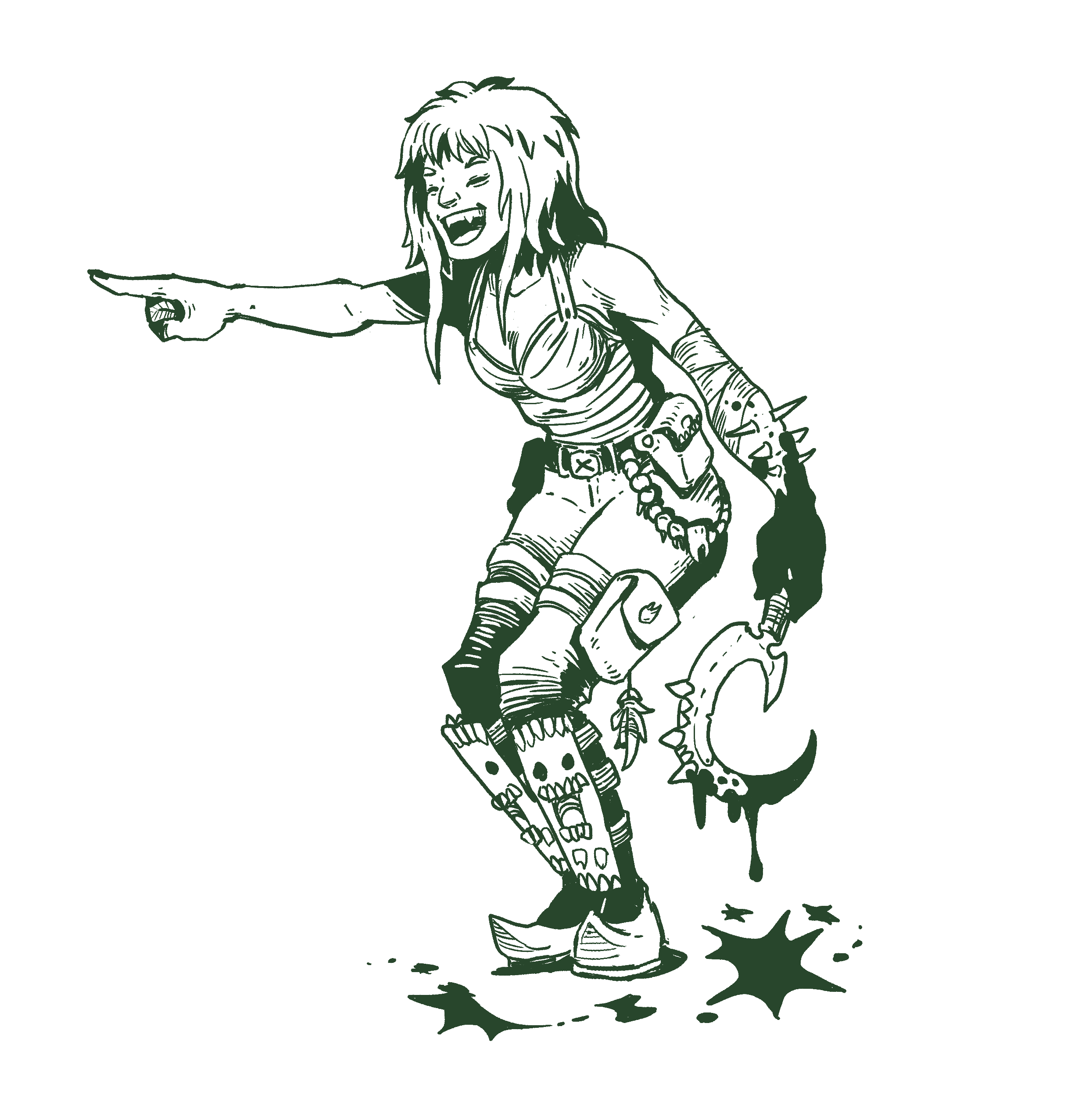
The God of Laughter, Goshkalon is a quite controversial god. His influence is mostly perceived as benign, but he's worshipped by goblins, gnolls and other evil cults. His blessings are never straightforward, usually having some ironic humor to them, never really fixing any real problems, only numbing the symptoms and effects of them.
Often venerated at the sites of great tragedies, gathering followers are among the desperate and hopeless. Worshipping Goshkalon gives its devotees so much bliss that some will pray so obsessively that they often die from hunger, thirst, and exhaustion without even feeling it.
Sacrifice: Offer a number of teeth to a fire, which will boil and disappear. For every handful of teeth roll a risk dice (1d!): if triggered, Goshkalon will be pleased.
Equipment
Scythe(STR 2X+2), clay statue (holy symbol), improvised armor (1 AP), a purse full of teeth, 3d6 silver coins.
Prayers
- Bliss: (Close) Choose one affliction the target currently has; during this expedition, that affliction will have no effect, but can't be removed.
- Euphoria: (Close) Target recovers 2 fatigue. During this combat, the target can ignore wounds and fatigue when counting available dice. They can still receive wounds and fatigue normally.
- Ignorance: (Nearby) The target can't use any INT based attacks for 2d6 rounds.
- Numbness: (Nearby ally) Heal all PRE wounds, but cause one fatigue in STR and DEX.
- Hyperfocus: (Nearby) For the next 1d6 turns of combat, the target will have 3 actions, but can only perform the same action. The target can change actions between rounds.
- Apotheosis: All nearby allies recovers all fatigue, then, next turn, get it back.
[Prayers]
Cador

The God of death, Cador, wants order to be brought back to the world. Cador is the great enemy of the undead; his zealots hunt them down and seal their corpses so the dead vigil doesn't set in. Cador's clerics start with the skill ward the dead.
Sacrifice: To please Cador, the cleric must capture and then kill an undead during the sacrifice ritual.
Equipment
War hammer (STR 1P+3), Ancient talisman (holy symbol), Ud6 flasks of holy water, thick cloak (1 AP), 3d6 silver coins.
Prayers
- Mercy: Immediately kills close any creature that would die if it received 4 wounds or less.
- Seal: Creates a 3m line that no undead can cross during this expedition.
- Borrowed Time: Target cannot die for the next 2d6 turns. All wounds are placed normally and after the effect is done, the target can die again.
- Judgment: All undead nearby receive a stun token and a wound.
- Memento mori: Target undead starts taking 1 wound per turn. Lasts 2d6 turns.
- Dirge: Place a token on a nearby target that lasts 1d6 turns. If that target dies with the token, all nearby living creatures heal 2 wounds.
Yulak

God of purity, Yulak is not only the god of purity but also the god of fire and punishment. She is merciless and so are her disciples.
Sacrifice: To please Yulak, the cleric must self-flagellate, causing 2 wounds and bleeding to self.
Equipment
Notched whip (DEX 1R+2B), torture equipment, rope, book of sins (holy symbol), tattered cloak, 1d6 coins.
Prayers
- Detect Evil: Everything nearby that's evil or undead glows with a green light, lasts for 1d6 turns.
- Righteous Fury: A close target gets 3 extra dice in the next row and the angry affliction. Add one wound to any damage caused by the target in the next row.
- Cleansing Flames: Holds a close target while chanting, burning the target from inside, attacking with STR 1PR+6. If the target is an ally, cure any affliction, except cursed, doomed or plagued.
- Martyr: Cause one wound to the cleric: all nearby allies recover from bleeding, terrified, shaken and sleepy.
- Purge the filth: A target nearby gets extremely nauseous, vomiting a black slime and can't act for 2 combat turns or 1 exploration turn. After that, the target heals 3 wounds.
Akhzu

God of nature and chimeras, Akhzu embraces the chaos and the natural flow of the wild.
Sacrifice: To pacify Akhzu, the cleric must feed the earth, burying 2 rations.
Equipment
Flail (STR 2X+2), human skin drum (holy symbol), leather armor (1 AP), 2d6 silver coins.
Prayers
- Season of changes: Choose a nearby ally. That ally may move any number of wounds and fatigues from one attribute to another.
- Eyes of the forest: Creates a magical eye on a Distant tree that you can currently see. You can see though the magical eye during the current expedition. The eye dies if the tree is cut.
- Prayer of Summer: Repair one armor point from everyone nearby, including enemies.
- Prayer of Spring: Cures one wound from everyone nearby, including enemies.
- Prayer of Winter: Causes 2 wounds to everyone nearby; the cleric and allies receive only 1 wound.
- Prayer of Autumn: A weakness takes over everyone nearby, including allies and the cleric. Removes all shield and dodge tokens.
Kaal Rafir
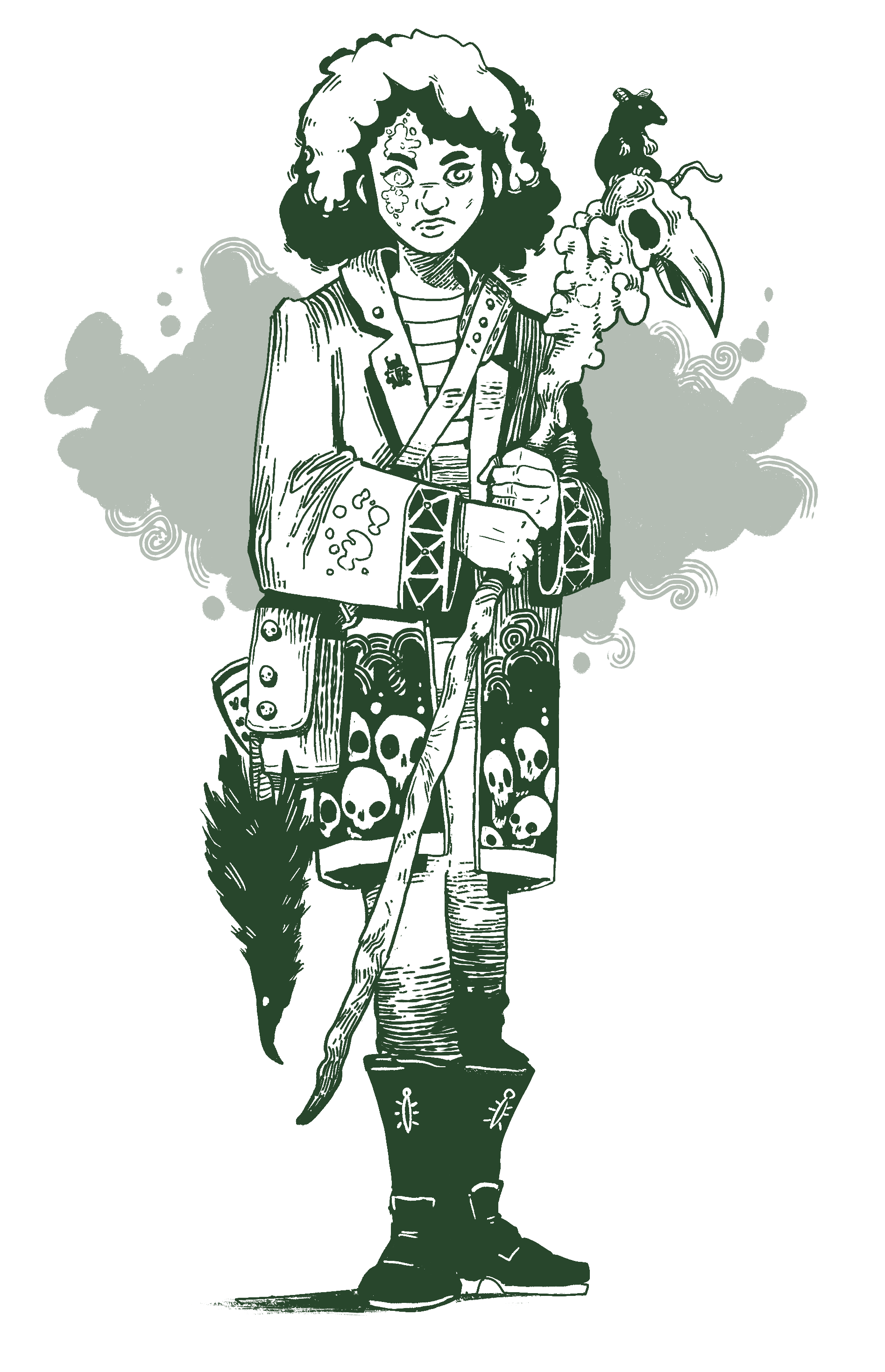
The god of plague and diseases, Kaal Rafir, is the first of the new gods. Originally, he was one of the old gods, the god of entropy and cold, but after siding with the new gods during their uprising, he was punished.
Kaal Rafir disciples usually have small mice, cockroaches or locusts as companions. Those companions can be ordered around for very simple tasks, but they are not intelligent nor can communicate. A companion has 1hp. If for any reason a companion dies, a new companion will show up during next camp, the cleric can choose a different animal for the new companion.
Sacrifice: Kaal Rafir doesn't require sacrifices, but praying to him at the camp will restore the cleric's powers. But, when angered, the whole party takes 2 non-lethal presence fatigue.
Equipment
Diseased Staff (STR 2X+2), dead animal (holy symbol), leather trench coat (1 AP), small animal companion, 1d6 silver coins.
Prayers
- Hold: Paralyzes nearby target for 1d6 turns, reducing the target's actions to zero.
- Silence: Absolute silence covers a nearby area; no spells may be cast.
- Swarm: Summons a swarm of insects that can be commanded by the cleric.
- Entropy: Causes everyone nearby, except the caster, to spend an action or take 2 non-lethal fatigue.
- Decay: A nearby target is cursed for 5 turns, taking 1 non-lethal fatigue at the start of the turn.
Equipment
Flail (STR 2X+2), forbidden scriptures (holy symbol), leather trench coat (1 AP), 3d6 silver coins.
Old Gods
Ulass
The Never-ending.
Achernar
The silver star.
Gyrrath
The hungry one.
Ngaazh'theg
The eye of the sea.
History
Origins
Blacksalt is an ancient island, found more than a thousand years ago by several lost sea travelers. The island apparently had risen from the ocean floor by some volcanic activity and was covered in a thick layer of black salt and algae. Ancient traces of an underwater civilization were found there, intriguing the people from the main continent, but it was the island's rich mineral resources and fertile land that paved the way for fast colonization.
The island was lawless, and many different groups started settling there. Castles and strongholds were built and conflict between the different settlements began as soon as they met. The conflict proved extremely expensive to everyone involved and the Treaty of Yoros was created, dividing Blacksalt between different kingdoms that would stay in their territory.
This fleeting peace allowed major infrastructure to be built and trade routes to be created.
The fall
Then suddenly the first antediluvian catacomb was found, changing everything. Down in those caves the kings and queens would cohort with ancient beings giving them extraordinary powers, and they didn't want to share. Aided by the ancient beings' magic, the war between settlements raged on, devastating the land, creating famine, supernatural plagues and eventually the infamous dead vigil would strike. No one knows who or what caused it, but suddenly the dead started to come back to life hunting down the living. In the current state of the island the dead were by far a majority.
Not much was left of the old kingdoms, only small fortified settlements, castles haunted by the undead and isolated hamlets. This caused Blacksalt to be mostly abandoned and forgotten.
Renaissance
Centuries later, the hordes of the undead had dispersed, and most of the tales of Blacksalt kingdoms forgotten. Pirates re-discovered the island and started trading with the few that were still living there. As soon as the ancient artifacts were found news spread fast.
This coincided with a major war happening in the main continent, where a gigantic military and political unity known simply as The Empire started dominating every kingdom it could reach. To win this war, magical artifacts were necessary and the Empire financed expeditions to Blacksalt and payed high prices for anything found. This "gold rush" was intense and fast, and several settlements were rebuilt in a few months - most notably Yoros, the biggest port-city of Blacksalt.
Geography
Blacksalt is a large island in the southern hemisphere of the planet. The climate is warm in the north and gets wet and cold in the south.
The terrain is mostly flat and near the sea level in the in the north, while mountainous and rocky in the south.
The northeast part of Blacksalt is colloquially known as Yoros Island, while techinically being part of Blacksalt, Yoros river separates most of it from the rest.
On the east part there are five smaller islands closing the Kumar Bay, with Saint Julien Isle being the biggest and the only one populated.
Blacksalt Island
Very early work in progress of the island map. The final version will be interactive.

Yoros
Settlement size: City (5)
A major port city in Blacksalt. Famous for its high quality wine.
Yoros is bursting with commerce and is the main connection between the main continent and Blacksalt. The Emperor is the official ruler of Yoros, but the empire's influence is very limited in Blacksalt, with the Guild of Commerce having all the real power.
Kumar Port City
Settlement size: City (5)
A big port city that services the Kumar Bay. The official use of this port is to transport large goods to Yoros, but, in actuality, Kumar is the center of a huge smuggling network, sending magical items to the highest bidder.
The city is in a swamp area rich in natural oil, and since they don't have a lot of available farmland, most of their food comes from ships or from Brutburg.
Steinsburg
Settlement size: Stronghold (4)
A stronghold that once held the undead march centuries ago, Steinsburg is nowhere near its former glory, but is still a sight to behold. The stone stronghold is built on the mountains and its huge walls are still impenetrable.
The people there still live under strict military tradition and are always alert for any undead threat.
Brutburg
Settlement size: Stronghold (4)
A military stronghold in the cold south. Once a noble house that fought valiantly against the undead during the first dead vigil, now decadent and ruined.
Somehow, the farmers of Brutburg manage to plant even in the harsh cold; some say the food of Brutburg is grown using abominable rituals.
Trinta
Settlement size: Fief (3)
A fief ruled by the tyrant lord Ishnar Zul, descendant of a long line of lords from the early days of the exploration of Blacksalt. Trinta has huge farmlands and lots of cattle, being responsible for most of the island food production.
The sample dungeon takes place in Trinta.
Luna
Settlement size: Fief (3)
A farming fief, isolated from most commercial routes, Luna is a somewhat peaceful settlement in the cold plains. Luna was once a military stronghold, but that fortress is long abandoned.
The people of Luna avoid going near the stronghold, and local stories tell of people disappearing inside.
Luna is uncomfortably close to Fallen Agnar, but has never been attacked by the undead from there. Some whisper of a mysterious pact between them.
Cefit
Settlement size: Hamlet (2)
A small trading post set in the middle of the road between Brutburg and Kumar Port-City. Cefit consists of a small inn, a few farmers and shops. The people that live here are mostly recluses and prefer to stay out of outsider's business.
Fallen Agnar
Agnar was specially hit by the dead vigil centuries ago, being completely destroyed. It quickly became the central point from where the undead hordes came. Organized undead marched down to Brutburg and Yoros, spawning Tales of a powerful necromancer lich controlling the hordes. Those tales were never confirmed, though.
Today, Agnar is the haunted remains of a city, where not even the bravest explorers dare to venture.
Other Places
The Capital
Golden Ridge
Island of Yadar
Ravenhome
Expedition

During the expedition, the characters venture into the depths of the earth in search of some reward. Raiding in caves and dungeons is not a healthy job - it takes a toll on the player characters. Time passes in a weird way down there: minutes turn into hours, and hunger and thirst are even deadlier than the monsters inside.
The expedition can be broken down in 3 phases:
- Exploration when moving between rooms, looking for treasure and solving mysteries.
- Combat when encountering enemies and resolving conflict.
- Camp when resting and tending wounds.
The story will always be in one of those phases. During each phase, the players can choose specific actions.
During the expedition, it's useful to use a map with miniatures, ideally with each tile representing around 1.5m. This map should only include what's currently visible to the players.
Exploration
During the exploration phase, characters can move to another place in the dungeon, fix their equipment, interact with their environment and other various things, but every time a player attempts an action in the dungeon, a turn passes. We measure that using exploration turns. Exploration turns are a valuable resource that the players must carefully use as a group, since every time a turn passes, some trackers will advance, usually causing problems for the adventurers.
Any action a player chooses will spend one or more turns. It doesn't matter which player does the action or if the action is done as a group - the turn is spent regardless. Players should avoid splitting up for that reason: if they are divided, they will spend many more turns. Turns during exploration are not only a measure of time, they measure the stress, fatigue and the general energy of the characters. That's why if 2 or more characters decide to simultaneously do 2 actions, they would spend 2 turns.
Decay
The decay tracker is one of main the things that will keep the players from stalling in the expeditions. It's a tracker with 6 steps. Every turn, the decay tracker should advance, meaning that every 6 turns of exploration, all player characters roll from the decay table. The GM may delay the decay tracker, if the situation is dire enough.
If the adventurers are in a safe place, outside of a dungeon and with no immediate danger or pressure, the GM doesn't advance the tracker. A good practice is to only start the decay tracker when the adventurers enter the dungeon, tomb or whatever place they are raiding.
| Roll(2d6) | Effect |
|---|---|
| 2 | Press on (No effect) |
| 3 | Fatigue |
| 4 | Terrified |
| 5 | Sleepy |
| 6 | Parched |
| 7 | Advance the doom tracker |
| 8 | Hungry |
| 9 | Hopeless |
| 10 | Angry |
| 11 | Wound (player choose location) |
| 12 | Equipment breaks/lost |
If a character would receive an affliction that they already have, keep adding 1 to the result until a valid result has been reached. After decay happens, players should also roll the usage dice for any torch, lanterns, etc.
Omens and Doom
The adventure should have a doom tracker, to which only the GM has access. The adventure should have a list of things that happen when the doom tracker reaches a certain number, but they should always involve something bad. Raiding dungeons and abandoned places wakes up things better left untouched. Reaching the maximum value of the doom tracker means certain death.
The doom tracker represents the adventurers meddling in the dungeon, making noise and awaking whatever lies inside. Advancing the doom tracker too much usually results in monsters appearing, rooms collapsing and traps being triggered. The last step on the doom tracker usually involves a very hard fight. The doom tracker is bound to a location; if the adventurers go to a new place, a new tracker should be started. If they re-visit a location, use that location's old tracker.
Every time the doom tracker reaches an effect, also advance the omens tracker.
The omens tracker is about the state of the party itself. The omens tracker has 2d6 steps: every time the omens tracker fills up, roll from the omens table and make a new tracker, rolling for the size again. Changing locations does not reset the omens tracker. If the party can't fulfill the omen effect completely, discard/break as many items as possible. Add one and only one more time.
| 1d6 | Effect |
|---|---|
| 1 | The party chooses 2d4 equipped items; they are broken now. |
| 2 | The party rolls from the decay table twice. |
| 3 | The party must discard 2d4 units of water. |
| 4 | The party must discard 2d4 rations. |
| 5 | The party must discard 2d4 torches. |
| 6 | The party must discard 2d4 magical item or magical scroll. |
Exploration Actions
Here's a list of common exploration actions. When not sure which action you want, you can always perform a freeform action.
Move (1 turn)
Move to a different location, usually to a different room in the dungeon. The GM can ask the players to spend more than one turn if the distances are big enough.
Moving often leads to combat encounters.
While moving in the exploration phase, the players don't need to worry about movement speed and may move their miniatures freely, as long it makes sense for the GM and to the other players.
When opening doors, turning corners or revealing something, the GM should always ask the players to position their adventurers on the map, just in case something awaits them on the other side. It's also important to always pay attention to where the character holding the light source is.
The GM may consider this a free action if moving to somewhere already explored and that is close to where the party current is.
Loot (1 turn)
Looting a location does not require a test; the GM just lists what they find in that location and the adventurers can choose what to pick up. Looting can only be used on a safe location, with no enemies or traps. If the players want to try something riskier, it's a freeform action, and may require a test.
If the location has a trap, the adventurers may fall for it.
Parley (1 turn)
When you find someone in the dungeon, it's usually trouble, but players might try to defuse the situation with a more diplomatic approach. The GM plays the role of the NPCs and the players should play the role of their characters.
If the things get heated, the GM may require a presence test to keep the dialog from scaling to combat.
If trying to lie, deceive or fool someone, a presence test may be required.
Start Combat (1 turn)
Most things in the dungeon want to kill the adventurers. Combat starts if the adventurers start attacking someone or if they are attacked by someone.
If the players have the upper hand and the other side is unaware of their presence, they don't need to roll the initiative test, and are all considered fast during this combat.
The whole combat only counts as one exploration turn.
Catch your breath (1 turn)
Like in combat, the party can stop for a while and catch their breath, restoring up to one point of fatigue for each attribute. Players may also choose to use any items tagged as quick, too, such as bandages, light torches and drink water.
Look for traps (1 turn)
Looking for traps requires the infiltration skill, and explanation on how they look or at least some kind of tool, like a pole. The players may roll an intelligence test trying to find a trap. On a critical failure, they will trigger any traps they find. On a great success they get to disarm it for free.
Finding a trap allows one player to try to disarm it; it requires a dexterity test, failing which will trigger the trap.
Use a quick item (free)
Any item tagged as quick can be used without using a turn.
Use a slow item (1 turn)
Each character can use one item that is tagged as slow. Items tagged as camp cannot be used.
Cast a spell or prayer (1 turn)
Choose an available spell or prayer and perform the appropriate tests specified in the description.
Execute that effect upon success.
Even if the spell uses 2 actions in combat, it only uses one exploration turn.
Concentrate (1 turn)
By concentrating on the dream world, a wizard may try to refresh their knowledge of one spell they forgot if they succeed an intelligence test. If the test fails, roll from the spell mishap table, but do not add previous mishaps or count this as a mishap.
Freeform (1 or more turns)
This allows the adventurers to do pretty much anything they want and requires some improvisation from the GM. Freeform actions usually involve interacting with the surroundings, creative thinking and solving puzzles.
Set up Camp (1 turn)
Sooner or later the adventurers will need some proper rest: camping will allow them to recover some wounds and afflictions. Adventurers can only camp in safe places without any imminent danger.
Camping starts the camp phase.
The whole camp phase counts as 1 exploration turn.
Take a free action (free)
Some actions will not trigger a turn.
- Players may rearrange their adventurer's equipment, equipping and un-equipping items.
- Adventurers may use any item tagged as quick.
- Snuff out torches or other equally simple actions.
- Talk to each other.
Exit the expedition
If the adventurers are near an exit and there is nothing blocking their path, they can choose to leave the expedition and return to the interlude. Leaving the dungeon to the interlude will always advance the doom tracker 2 steps. When returning, at the GM's discretion unwarded corpses may be brought back as undead (or ghosts), living enemies might have constructed barricades, traps or prepared for the return of the adventurers.
Combat
Fighting monstrous things in the dark is terribly costly and dangerous for the adventures. Ideally, players should be afraid of fighting and try to avoid all the fights they can, but more often than not, fighting can't be avoided.
The combat mode starts when a character attacks another. It is played in turns: the order of character is decided in the setup, after which the order remains the same, unless something changes during combat.
During combat, the decay tracker should not be advanced.
The distinct phases of the combat happen in a loop, until the fight is resolved. They are:
- 0. Setup (only on the first turn)
- 1. Fast players turn
- 2. Enemies turn
- 3. Slow players turn
- 4. Evaluation and cleanup
0. Setup
The GM starts by placing all the visible enemies on the map.
Players must roll initiative, which is a simple dexterity check; adventurers that pass the test are now considered fast and will act before the enemy. Adventurers that fail are considered slow and go after the enemy. Be aware that some enemy abilities may influence that.
1. Fast players turn
Here, adventurers that were considered fast can act in the order that they want. Each one takes 2 actions. Some adventurers may have special rules that allow more actions or limit those actions. Check the combat action list for which actions an adventurer can take.
2. Enemies turn
The GM now takes charge of acting for the enemies. They can also act in the order the GM sees fit and usually has 2 actions, just like the players. Enemies do not take combat actions like the adventurers - they can only move and perform one of the enemy actions described on their enemy sheet.
Enemies also do not roll to hit, but instead players roll a check to dodge. This keeps most combat decisions in the hands of the players. Check the enemies section for more information on how enemies work.
3. Slow players turn
In this phase, adventurers that were considered slow will act, in a specific order, determined by the GM. That order may change between the turns. Each one can take 2 actions, as usual. Some adventurers may have special rules that allow more actions or limit those actions. Check the combat action list for which actions an adventurer can take.
4. Evaluation and cleanup
Remove any unused dodge tokens from all characters; shield markers stay in place.
If the combat continues, go to fast players turn again, resuming the combat loop.
Combat Actions
This is a list of the common combat actions a character can take. Many special abilities and traits will either change how this works, or limit or expand this list. Players can also take freeform actions at the GM's discretion; the cost of those actions is also decided by the GM.
If the player has one or more stunned tokens, they can only do a recover action until there are no more stun tokens left.
Attack (1 action)
Choose a weapon and a target. Read the weapon description for any special rules.
Test the weapon attribute to hit.
For each dodge and shield token the defender spends, they may choose a die and force the attacker to reroll it.
On success, apply the wounds specified in the weapon notation. On a great success, it's a critical hit; add the critical wounds, too.
Weapons can only attack units within their range: if a weapon description doesn't specify a range, it can only hit Close targets.
Check taking damage in the enemy section to see how enemies receive and reduce wounds. Check the attack notation section for how weapons and attacks work.
Recover (1 action)
You may remove one shield token or dodge token; if you do so, also recover one fatigue point from a chosen attribute.
You may remove one stunned token from the character.
Move (1 action)
Move to a new position. The maximum number of tiles is your current number of dexterity available die x 2. Adventurer's cannot move diagonally. Moving will remove any unused shield tokens, but will keep dodge tokens.
After moving out of a square adjacent to an enemy, the adventurer must immediately stop the movement.
The character may change their facing direction after moving.
Catch breath (1 action)
Recover one fatigue point from each attribute.
Defend (1 action)
Requires a shield or something that can be used as a shield.
Place the number of shield tokens noted on your equipped shield.
Characters can't have more than 5 shield tokens at any time.
Dodge (2 actions)
Make a dexterity test; place 2 dodge tokens on success.
Upon a great success, add another token on your character.
Cast spell, invoke a prayer or perform a combat manoeuver (1 or 2 actions)
Choose an available spell, prayer or manoeuver and test the appropriate attribute specified in its description. Unless specified in the description, this costs 1 action and has close range.
Execute that effect upon success.
Use item or change equipment (1 action)
Equip and/or use an item for its effect.
If changing equipment, remember to return that character's previously equipped item to the inventory.
You can also give or use an item on someone in the same tile if they have inventory space.
Throwing an item to someone up to two units away is also possible, but requires a dexterity test for both characters.
Receiving an item doesn't cost an action.
Help another (2 actions)
Next turn, an ally will receive an extra die from you in all their actions, and this can only be used on allies that are in the same or adjacent positions.
Check Receiving Help for more information.
Attack Notation
When we write down an attack or weapon through this book we use an abbreviated notation, to keep things short and simple.
All attacks specify a test that the player must roll, followed by the amount of damage that the attack causes and the critical damage. If the attack has any special rules, those are written in full after the notation.
Let's see a simple example:
Driftwood Club (STR 2)
This one is pretty straightforward: to use a driftwood club the player must roll a strength test; on a success, it will be cause 2 wounds on the enemy, which can be reduced by any resistances the enemy has. Since it doesn't specify a range, it can only hit targets that are close (1 tile away, not diagonally).
Some weapons have special effects on a critical hit - let's see another example:
Falchion (STR 3+1B)
To use it, the player tests strength(STR), and causes 3 wounds on a regular success. The last thing is "+1B", meaning that if the player rolls a great success (rolling a couple of 6s), it will cause the bleeding affliction and one extra wound, to a total of 4 wounds. To understand what all the letters mean, check the weapon effects table below.
Ranged weapons and attacks have the range specified in the description; if nothing is written, assume it hits only targets that are Close. Here's a ranged weapon example:
Throwing hatchet (DEX 1+1): Nearby
Meaning that a throwing hatchet can be thrown at any target within 5 tiles. At the GM discretion, line of sight can be enforced and penalties for missing ranged weapons, like hitting other adventurers, can also happen. Sometimes the range can be notated in tiles too, when a more exact measurement is needed.
Enemy attacks are also notated in the same way, but enemies do not roll dice to attack, since they don't have attributes; this means that the attribute on enemy attacks is for defending that attack. Again, it's easier to explain with an example:
Soul nibble (INT 2): Ignore shields. Add a stun token on hit.
This is an interesting one. To defend from this attack, the player must test intelligence. If the test fails, the player takes 2 wounds. Looking at the description you can see that the player cannot use shield tokens for defending this attack and if the adventurer gets hit, a stun token should be added.
Some enemies or weapons can add advantage or disadvantage to the player's roll. Those are done by simply adding a plus(+) or minus(-) sign before the notated attribute. For a last example, let's see an enemy attack with critical hits:
Rend(-STR 2+2B)
In this case, a player must roll a strength test with disadvantage to defend from this attack. Enemies trigger critical hits when the player critically fails (rolling a fail with one or more 1s). So if a player critically fails a strength test against this attack, the adventurer would take 4 wounds and the bleeding affliction.
There are a few possible effects associated with weapons, so here is a list of all of them:
| Symbol | Effect |
|---|---|
| B | Causes the Bleeding affliction. |
| P | Pierces through Armor. |
| R | Can't be reduced, except by armor. |
| N | Non-lethal. Ignore any damage that would kill or mortally wound a character. |
Camp
Delving into dungeons and tombs will often leave the adventurers wounded and exhausted. Pressing on without resting is not possible. Sooner or later, the adventurers must slow down, eat, sleep and tend their wounds.

Camping is similarly divided in smaller phases:
- Camp setup
- Camp actions
- Ambush
- Break camp
Camp Setup
The player objective in camp setup is to get as many action points they can by using their adventurers' resources, skills and traits. During the setup, the players will decide how this camp will be set.
- Add 1 action if the adventurers are camping in a dry and stable place.
- Add 1 action for each camping supply item used.
- Add 1 action for each adventurer with the survivalist skill.
- Add 1 action if the players decide to make a fire. This requires camping supply or firewood.
- Add 2 actions and advance the doom tracker if the players decide to take a long rest.
- Subtract 1 action if the location is particularly filthy or unhealthy. (Cold, flooded, littered with corpses, etc.)
Camp Actions
With all the actions now accounted for, the group decides on how they should spend their actions.
Keep a lookout (1 action)
Remove 1 ambush die.
A well deserved rest (1 action)
Recover all fatigue points from the whole party.
Removes the Shaken affliction.
Un-exhaust all prayers.
Use items (free)
Adventurers may use as many items tagged as Slow or Quick as they want.
Use camp items (1 action)
Each adventurer can use one item tagged with Camp for its effects.
Cook some food (1 action)
Cooking, different than other items, has a special action, and requires a fire and at least one camping supplies to have been used during this camp.
When cooking one ration, it can feed 2 adventurers. If someone has the cooking skill, one ration can feed 3 adventurers.
A regular ration will remove both the hungry and parched afflictions. Regular rations can also be consumed raw, feeding only one adventurer, with the use item action.
When using special rations, the ration will not remove the hungry affliction, but may cure other afflictions instead. Special rations will also remove the parched affliction.
- Tea or hot chocolate removes the angry affliction.
- Coffee removes the sleepy affliction.
Memorize spells and prayers (1 action)
Wizards and Clerics may memorize and forget spells and prayers.
Sleep (2 actions)
Recover all fatigue points from the whole party. Removes the Sleepy and Shaken afflictions. Everyone heals 1 wound.
Un-exhaust all prayers.
Add 1 ambush die.
Ambush!
Camping in a dungeon is always risky. After resolving the actions, the GM should make an ambush roll. To create a dice pool, add:
- One die if the place is particularly exposed.
- One die if a fire was lit.
- One die if the party has camped before in this expedition.
Other things can add more dice, like the sleep action or events in the doom tracker. Removing dice is also possible, like the keep a lookout action.
Roll all dice from the pool; if a 6 is rolled, a combat happens. If more than one 6 is rolled, the adventurers are surprised. Use the wandering monsters from the dungeon.
Break Camp
The adventurers snuff out any fire they had going, gather their things and press on. Return to exploration. The GM should advance the doom tracker once, and if the adventurers had a long rest, the doom tracker advances twice.
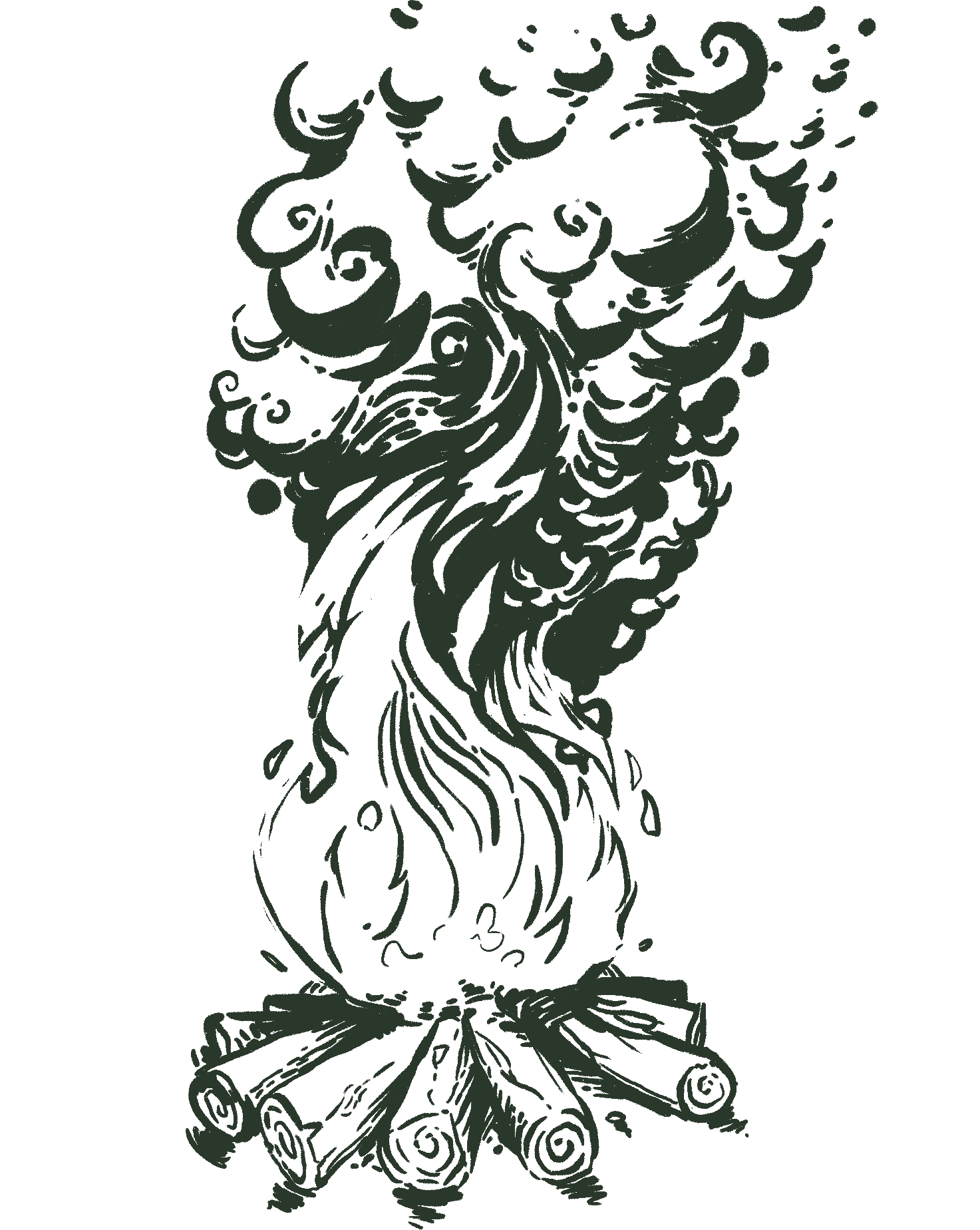
Interlude
The interlude rules are still untested, so some balancing may be needed.
Interlude is the time between expeditions; it's when the characters rest, tend their wounds and plan their next job. Most adventurers do no want to raid tombs and the horrible places, but they have no other choice. While resting in the interlude, the adventurers are actually draining their resources - Blacksalt is not a cheap place to live. Also, be aware that characters can die during the interlude, especially if they are lacking resources.
Playing the interlude depends on how much detail you and your group wants. You can play it unabridged or abridged or even mix both methods and choose what you like from each. If you are unsure, I would recommend trying abridged first, since it's much faster - if you feel it's too simple, try unabridged next time or even roll back and replay that interlude unabridged.
Unabridged Interlude
The focus is Dead Weight in the expedition, but a lot of cool things may happen during the interlude. Playing it unabridged allows new stories to unfold and character development.
Some rules change while not on an expedition:
- There is no decay tracker, but the omens and doom tracker remain.
- The party doesn't need to act as a group anymore and may act independently.
- Every day, the adventurers must consume one ration each, or get the hungry and parched affliction. If they already have the hungry affliction, roll from the decay table.
Abridged Interlude
The time in the interlude is no longer measured in turns, but in days and weeks. The adventurers may spend as many days as they want in the interlude, as long as they have the resources to spend.
Every day has the following steps:
- Blacksalt events
- Player actions
- Hunger Bites
- Sleep
Expeditions count as a whole day, so when returning from one, skip to the sleep phase immediately.
Settlement Size
Settlements are places where the adventurers can rest for a few days, tend their wounds and restock before going back to another expedition. Different settlement sizes have different advantages and disadvantages. For example, smaller settlements usually have less street violence, but are more exposed to external threats.
The sizes are:
- Small Camp: A small encampment with just a few people stationed.
- Hamlet: A few houses, usually with no official government.
- Fief: A small village, some farms and a small castle.
- Stronghold: A fortified castle, with a decent commercial center.
- City: A large settlement, with lots of commerce and crime.
1. Interlude actions
Just like the exploration phase, the interlude has a list of actions that the adventurers can take. Each day, the characters may do 1 action. Actions may have different effects depending on the settlement size. The players should all announce their actions first, and resolve them in any order, but players can't change their actions after they've announced it. Players are encouraged to discuss and plan their actions.
Specific settlements will have extra actions that the players can also choose.
Rest
Take some time to blow off steam and rest. Recover 1 fatigue from each attribute.
You may choose an additional effect:
- Spend 2 silver(size 4-5): Get some proper entertainment, remove angry and hopeless. Recover 1 fatigue from each attribute.
- Spend 1 silver(size 3-5): Get get very drunk, remove terrified and hopeless, recover all presence wounds. On a 2d!, you get nauseated.
- Get some bucolic rest(size 1-3): Recover all intelligence wounds.
Tend Wounds
Use whatever means you have to heal your wounds. Recover one strength or dexterity wound. Remove bleeding.
You may choose an additional effect:
- Spend 4 silver(size 4-5): Visit a surgeon. Recover 2 strength, intelligence or dexterity wounds. Test 1d!; on a success, remove plagued.
- Spend 2 silver(size 2-4): Visit the witch doctor. Recover 2 strength, intelligence or dexterity wounds. Test 1d!; on a success, remove cursed.
- Use a first aid kit: Recover one strength or dexterity wound. Roll 3d!; if triggered, heal 1 wound.
- Time heals all wounds: Roll 3d!; if triggered, heal 1 wound.
Sell
Getting people to buy things is very hard in Trinta, especially in small settlements. When selling something, make a perception test; if you fail, downgrade the rarity of that item for this transaction, then roll its value.
Go shopping
You may buy as many items as you want when shopping. Different settlement sizes will have different items available. To determine if an item is available, roll risk dice. For simplicity, the GM may just say an item is available or not, without rolling any dice.
When buying an item, the price must be rolled. That item price should be noted somewhere, and that item will have that price for all characters until the next interlude. For simplicity, the GM may roll once for all common items, once for all uncommon items and so on. If the group doesn't want to roll for prices, the average price can be used instead.
- Small Camp: Common (2d!), Uncommon(1d!), Valuable(unavailable), Rare(unavailable), Exotic(unavailable)
- Hamlet: Common (3d!), Uncommon(2d!), Valuable(1d!), Rare(unavailable), Exotic(unavailable)
- Fief: Common (4d!), Uncommon(3d!), Valuable(2d!), Rare(1d!), Exotic(unavailable)
- Stronghold: Common (always), Uncommon(4d!), Valuable(3d!), Rare(2d!), Exotic(1d!)
- City: Common (always), Uncommon(always), Valuable(4d!), Rare(3d!), Exotic(2d!)
Go back to expedition
Immediately finish the interlude and get back to the expedition.
Lay low
Adventurers usually call a lot of attention to themselves in the settlements of Blacksalt island. Laying low for a while may help to calm things down and redirect that attention to something else. On a 2d!, reduce this settlement's doom tracker by one.
2. Blacksalt events
Every day in Blacksalt is unpredictable. As a group, roll 1d6 against the event table.
| 1d6 | Effect |
|---|---|
| 1 - 3 | Roll from the bad events table. |
| 4 - 5 | Nothing interesting happens today. |
| 6 | Roll from the opportunities table. |
| 1d6 | Effect |
|---|---|
| 1 | Signs of worse things to come. Advance this settlement's doom and omens trackers. |
| 2 | Bad harvest. All food-related items prices are doubled for 1d6 days. |
| 3 | Attacked by thugs in a dark alley - receive 3 wounds and pay 2d6 silver, as a group. |
| 4 | The sun didn't rise. Everyone takes terrified or hopeless. |
| 5 | Overcrowded. All prices for rent and housing-related items are doubled for 1d6 days. |
| 6 | Prosecution. Advance this settlement's doom tracker. |
| 1d6 | Effect |
|---|---|
| 1 | Unexpected blessing. Reduce this settlement's doom tracker. |
| 2 | Good harvest. All food-related item prices are halved for one day. Stops Bad harvest event. |
| 3 | A naive investor. When selling items, get 50% extra silver. |
| 4 | A calm day. Everyone removes terrified, hopeless or angry. |
| 5 | Empty streets. Housing prices are halved for today. Stops Overcrowded event. |
| 6 | Refreshing winds. Everyone removes angry, shaken or 1 wound. |
3. Hunger Bites
Each player must consume one ration each, or get the hungry and parched affliction. If they already have the hungry affliction, roll from the decay table.
4. Sleep
Depending on where they sleep, a player will have different bonuses and penalties. Each sleep location has a price in silver or resources associated with it. When you choose a location, roll from the appropriate table. Players may choose any available sleeping location.
Also note that not all locations have all options available - a small hamlet might not have an inn available, for example.
In the interlude, if you were to receive an affliction you already have, you must choose another affliction to receive.
On the streets
Sometimes the streets are the only choice.
| 2d6 | Effect |
|---|---|
| 2-3 | You get beaten by some nobles; take 2 wounds, become hopeless or angry. |
| 4-5 | You woke up in the rain; you are now shaken. |
| 6 | You get mugged; pay 2d6 silver or take 2 wounds. |
| 7 | You have a restless night and are sleepy. |
| 8 | You get mugged; pay 2d6 silver or take 1 wound. |
| 9-10 | Restore one fatigue and remove sleepy or shaken. |
| 11-12 | Restore all fatigue and remove sleepy and shaken. |
| 2d6 | Effect |
|---|---|
| 2-3 | You slept in manure and now smell terrible; become angry. |
| 4-5 | You woke up in the rain; you are now shaken. |
| 6 | The locals don't like you here. Advance this settlement's doom tracker. |
| 7 | You have a restless night and are sleepy. |
| 8 | Someone stole 3d6 silver while you slept! |
| 9-10 | Restore one fatigue and remove sleepy or shaken. |
| 11-12 | Restore all fatigue and remove sleepy and shaken. |
Camp (require camping supplies)
Unlike camping in the dungeon, camping during the interlude will not always spend your camping supplies. Regardless, having 1 camping supply for each character is required to camp.
| 2d6 | Effect |
|---|---|
| 2-3 | Your camp was attacked by a wild animal! Receive 1 wound. |
| 4-5 | Your tent finally broke down. Spend a camping supply. |
| 6 | Remove sleepy. |
| 7 | Restore all fatigue and remove sleepy or shaken. |
| 8-10 | Restore all fatigue and remove sleepy and shaken. |
| 11-12 | Restore all fatigue and remove sleepy, shaken and angry. |
Inn (1 silver)
Size 3 or more. Mostly safe and comfortable.
| 2d6 | Effect |
|---|---|
| 2-3 | You have a restless night and are sleepy. |
| 4-5 | Remove sleepy. |
| 6 | Restore all fatigue and remove sleepy or shaken. |
| 7 | Restore all fatigue and remove sleepy and shaken. |
| 8-10 | Restore all fatigue and remove sleepy, shaken and angry. |
| 11-12 | Restore all fatigue, heal 1 wound and remove sleepy, shaken and angry. |
Proper accommodation (special)
Depending on the current story, your character might have a house in this settlement, or maybe someone allowed your character to sleep in a guest room.
| 2d6 | Effect |
|---|---|
| 2-5 | Restore all fatigue and remove sleepy or shaken. |
| 6-7 | Restore all fatigue and remove sleepy and shaken. |
| 8-9 | Restore all fatigue and remove sleepy, shaken and angry. |
| 10-12 | Restore all fatigue, heal 1 wound and remove sleepy, shaken and angry. |
Settlement Doom
Sometimes, the adventurers will advance the doom tracker while they are in the interlude. When that happens, create or advance the doom tracker for that specific settlement. Different settlements can have different trackers, but below, there's a default tracker for most settlements. Note that all effects are cumulative.
| Doom | Effect |
|---|---|
| 1 | The people here look at your group suspiciously. Increase all item prices by 1 silver. |
| 2 | You are not welcome here. The inn charges 1 extra silver per person. |
| 3 | You may only buy common and uncommon items; all item prices are increased by 1 silver. |
| 4 | You may not use the inn. |
| 5 | You may only buy common items; all item prices are increased by 1 silver. |
| 6 | You may not buy items, go to the surgeon/witch doctor or get entertainment here anymore. |
| 7 | The locals will start hunting you down. This is no longer a safe place. |
Character Progression
Unlike most RPG systems, the character progression is not always for the better. As the characters goes on adventures, they can gain experience, gold and better equipment, but they can also lose their sanity and acquire traumas, curses and mortal enemies.
During the expedition or character creation, adventurers may receive insight points. The main way to earn insight is to take actions that impact your character negatively because of your burden.
During the interlude, players may choose to spend those insight points for different things. When you receive an insight point, mark it on your character sheet with a slash. When you spend it, you can fill in the circle. Once all the 12 circles in your insight bar are filled, your character cannot earn more insight and may be retired.
Retired characters contribute to The Guild, allowing players to start new characters with more bonuses and giving them a long-term goal.
The guild is a feature that will be added in a future update of the rules.
Insight points
- Move attribute score (1 insight): You can move 1 attribute score from the hightest scored attribute to a lower one.
- Learn skill (1 insight): You may learn one skill.
- Heal trauma (1 insight): You may remove one trauma.
- Increase lowest score (2 insight): You can add 1 attribute score to your lowest scored attribute.
- Increase score (3 insight): You can add 1 attribute score to any attribute.
- Increase proficiency (4 insight): You can add 1 attribute proficiency to any attribute.
Enemies in the Dark
A list of monsters and enemies can be found in the bestiary book.
Enemies do not have a complete character sheet; instead, they have a simplified one. Let's look at an example:
Freshly Risen Corpse - LVL 2
Wounds: 5, Armor: 1, Movement:5
Ignores morale, never flees, never dodges. Immune to PRE attacks.
Infectious bite(STR 1+1): Causes Plagued on 1d!.
Lunge(DEX 2, Nearby): Moves Close to the target and attack.
Tags: undead
Extract: Necro
Let's break it down. First, the name of the enemy, Freshly Risen Corpse, then its level - level 2 in this case. The level will help the GM to quickly know how powerful this monster is.
Next is the number of wounds this enemy can resist before being knocked out - 4 in this case. After that, we can see how many armor points they have, just 1 here. Finally, we have the enemy resistance, which is the value they will use for reducing any number of wounds they receive.
For tracking the enemy's armor and wounds, you can print this enemy page and fill them as needed, or just use tokens.
Enemy attacks and actions
Unlike player characters, the enemies can't choose from a big pool of actions. Instead, they have all their actions listed on their sheet. Besides that, all monsters also have the following actions:
Move (1 action)
Moves to another tile. The number of tiles that the enemy can move is written on the enemy sheet as the movement score. Cannot move diagonally.
After moving out of a tile adjacent to an adventurer, the enemy must immediately stop the movement.
Recover (1 action)
Remove a stun token from this enemy. If the enemy has one or more stun tokens, this is the only action the enemy can take.
Other actions
In our example, the Freshly Risen Corpse can only move or try the Infectious bite action. Let's review it:
Infectious bite (STR 1+1): Causes Plagued on 1d!.
The notation in front of the action means that this action is an attack, and it works almost exactly the same as weapon notation. The only difference is that the attribute listed is the attribute required to defend instead the attribute required to attack. If our Freshly Risen Corpse enemy tries to bite an adventurer, this would require a strength test from the adventurer to avoid the attack. The enemies cause critical damage when the player character gets a critical failure on their defense. Enemy attacks usually have a special effect described, too. Players may always choose to not roll any dice to avoid fatigue; this will cause the enemy to automatically hit.
Some enemy actions will cause a disadvantage to the attribute test related to them.
Eat (-STR 3+3): Can only be used on a grabbed character.
That minus symbol before the attribute means that the player's strength test will have disadvantage applied, allowing the GM to reroll one chosen die from that roll.
If the adventurer has one or more shield tokens or dodge tokens they can spend them to reroll that many dice of their choosing. They can roll first and spend each token, one by one as needed.
Enemies don't have attributes so they can't make attribute tests - they make an enemy test, If an enemy needs to test for anything, the GM can roll using the monster's LVL value, rolling that amount of dice. It's recommended to avoid making tests for enemies when possible. Enemies do not take fatigue.
Enemies also do not have afflictions, but some of them can bleed. If they are bleeding, roll a d6 on the start of their turn: if they get a failure (1, 2 or 3), they take one wound. Only enemies tagged with living can bleed.
When enemies cause wounds to the adventurers, the player can decide where to place that wound, unless stated otherwise.
For more information on how fighting works, check the combat section.
Taking damage
When an enemy takes damage, they will always resist wounds using their armor. Enemies' armor can break and can't be repaired. Check receiving wounds for a full explanation on how armor works. After rolling the armor test, if the enemy has any resistance points, reduce the wound by that number.
Armor and resistance can reduce the damage to 0, but anything less than 0 is ignored.
Sample Dungeon
Here's a sample dungeon for the players to delve into. Only the GM should read this section, so it's on a separate page - follow this link to access it.
Demons
All magic comes from the void realm, a nightmare plane where all demons come from.
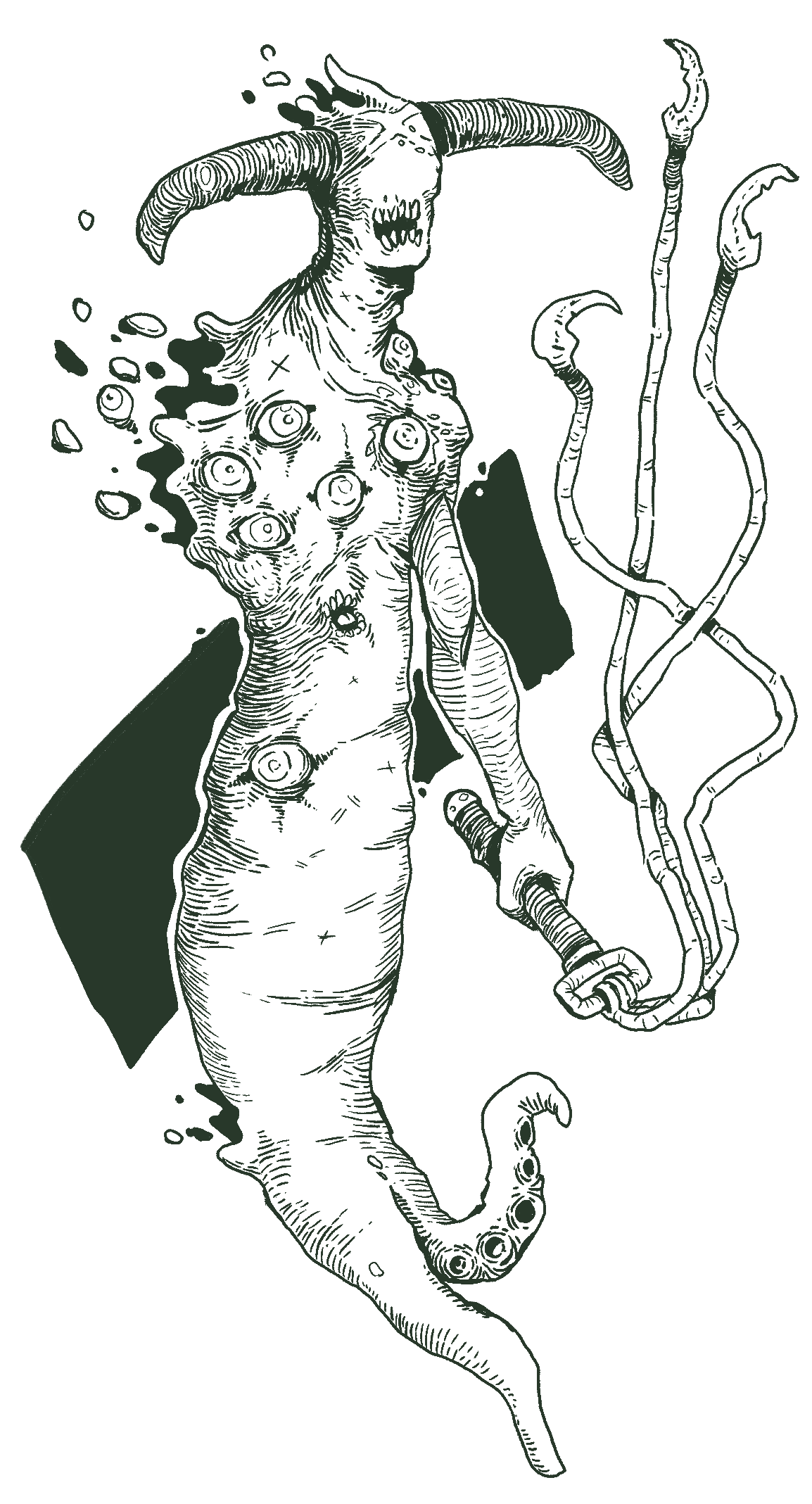
Lesser Demon - LVL 4
Wounds: 6, Armor: 2, Resist:1, Movement:6
Small and fast, add disadvantage to hit.
Void Axe(-DEX )
Bite(STR 2+1)
Tags: ghost, voidspawn
Extract: Flame
Void Demon - LVL 6
Wounds: 9, Resist:1, Movement:3
Terrifying! Cause terrified on hit.
Fly.
Incorporeal, can phase through things, like iron bars.
Void whip(-DEX 2R+1): Binds on hit, blocking move until a Recover action.
Fade: Add one shield and one dodge token. Move somewhere close.
Phase out: Becomes incorporeal, add 2 dodge tokens and move 2 tiles.
Tags: ghost, voidspawn
Extract: Flame
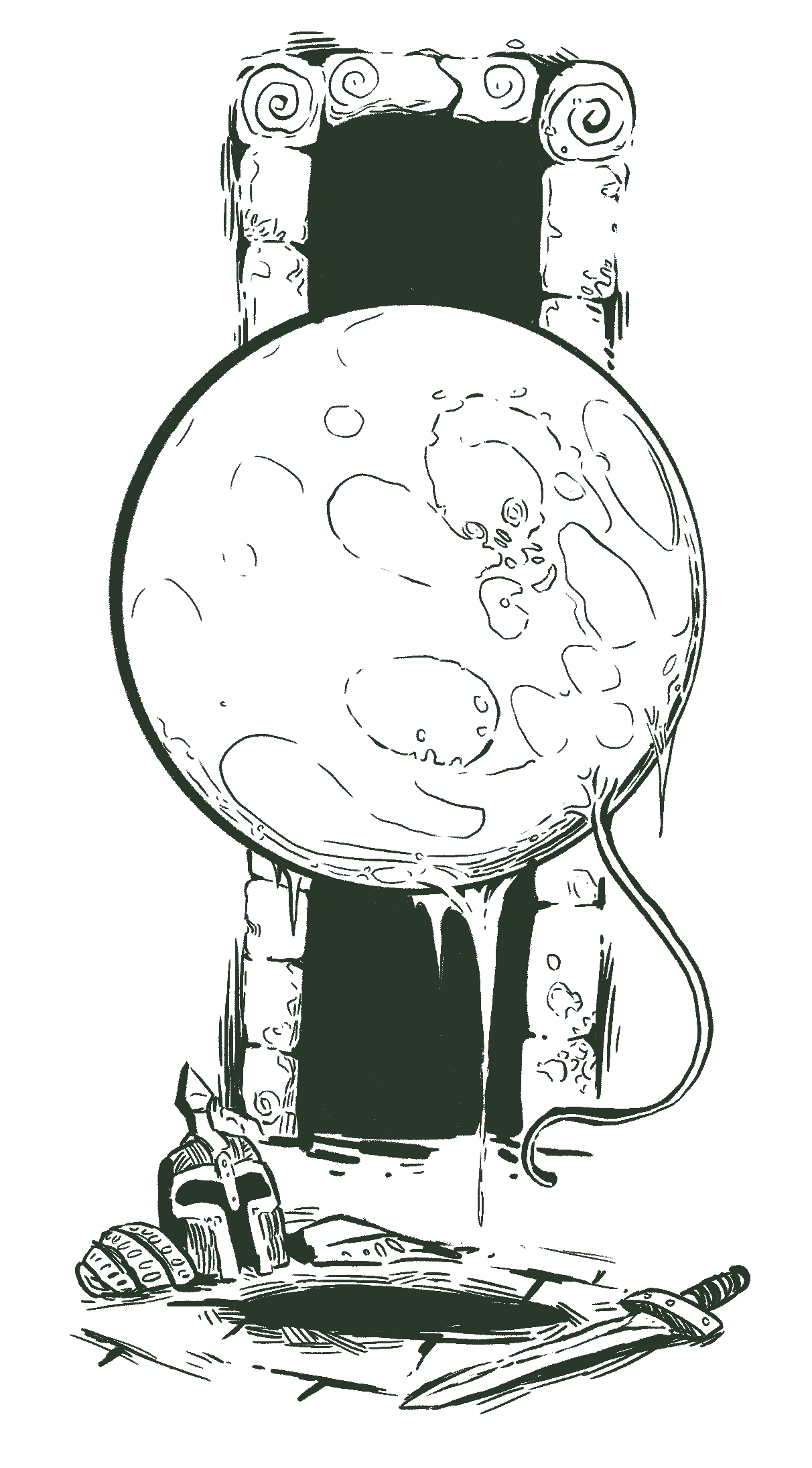
Vault Weaver - LVL 7
Wounds: 12, Resist:2, Movement:3
Fly.
Ignores morale, never flees, never dodges. Immune to PRE attacks.
Consume a corpse: and bloat, becoming a Red Weaver.
Cry of hunger(-DEX 3): (2 actions) Vibrates rapidly causing the ground around to shake. Causes a small earthquake, dropping parts of the ceiling on adventurers.
Piercing light(INT 2P): (2 actions) Flash of light, burns everyone nearby, including other enemies.
Tags: voidspawn
Extract: Ether
Vault weavers are unnatural beings from the void. They are perfectly round balls of faint white light that float around, looking for corpses to consume. A weaver in this state is hungry and will attack anything nearby unless there's a corpse for it to feed upon. It prefers fresh corpses, so it will try injure and capture its victims for eating one by one when it's hungry.
Red Weaver - LVL 8
Wounds: 14, Resist:2, Movement:3
Fly.
Ignores morale, never flees, never dodges. Immune to PRE attacks.
Unnatural presence, everyone nearby is Nauseated while around it. Any ration will spoil and water will become tainted.
Silver Tentacles(STR/INT/DEX 2P): Nearby.
Pulse: A wave of pain, causing 1 Presence wound to everyone Close, including diagonals.
Unblinking Gaze(-INT): Add 2 stun markers to target nearby.
Piercing red light(INT 2P): (2 actions) Flash of light, burns everyone nearby, including other enemies. Add a stun marker to anyone close looking directly at it.
Tags: voidspawn
Extract: Ether
When a red weaver dies it will explode, launching all the corpses it ate all over the place. May cause 1 wound to anyone nearby. The corpses are usually a bit shrunken and dried up. The dead vigil can't set in on a corpse while inside the weaver. While in this state the weaver usually will not attack unless provoked.
The Child-Stealers
The terror of the villagers in the Blacksalt island. They often kidnap babies in the night, turning them into goblins or worse. When angered they will raid villages - kidnapping, killing and eating people. They are also called the forest folk, goblinfolk or just goblins in general.
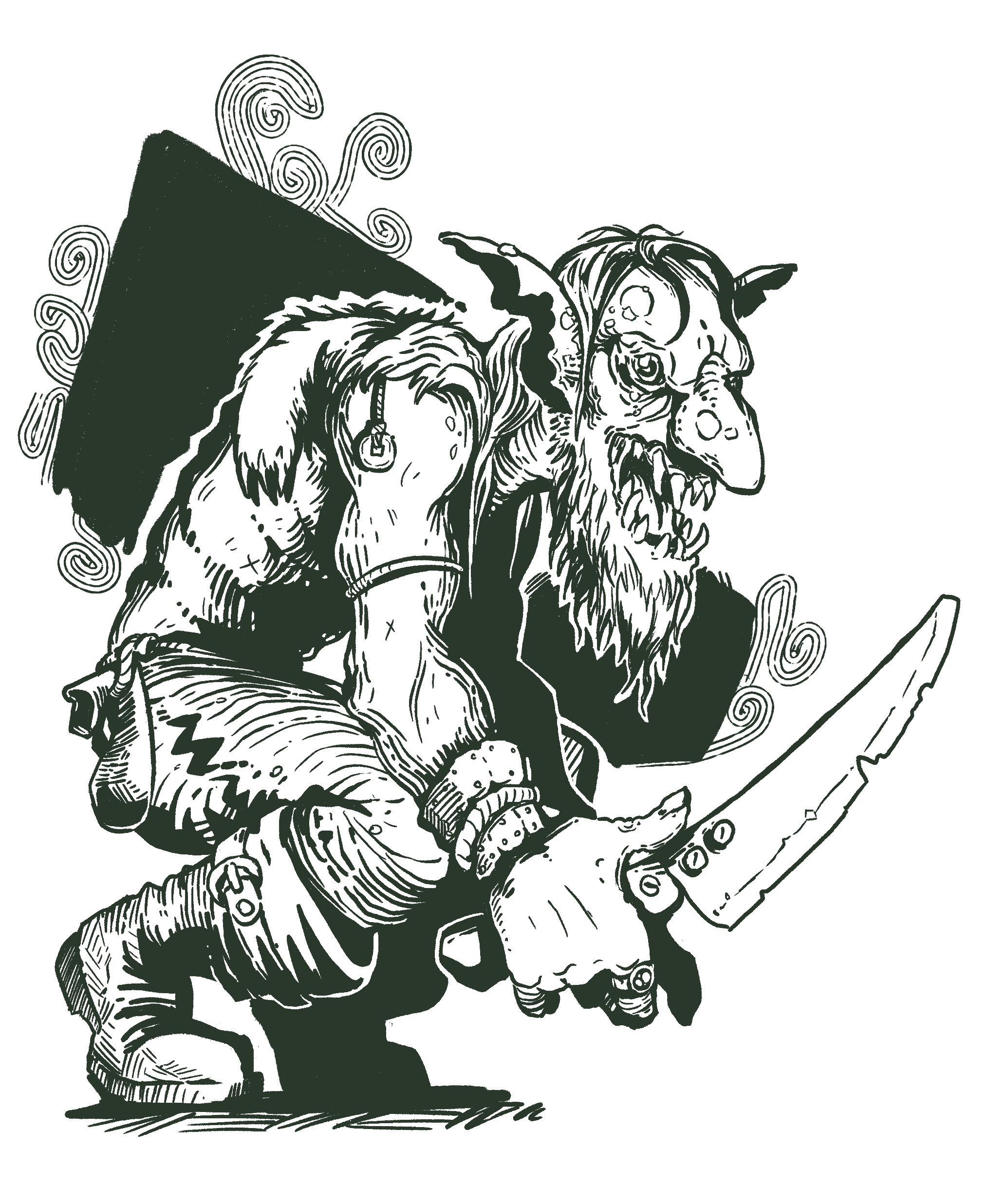
They are usually smaller than humans, with white skin covered in bumps and red spots, pointy ears and sparse hair. They have huge mouths with way too many pointy teeth.
They can't speak properly. Their mouths are too wide and have no proper lips. They also lack social intelligence, but will understand what people are saying and they can say a few broken words. They don't talk to each other much, at least not with words, but will secrete pheromones similar to ants. They are mostly guided by their instinct to create more goblins and gremlins from human children and to eat meat, including human meat. They do trade with each other, though, using human teeth as currency.
Goblin nests are rare and extremely well hidden, but tales are told of them. With their rituals they will turn each human into 6 or even more goblins - with livestock they can make at least 8 gremlins. Every goblin nest has at least one goblin matriarch, a special shaman that releases the spores that turn humans and animals into goblins.
Child-stealers will roam in the night since they can see in the dark. They avoid sun light but it won't hurt them.
Most of them worship Igra, the god of the woods but a few will workship Goshkalon, the god of laughter. They are not evil, but guided by the instinct to reproduce their kind, and the only way to do it is with human children.
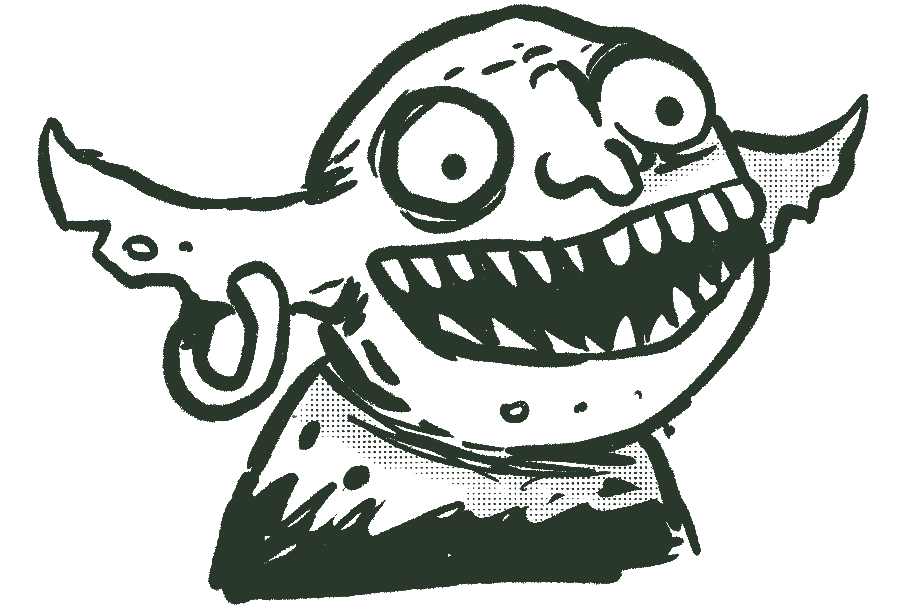
Gremlin - LVL 1
Wounds: 2, Armor: 1, Movement:5
Chew Armor(STR 1): Always destroys 1 armor point.
Tags: living, goblin
Extract: Flame
Gremlins are made from captured livestock, like cows or horses. They have wide mouths and are strangely attracted by machinery and will often eat machine parts, which is actually very unhealthy for them.
If they manage to eat fresh human meat, they will turn into a bugbear
Goblin Scrapper - LVL 1
Wounds: 3, Armor: 1, Movement:4
Knife in the gut(STR 1B+1)
Roll: Move close, add 2 dodge tokens.
Tags: living, goblin
Extract: Water
Goblin Hunter - LVL 2
Wounds: 3, Armor: 1, Movement:3
Short bow(DEX 2+1P): Nearby.
Knife in the gut(STR 1B+1)
Tags: living, goblin
Extract: Water
Boggart - LVL 2
Wounds: 4, Armor: 2, Movement:4
Serrated blade(STR 2+1)
Black shield: Add 1 shield token, may move Close.
Tags: living, goblin
Extract: Water
Boggart is a gremlin that lived for a few years, growing in size. They become furry and animalistic creatures with huge eyes. When a gremlin turns in to a boggart it can no longer turn into a bugbear.
Boggart Sniper - LVL 2
Wounds: 4, Armor: 2, Movement:4
Black Crossbow(DEX 2P+1): Nearby. Requires 2 actions to reload.
Take aim: Causes the next attack to have disadvantage to defend.
Tags: living, goblin
Extract: Water
Bloodshot Goblin - LVL 3
Wounds: 4, Armor: 1, Movement:4
Frenzied! Has 3 actions per turn.
Wall climber, can walk on walls and ceiling.
Serrated teeth(STR 2+1)
Knife in the gut(STR 1B+1)
Unnatural regeneration: Heal 1 wound.
Tags: living, goblin
Extract: Flame
Hobgoblin - LVL 3
Wounds: 6, Armor: 2, Resist:1, Movement:4
Crude falchion(-STR 2+1B)
Death dealer(STR 2): Hits everyone close.
Cracked shield: Add 2 shield tokens, if tokens are used, the shield is gone.
Tags: living, goblin
Extract: Water
Sack Man - LVL 4
Wounds: 7, Armor: 2, Resist:1, Movement:5
Hook pole(STR/DEX 3): Hits diagonally. Hooks on a hit. Target can't move, and takes 1 wound per turn until Sack Man is stunned, killed or decides to release the target.
Unnatural regeneration: Heal 1 wound.
Tags: living, goblin
Extract: Ether
A big goblin with a sack on his back and a big pole with a hook. The sack contains meat for the matriarch and sometimes living captured people or animals.
Bugbear - LVL 5
Wounds: 8, Armor: 2, Resist:1, Movement:5
Rend(-STR 2+2B)
Chew Armor(STR 1): Always destroys 1 armor point.
Tags: living, goblin
Extract: Flame
A feral gremlin that ate fresh human meat, oversized and always hungry. Bugbears are so unstable that even the goblins don't like to have them around and will avoid letting gremlins near human meat.
Goblin Matriarch - LVL 3
Wounds: 5, Resist:1, Movement:1
Toxic spores! Every time the matriarch takes a hit she releases spores in the air, that add one stun marker to anyone close.
Controlling Gaze(INT 0): On hit add a stun marker.
Unnatural regeneration: Heal 1 wound.
Tags: living, goblin
Extract: Ether
A very old goblin shaman that has a special fungus growing on her back. Goblins will immobilize their victims and for weeks will force them to breath the spores and eat the fungus, turning them into goblins and gremlins. Goblins never mourn or feel sad about the death of other goblins, except for the death of a matriarch.
No one knows how a goblin matriarch is made.
Dungeon Scavengers
The dungeon ruins have corpses and rotting things all around. While humans avoid those places, they might just be what some creatures are looking for.
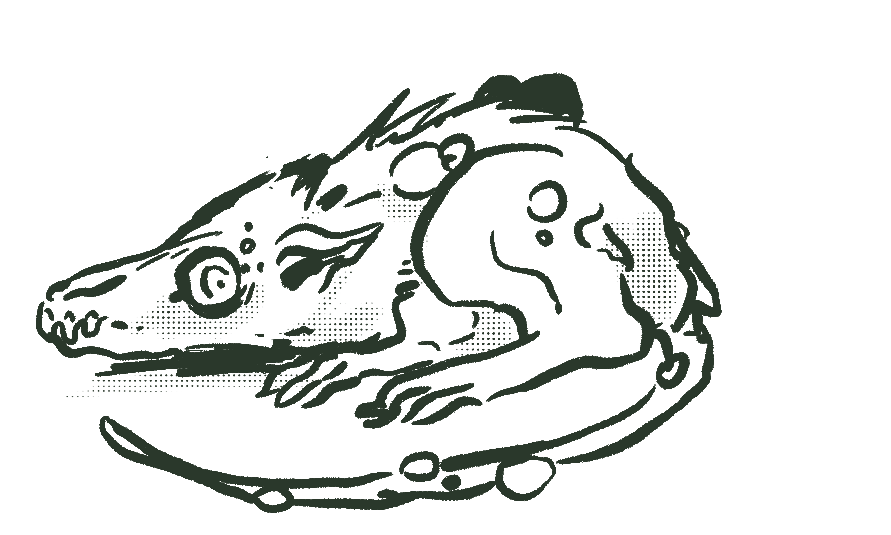
Plagued Rat - LVL 1
Wounds: 2, Movement:5
Small and fast, add 1 difficulty to hit.
Small bite(STR 2+1)
Tags: living
Extract: Rot
Rat King - LVL 2
Wounds: 6, Movement:2
For we are many, any damage is reduced to 2 wounds.
Many bites(STR 2+1)
The cries of many(-PER 1): Hits all adventurers nearby.
Tags: living
Extract: Rot
Giant Rat - LVL 3
Wounds: 5, Armor: 2, Movement:4
Jumpy! If the rat is hit by an attack, it can Move immediately.
Bite(STR 2+1)
Tags: living
Extract: Rot
Bloated Plague Rat - LVL 3
Wounds: 4, Movement:4
Explodes on death! Causing 2 wounds to everyone in the same tile, on a 2d! causes plague.
Venomous Spit(DEX 1): Causes nausea, adding a stun marker on 1d!
Tags: living
Extract: Rot
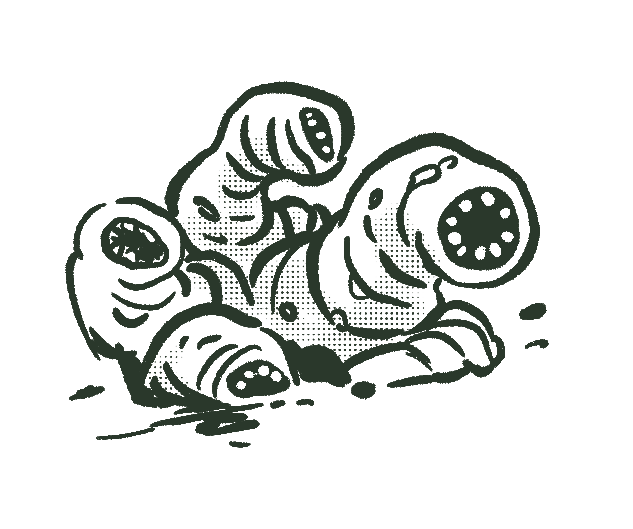
Swarm of Insects - LVL 2
Wounds: 3, Movement:6
Fly.
Swarm! Cannot be harmed by regular weapons, only by fire or spells.
Ignores morale, never flees, never dodges. Immune to PRE attacks.
Drain(-DEX 1)
Tags: living
Extract: Rot
Rotworm Swarm - LVL 1
Wounds: 2, Movement:3
Too many of them, any damage is reduced to 1 wound.
Infest(PRE 1+1): On critical one gets attached to target, causing 1 wound per turn until removed (1 action)
Tags: living
Extract: Rot
Ectoplasmic Worm - LVL 3
Wounds: 2, Resist:1, Movement:3
Immaterial, can move through walls, does not stop when moving out of the adventurer's range, ignores shields.
Soul nibble(INT 2): Add a stun token on hit.
Tags: ghost
Extract: Ether
Shore Creatures
Blacksalt isle shores are full of terrible creatures. Some end up venturing deeper into the land and taking refuge in abandoned ruins.
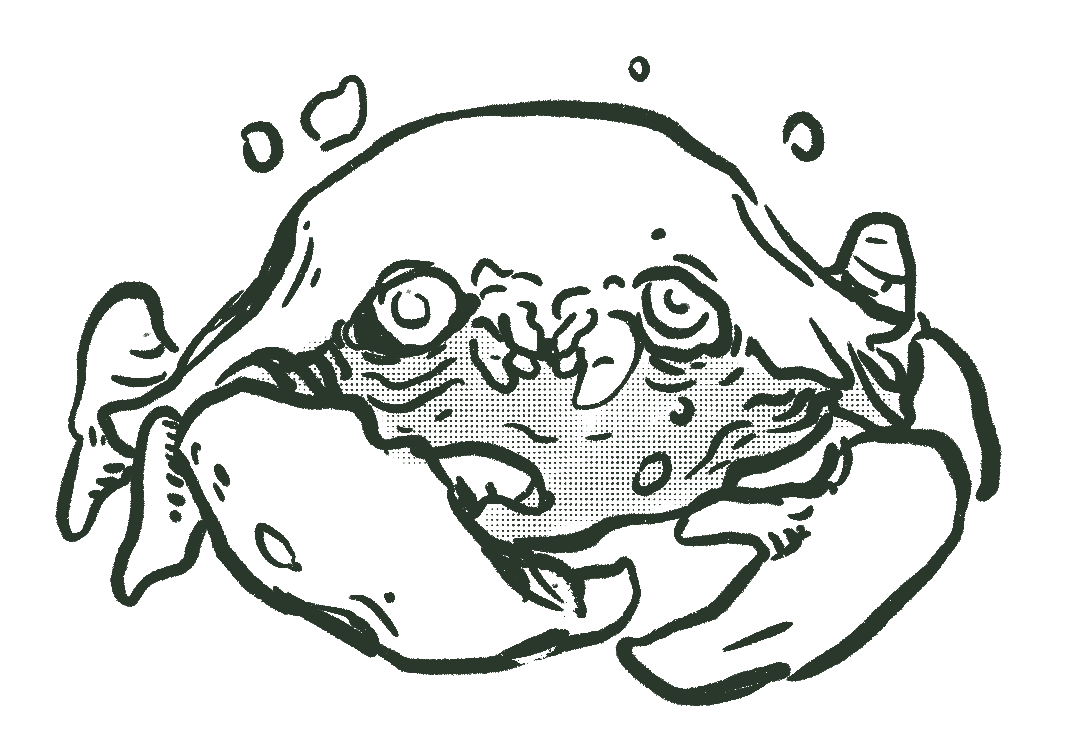
Giant Leech - LVL 2
Wounds: 3, Movement:4
Surprisingly nutritive! Can be cooked in the camp phase as 1 ration. If you eat it become Nauseated.
Bite(STR 2): If causes a wound attach to adventurer. Caused Sleepy. Causes Bleeding until removed.
Tags: living
Extract: Ether
Giant Frog - LVL 2
Wounds: 6, Armor: 2, Movement:4
Sticky Tongue(DEX): On 2d! disarms the target Nearby.
Tongue Whip(STR 2)
Toxic spit(DEX 2): If caused at least 1 wound cause intoxicated.
Tags: living
Extract: Water
Giant Crab - LVL 5
Wounds: 9, Armor: 4, Resist:1, Movement:8
Can't chage direction while moving.
Grab(DEX): Picks up a player character that can now use all actions to test STR to break free or take 1 wound and be immobilized for this turn.
Eat(-STR 5): Can only be used on a grabbed character.
Bash(-STR 2): On hit moves the player character to an adjacent tile.
Tags: living
Extract: Water
Golden Ridge Maneater - LVL 5
Wounds: 8, Armor: 1, Resist:2, Movement:4
Massive bite(-STR 3+3)
Ram: Moves 3 tiles, pushing whomever is in the way in a straight line. Causes 1 wound if hits a wall.
Tags: living
Extract: Water
A big lizard, looks like a fat toothless alligator. Since it's toothless, it swallow its victims whole, using its immense jaw to crush bones with ease.
Not originally from Blacksalt, they brought by travellers from the Golden Ridge, and a few got loose and quickly reproduced, disrupting the ecosystem. They seem to hate humans and will attack on sight, but don't seem to mind the goblinfolk. Goblins quickly took notice of this fact, domesticating and using them as guard lizards.
The Undead
Once human bodies now brought back through the dead vigil.
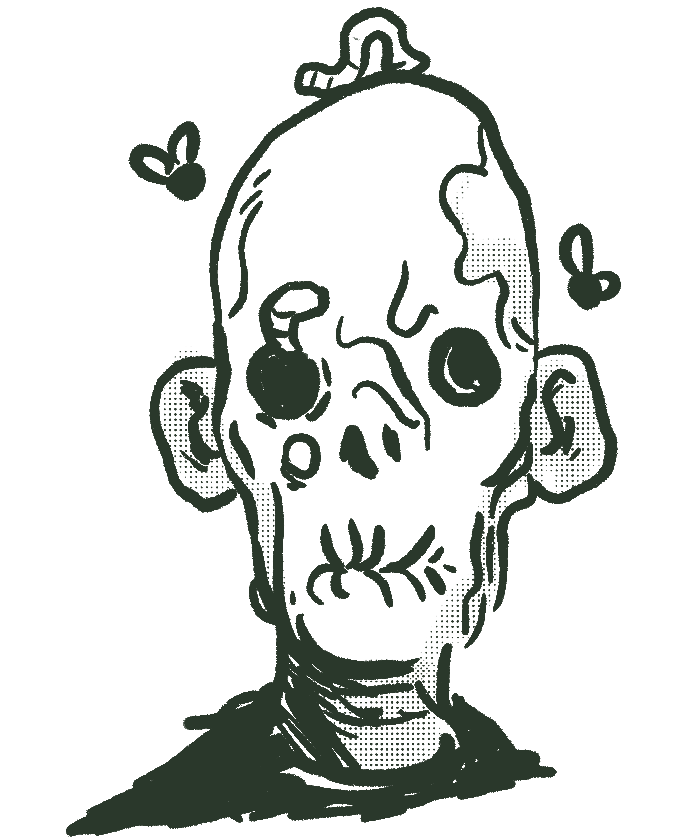
Reanimated Husk - LVL 1
Wounds: 3, Armor: 3, Movement:2
Ignores morale, never flees, never dodges. Immune to PRE attacks.
Crawls, uses 2 actions when moving.
No personal space, doesn't block other undead.
Infectious bite(STR 1+1): Causes Plagued on 1d!.
Tags: undead
Extract: Necro
Shrunken Corpse - LVL 3
Wounds: 3, Movement:4
Ignores morale, never flees, never dodges. Immune to PRE attacks.
Hard to hit! All tests to hit this enemy are made with disadvantage.
Nimble! Ignores combat movement penalty.
Tiny, 2 of them can occupy the same tile.
Throw Shiv(DEX 2)
Infectious bite(STR 1+1): Causes Plagued on 1d!.
Tags: undead
Extract: Necro
Slumbering Corpse - LVL 2
Wounds: 4, Armor: 1, Movement:3
Ignores morale, never flees, never dodges. Immune to PRE attacks.
Pile on! Up to 3 of this type of monster can stack on the same tile.
Infectious bite(STR 1+1): Causes Plagued on 1d!.
Tags: undead
Extract: Necro
Freshly Risen Corpse - LVL 2
Wounds: 5, Armor: 1, Movement:5
Ignores morale, never flees, never dodges. Immune to PRE attacks.
Infectious bite(STR 1+1): Causes Plagued on 1d!.
Lunge(DEX 2, Nearby): Moves Close to the target and attack.
Tags: undead
Extract: Necro
Starved Cadaver - LVL 4
Wounds: 5, Movement:6
Ignores morale, never flees, never dodges. Immune to PRE attacks.
Nibble(STR 2): On a successful attack heal 1 wound.
Feast: 2 actions. Heal all wounds, consumes a corpse and becomes an Unsatiable Dead.
Unnatural regeneration: Heal 1 wound.
Tags: undead
Extract: Necro
Unsatiable Dead - LVL 5
Wounds: 6, Movement:4
Ignores morale, never flees, never dodges. Immune to PRE attacks.
Fast! Add a dodge token every turn.
Overgrown Claws(STR 3+1B)
Tags: undead
Extract: Necro
Rotting Sailor - LVL 5
Wounds: 7, Armor: 2, Movement:4
Ignores morale, never flees, never dodges.
Rusty Sword(STR 2)
Cursed Sea shanty: 2 actions, cause 1 non-lethal PRE wound on everyone.
Tags: undead
Extract: Necro
Bloated Screamer - LVL 5
Wounds: 9, Armor: 3, Movement:1
Ignores morale, never flees, never dodges. Immune to PRE attacks.
Acid pustules! Every time it takes one or more wounds, attack(STR 1) everyone Close.
Agony(PRE 2): Cries with cursed agony, hits everyone alive Nearby.
Tags: undead
Extract: Rot
Ghosts
The dead vigil affects even those that have no corpse left.
Shadow - LVL 4
Wounds: 3, Movement:1
Ethereal! Can only be hurt by magic, prayers or banish undead.
Rotting touch(PRE 2PR)
Tags: ghost
Extract: Ether
Humans
Bounty Hunter - LVL 4
Wounds: 8, Armor: 3, Movement:4
Will to live! Add a shield token when receiving an attack that causes more than 2 wounds.
Short sword(STR 2+2)
Wooden shield: Add 2 shield tokens.
Tags: living, human
Extract: Ether
This page has a simplified version of the tables and lists most commonly used during a session of Dead Weight. If you are unsure about a rule, always check the original tables and list, since they might have a more complete explanation.
Afflictions
| Afflictions | Effect | Getting rid of * |
|---|---|---|
| Hungry | Wounds do not heal. | Eat food. |
| Parched | Cannot recover fatigue. | Drink water. |
| Bleeding | Receive one fatigue point every turn. | Use bandages or some other form of first aid. |
| Sleepy | Can't use extra effort or help friends on tests. | Camp or drink coffee, or receive a wound in combat. |
| Angry | Can't reroll your dice with proficiency. | Drink a cup of tea or hot chocolate. |
| Shaken | Can't use the Catch Breath action in combat or during exploration. | Rest in the camp phase. |
| Nauseated | During combat, you have one less action. | Some potions and tonics. Healed in the interlude phase. |
| Terrified | Rolling a 4 on attribute tests doesn't count as a success. | Drink wine or other alcoholic drink, or defeat a challenging foe. |
| Hopeless | Rolling a 5 also causes fatigue. | Escaping alive from the dungeon or survive a challenging fight. |
| Cursed | Wounds do not heal by resting. Can see ghosts. | Only removed by magic or miracles. |
| Plagued | Coughs constantly. When receiving fatigue, receive a wound instead. | Only removed by magic or miracles. |
| Doomed | When the doom tracker moves, it moves one extra point. | Only removed by magic or miracles. |
* Not exclusive, always check item and spell descriptions for more ways to remove afflictions.
Attack notation
| Symbol | Effect |
|---|---|
| B | Causes the Bleeding affliction. |
| P | Pierces through Armor. |
| R | Can't be reduced, except by armor. |
| N | Non-lethal. Ignore any damage that would kill or mortally wound a character. |
Combat Actions
If the player has one or more stunned tokens, they can only do a recover action until there are no more tokens left.
Attack (1 action)
Choose a weapon and a target. Read the weapon description for any special rules.
Test the weapon attribute to hit.
For each dodge and shield token the defender spends, they may choose a die and force the attacker to reroll it.
Recover (1 action)
You may remove one shield token or dodge token. If you do, also recover one fatigue point from a chosen attribute.
You may remove one stunned token from the character.
Move (1 action)
Move to a new position - the maximum number of tiles is your current number of dexterity die x2. Adventurer's cannot move diagonally. Moving will remove any unused shield tokens, but will keep dodge tokens.
After moving out of a square adjacent to an enemy, the adventurer must immediately stop the movement.
Catch breath (1 action)
Recover one fatigue point for each attribute.
Defend (1 action)
Requires a shield or something that can be used as a shield.
Place the number of shield tokens noted on your equipped shield.
Characters can't have more than 5 shield tokens at any time.
Dodge (2 actions)
Make a dexterity test, place 2 dodge token on a success.
Add another one on a great success on your character.
Cast spell, invoke a prayer or perform a combat maneuver (1 or 2 actions)
Choose an available spell, prayer or maneuver and tests the appropriate attribute specified in the description. Unless specified in the description, this costs 1 action and has close range.
Execute that effect.
Use item or change equipment (1 action)
Equip and/or use an item for its effect.
You can also give or use an item on someone on the same tile if they have inventory space.
Help another (2 actions)
Next turn, an ally will receive an extra dice from you in all their actions; can only be used on allies that are on the same tile, or an adjacent tile.
Check Receiving Help for more information.
Exploration Actions
Move (1 turn)
Move to a different location inside the dungeon.
Loot (1 turn)
Looting a location does not require a test: the GM just lists what they find in that location and the adventurers can choose what to pick up. Looting can only be used in a safe location, with no enemies or traps. If the players want to try something riskier, it's a freeform action, and may require a test.
If the location has a trap, the adventurers may fall for it.
Parley (1 turn)
Talk to someone or something in the dungeon.
Start Combat (1 turn)
Start a combat. The whole combat only counts as one exploration turn.
Catch your breath (1 turn)
Restore up to one point of fatigue for each attribute. Players may also choose to use any items tagged as quick, too, such as bandages, light torches and drink water.
Look for traps (1 turn)
Looking for traps requires the infiltration skill, and an explanation of how they look or at least some kind of tool, like a pole.
Use a quick item (free)
Any item tagged as quick can be used without using a turn.
Use a slow item (1 turn)
Each character can use one item that is tagged as slow. Items tagged as camp cannot be used.
Cast a spell or prayer (1 turn)
Choose an available spell or prayer and perform the appropriate tests specified in the spell or prayer description. Execute that spell effect.
Freeform (1 or more turns)
It allows the adventurers to do pretty much anything they want and require some improvisation of the GM. Freeform actions usually involve interacting with the ambient, creative thinking and solving puzzles.
Set up Camp (1 turn)
Starts the camp phase.
The whole camp phase counts as 1 exploration turn.
Take a free action (free)
Some actions will not trigger a turn.
- Players may rearrange their adventurer's equipment, equipping and un-equipping items.
- Adventurers may use any item tagged as quick.
- Snuffing out torches or other equally simple actions.
- Talk to each other.
Camp
Setup
- Add 1 action if the adventurers are camping in a dry and stable place.
- Add 1 action for each camping supply item used.
- Add 1 action for each adventurer with the survivalist skill.
- Add 1 action if the players decide to make a fire. It requires a camping supply or firewood.
- Add 2 actions and advance the doom tracker if the players decide to take a long rest.
- Subtract 1 action if the location is particularly filthy or unhealthy. (Cold, flooded, littered with corpses, etc.)
Camp Actions
Keep a lookout (1 actions)
Remove 1 ambush dice.
A well deserved rest (1 actions)
Recover all of the party's fatigue points.
Removes the Shaken affliction.
Un-exhaust all prayers.
Use items (free)
Adventurers may use as many items tagged as Slow or Quick as they want.
Use camp items (1 action)
Each adventurer can use one item tagged with Camp for its effects.
Cook some food (1 action)
Cooking, different than other items has an special action, and requires a fire and at least one camping supplies to have been used during this camp.
When cooking one ration can feed 2 adventurers. If someone has the cooking skill one ration can feed 3 adventurers.
A regular ration will remove both the hungry and parched afflictions. Regular rations can also be consumed raw, feeding only one adventurer, with the use item action.
When using special ration, the ration will not remove the hungry affliction, but may cure other affliction instead. Special rations will also remove the parched affliction.
- Tea or hot chocolate removes teh angry affliction.
- Coffee removes the sleepy affliction.
Memorize spells and prayers (1 action)
Wizards and Clerics may memorize and forget spells and prayers.
Sleep (2 actions)
Recover all fatigue points of the whole party. Removes the Sleepy and Shaken afflictions. Everyone heals 1 wound.
Un-exhaust all prayers.
Add 1 ambush dice.
Skills
- Animal Affinity: You have advantage when testing for anything that involves taming, understanding or tracking wild animals.
- Beastmaster:(advanced) You have advantage for anything that involves fighting, taming, understanding or tracking animals. You have a pet that follows you around (medium ally).
- Ward the dead: May perform a ritual using 1 exploration turn to ward the dead vigil from setting inside a circle with 1 meter radius. Does not affect anything that the dead vigil has already set, only stops it from happening.
- Cooking: Each ration can feed an extra adventurer in the camp phase. You get 1 free ration at the start of the interlude.
- Master Chef:(advanced) Each ration can feed two extra adventurers in the camp phase. You get 3 free ration at the start of the interlude.
- Crafting: You have advantage when testing for crafting things. During the camp phase you can repair 2 points of armor automatically.
- Duelist: You may perform a feint action in combat (1 action). Discard all shield and dodge tokens from your enemy.
- Swashbuckler:(advanced) If your feint removes a shield token, your opponent may not attack next turn.
- Fearless: Once per combat you may heal one presence wound.
- Haggle: During the interlude you can re-roll the price of an item once. You must use the new result.
- Trade network: During the interlude you can re-roll the price of an item once. You must choose to use the new or old result. You may also reroll the item availablilty roll once.
- Holy Rites: You have an extensive knowledge about the new gods, prayers and the saints. You may make holy water using clean water and 1 exploration turn.
- Infiltration: Allows the search for traps action without proper tools during expeditions and an advantage when sneaking.
- Intimidate: You may perform an intimidate action in combat (2 actions), attacking with PRE 1N all nearby enemies. Only one intimidate action can be used per combat.
- Loremaster: You have an extensive knowledge about the world history, languages and different cultures.
- Pilfer: You earn 1d6 silver coins at the start of the interlude.
- Occult Studies: You have an extensive knowledge about old gods, magic and the occult.
- Ritualist: During camp you can spend 1 action to remove one point the omens tracker or doom tracker.
- Shield Expert: Add 1 extra shield token when defending.
- Shield Master: (advanced) Add 1 extra shield token when defending. Moving does not remove shield tokens.
- Stalker: Before combat, if undetected by an enemy you have a free critical hit.
- Street Wise: You do not get robbed in the interlude and you have one extra daily action. You may reduce the price of common items by 1 silver (to a minimum of 1).
- Surgeon: During the camp phase you may perform an Intelligence test to heal one wound of each character in your group.
- Survivalist: 1 extra proficiency point for anything that involves surviving in the wilderness. Adds 1 extra camp action.
- Slippery: You may spend dodge tokens during the enemy turn to move one tile.
- Veteran: (1 explorer action) Test presence, on a success you will know how much doom this location currently has and how much doom is required to trigger the next step.
Weapon and armor use depends on the character arsenal skill. Using an equipment without the proper skill all tests you make are made with disadvantage.
- Weapon master: Can use any weapon or armor.
- Basic weapon training: Can use one handed melee weapons, any staves, any ranged weapons and leather armor.
- No weapon training: Can use only small one handed weapons, any staves and no armor.
Special Traits
- Berserker: During combat, ignore strength fatigue and wounds when rolling tests. You still take wounds and fatigue normally, and so your character will collapse in exhaustion if your available dices go lower than zero.
- Bad omens: Every time you have a critical fail on a test, advance the omens tracker.
- Battle trance: Every time you kill an enemy you get an extra action.
- Cold blood: You may back-stab enemies that are engaged in combat to another character or distracted, for that you may use Dexterity to hit with weapons that would require Strength. Enemies can't use resistance to reduce your damage and you cause one extra wound.
- Divine mandate: You may cast prayers. You require a holy symbol and to have previously memorized them. Check the prayers section for more information.
- Hardened: When receiving wounds from an attack, you may test strength, on a success, resist 1 wound. On a great success resist 2 wounds.
- Magic user: You may invoke spells. You require a magic conductor and to have previously memorized them. Check the spells section for more information.
- Rejected by death: If your character would get mortally wounded, roll 2d!, if triggered, ignore the mortal wound.
- Dauntless: When you get a success on a test, you may roll 2 extra dice and add them to this test. This increases your great success and fatigue chance.
- Third eye: You can see the omens tracker.